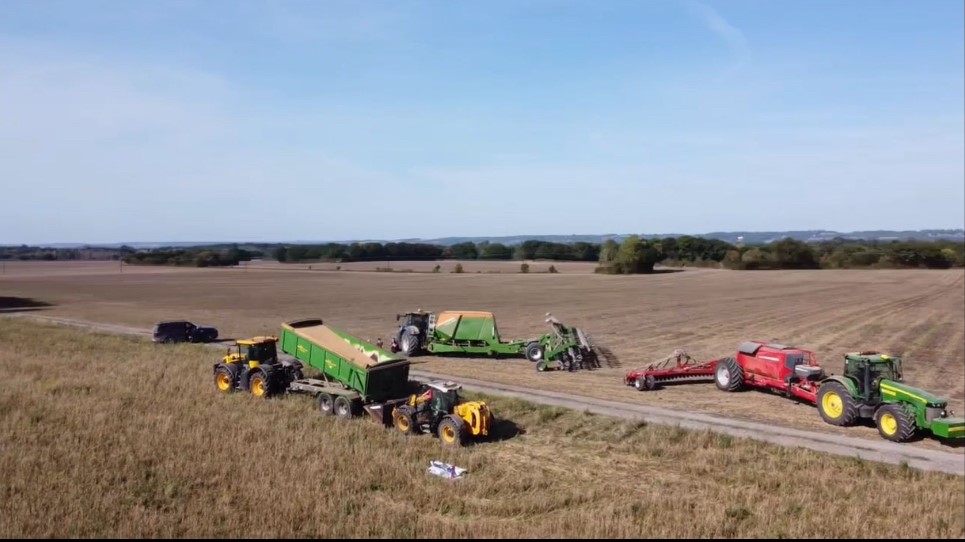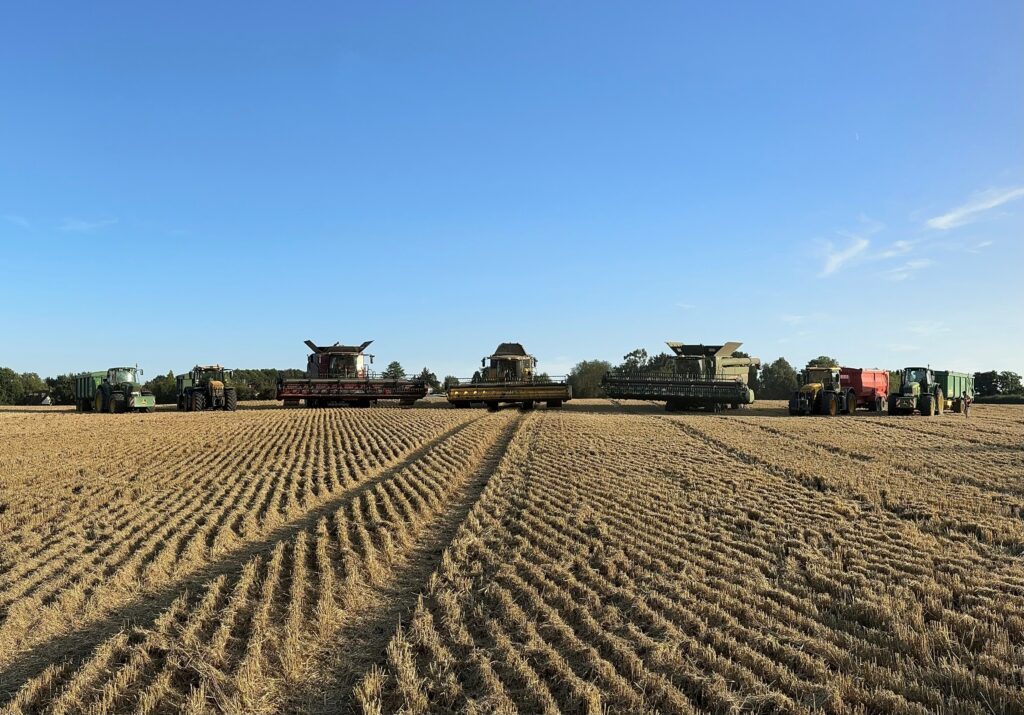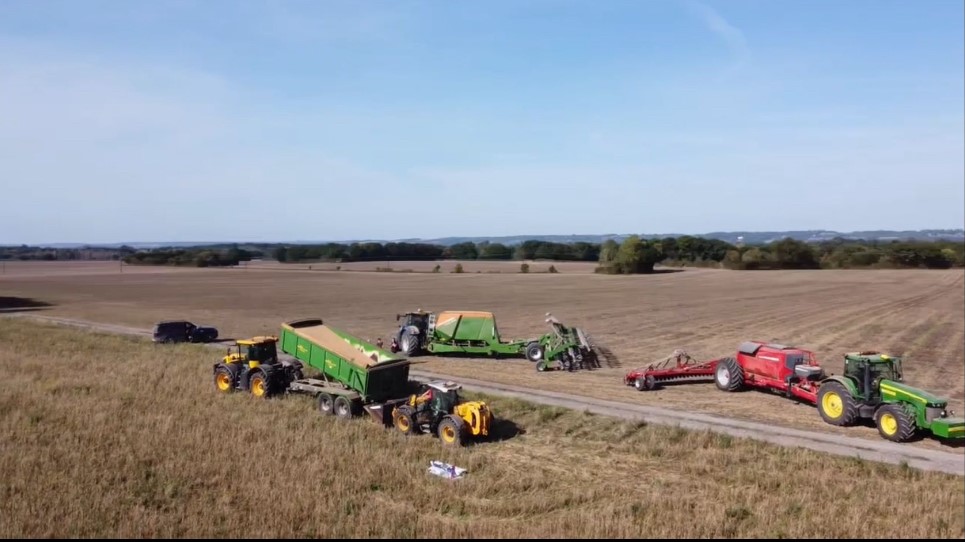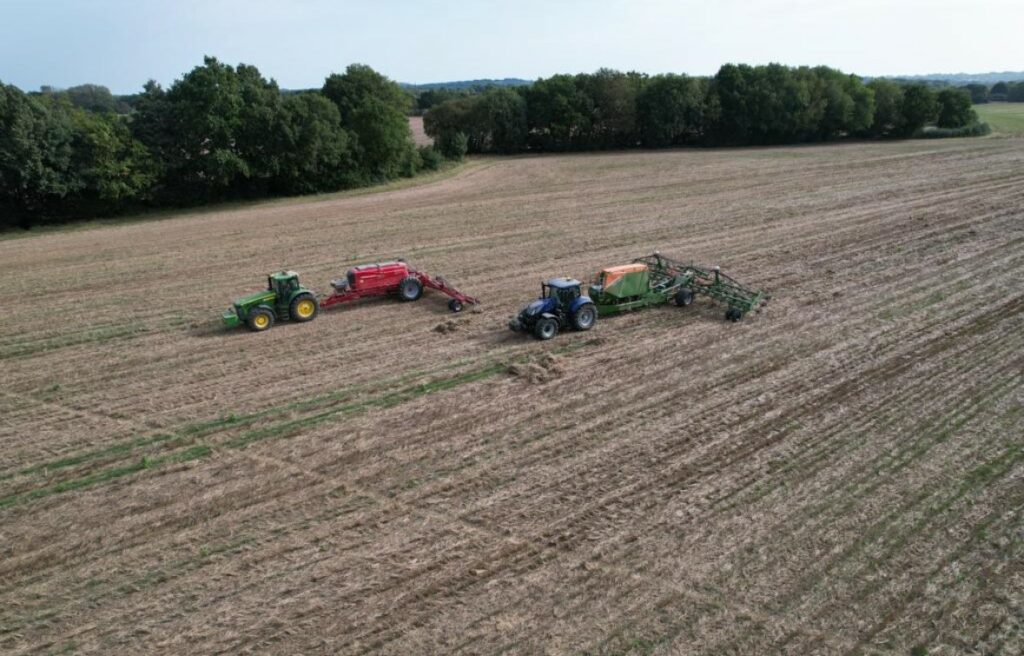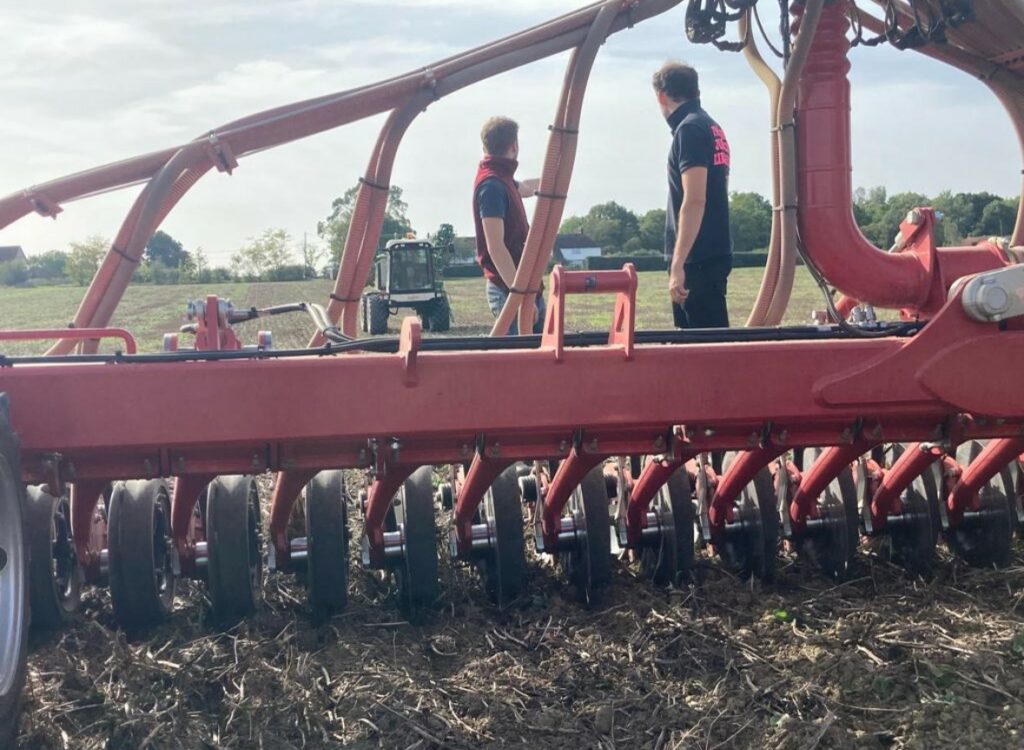If you would like a printed copy of any of our back issues, then they can be purchased on Farm Marketplace. You can also download the PDFs or read online from links below.
-
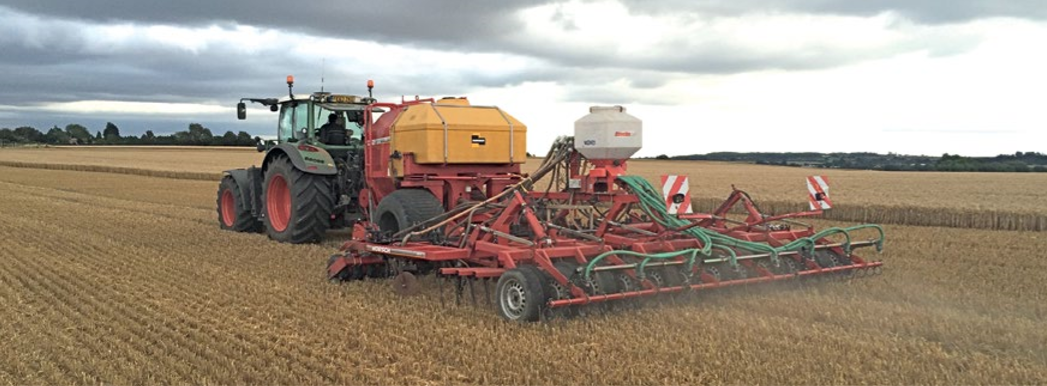
How To Start Drilling For £8K
Clive Bailye’s seed drill of choice is his 6m John Deere 750A , which has been used exclusively for 3-4 seasons. Last year, with an increased acreage, the founder and publisher of this Direct Driller magazine thought a second seed drill was necessary. Having just the one machine was a risk and in a difficult season would mean drilling was delayed. He looked around and found a good condition Horsch CO6 tine drill advertised in Germany.
Words and pictures by Mike Donovan
After delivery he rebuilt the coulters to a narrow profile so as to reduce soil disturbance. He says the tine drill is very useful driling after straw crops such as osr and also through the straw on second crop cereals.
Buying the drill from a German farmer was not particularly complicated, and provided him with a higher spec machine than Horsh sell in the UK. The seed dart tyres are much wider, and the machine is fitted with blockage monitors as well as full width front packers and also a liquid fert application system.
A sheaf of photos were taken, and Clive then asked for some of specific parts to show wear. The deal was done at under £5,000 which Clive says is the market value of these machines which are too large for small farmers to buy. Original owners like to buy new and sell when the machine is still in good condition.
Narrow tines with wear tiles
@Clive knew he wanted to make changes, substituting the Horsch tines and coulters for something far narrower, and has ended up getting his own design of tine made, which has a wear tile made from Ferobide, far harder than tungsten. The drill is on the farm primarily for osr and 2nd crop cereals drilled into chopped straw and the 25cm spacing is okay for these crops.
Comments on Clive’s on-line forum, TFF, said the drill many not be so good with beans, as the slot is a mere 12mm wide. And in barley the spacing may well be too wide as it needs to be thick. Clive points out that the seed pipe can actually be a bit wider than 12mm as it is in the shadow of the point. It would be good to have the option of using it for beans.

Above left: The cheap CO6 is being calibrated ready for its first outing

Above right: The adapted Horsch is being filled by the home built drill logistics trailer with seed and liquid starter fert.
Getting around the German instructions
The Horsch came, of course, with a control box and instructions in German. More on-line discussion revealed that English instructions were available on the Horsch website, and another explained that Horsch was sourcing some of these parts from Agton in Canada anyway. Zealman from New Zealand explained that the button marked with callipers should be held down for around 5 seconds. The menu is where you adjust the tramline sequence, valve layout and row numbers.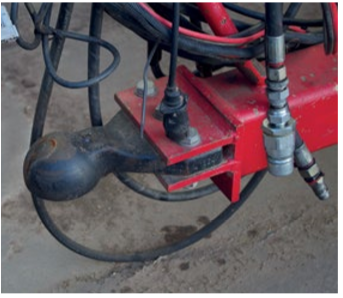
Ball hitch is a continental standard and provides a positive connection between tractor and drill

The Stocks Wizard has a rotor modified for Avadex which otherwise leaks everywhere
A Stocks Wizard is on the back of the drill and used for Avadex. Here again the knowledge of actual farmers is helpful. Alistair Nelson warned that the rotor and the surrounding shroud need to be changed, and he got good advice “from Rick at Stocks”. Clive has the same setup on the 750A and says that the Avadex leaks everywhere unless the modification is made. The drill was acquired and modified in 2016 and the results have been excellent.
The machine went through the residue without many problems and having the second drill has meant more timely planting. Clive has shown that moving into No-Till is not the expensive exercise so many farmers think it might be. The total cost, after modifications which included replacing all tines and coulters, was under £8,000.
Author Mike Donovan writes: we have featured a number of home made direct drills in @Practical Farm Ideas, and are always interested in seeing more. Please contact mike editor@farmideas.co.uk or 07778877514.
-
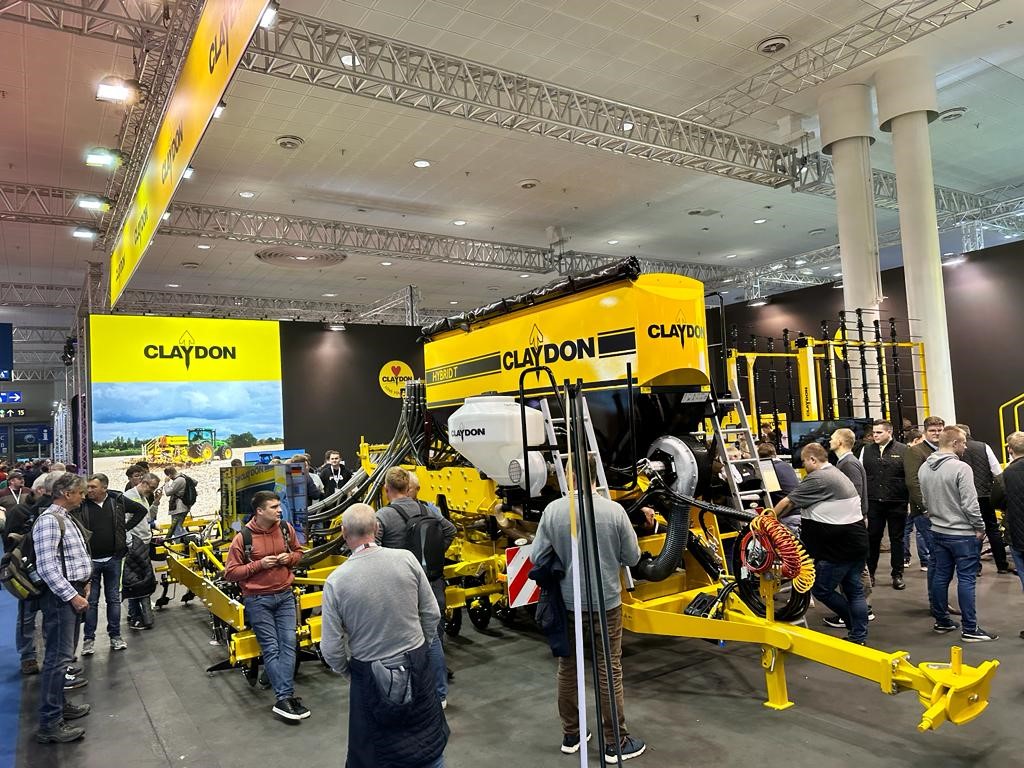
Relentless rain creates significant challenges
This year’s numerous challenges continued into autumn on the Claydon family’s arable farm in Suffolk, writes Jeff Claydon, who invented the Opti-Till® direct strip seeding system.
Date: 27 November 2023.
What a difference a year makes! I started my last article for Direct Driller, written on 29 August, by suggesting that further agronomic, meteorological, political and economic headwinds would likely continue to test our resolve in the months ahead. They have certainly done that! Between New Year’s Day and when we finished harvest, a stop-go affair which promised much but was ultimately unexceptional, the total rainfall amounted to 436mm. The year-to-date figure has now reached 840mm!
What a contrast this autumn had been compared to last, when it was so dry post-harvest that getting weed seeds and volunteers to chit in the hard, parched soils was difficult. Because of this, and in common with many farms throughout the country regardless of the establishment system used, we saw more grassweeds in standing crops, requiring intensive stubble management.

Fortunately, meaningful rain after the combine had done its job created the ideal conditions for our Claydon Straw Harrow, an implement I often compare with a telescopic handler; you don’t see the need for one until you have one, then you wonder how you ever managed without it.
We went to work with the Straw Harrow immediately behind the combine and in the following weeks carried out five or six passes across the farm. That knocked the stuffing out of weeds and volunteers, as well as severely limiting the life of any slugs in the chopped straw. On 12 October glyphosate was applied to kill the remaining green material, but almost immediately the heavens opened, dropping 60mm of rain.
The first winter wheat went in on 15 October, albeit under slightly damp conditions, and over the next three days we established 75 per cent of the planned area using our 6m Claydon Evolution M6 drill. Particularly good progress was made until the door of opportunity was slammed rudely in our face by heavy rain on the night of 18 October. Over the next three days 93mm fell, followed by an average of 10mm every day for the remainder of the month. A further 60mm during the first three days of November simply compounded the problem. It just goes to show that however much you plan Mother Nature always has the last word.
So much rain falling in a short period made the application of post-emergence herbicides more difficult on our very heavy Hanslope series soils, but at least we were able to do it. The task was only possible because the firm, supportive soil structure left behind the Claydon drill allowed our self-propelled sprayer to travel virtually unhindered. However, it remains to be seen whether product efficacy has been impaired.
BUOYANT ATMOSPHERE AT AGRITECHNICA

The busy Claydon stand at Agritechnica 2023 Agritechnica 2023 in Hanover, Germany from 12 to 18 November was the first since 2019, the planned 2021 event having been cancelled due to ongoing Covid-19 restrictions. Attracting over 470,000 visitors, this mind-boggling display of agricultural technology has to be experienced to be believed.

Slug pellets were not used last autumn because the weather was extremely dry. That turned out to be a mistake, so this season Jeff applied them at drilling, with excellent results. There is significant cost involved in exhibiting at the world’s biggest agricultural show, from stand space, stand builders, catering, hotel, to travel and subsistence costs for all the Claydon team, but the investment is certainly worth it in terms of sales, contacts made and market awareness. With my eldest son Oliver at the wheel of his hybrid vehicle we headed to Hanover in an environmentally friendly fashion. Driving from Suffolk to the Channel Tunnel we couldn’t help but notice that the whole of southern England looked wet and drab, a theme which would continue in Europe.
Travelling through France, Belgium and Germany things didn’t get much better. Wherever we went 25 per cent of the land appeared to be waterlogged, the emerging crops barely visible above flooded land which resembled paddy fields. Those images left us thinking that this could have severe implications in terms of crop yields and prices in the months ahead. Feed wheat is currently circa £180 per tonne and oilseed rape £360/t, suggesting that no-one is seriously considering how much less farmers across much of Northern Europe might be harvesting in 2024.
Claydon was one of the few British companies exhibiting at Agritechnica and because, collectively, our staff speak many languages we were able to talk to most visitors in their native tongue. Amongst them were some from Bulgaria where, ironically, the weather had been remarkably dry.
The show was buzzing and over seven days the Claydon team welcomed happy customers from all corners of the world, many of whom have been using our Opti-Till® system for many years to successfully establish the widest range of crops quickly and efficiently in all types of terrain, soils and conditions.
Agritechnica 2023 featured a massive choice of equipment dedicated to the apparently simple task of establishing arable crops and it would be possible to spend a vast amount to do that. But why would you, especially at a time when combinable crops prices are significantly below where they should be to support a thriving farming industry?
Avoiding the complexity, excessive weight, high capital cost and substantial on-going running costs of many other methods, Opti-Till® delivers excellent results, very cost-effectively. Numerous customers to our stand at Agritechnica advised us that they are operating Claydon drills for €3 to €4/ha in wearing metal costs and that is much, much lower than many other systems.

The Claydon Straw Harrow again proved its worth this autumn as five or six passes eliminated most volunteers and weeds before glyphosate was applied two weeks before drilling. Given its proven benefits and low operating costs the Straw Harrow represents excellent value, and generally all that’s needed is to follow it with a Claydon drill, which also has extremely low running costs. The advantages of Opti-Till® obviously resonated with those wanting a simple, practical approach. We took hundreds of enquiries from farmers in 34 countries, many of whom are looking to change the way they establish their crops, for a host of reasons.
One of the key themes at Agritechnica was in-crop weeding, particularly inter-row hoeing. I recall being very sceptical when, a decade or so ago, my cousin David suggested that we should consider developing an inter-row hoe for use in strip seeded cereal crops. The reduction in herbicides availability and effectiveness are just two reasons behind the success of the Claydon Terra-Blade which we developed. A simple, low-cost implement, it is highly effective at removing weeds between the rows in cereal crops up to and including Growth Stage 31.

Weeds, such as blackgrass, are easily removed at the cotyledon stage using the Straw Harrow. I was amazed to see the range of equipment available in this sector but taken aback by the high price tags and complexity of some of it, largely reflecting customer demand for it to be self-steering. Claydon have developed and comprehensively evaluated self-steering inter-row hoes and we appreciate that they may have advantages in certain situations. However, we discounted any commercial development because their much greater complexity means that such products would be much more expensive, cost more to maintain and possibly be less reliable.
Claydon’s goal is to produce simple, effective, cost-efficient equipment which will reliably fulfil its intended purpose for many years. These attributes are becoming increasingly important as farming businesses look to keep machinery for longer to amortise the increasing capital cost over a longer period.
Having used a manually steered 6m Claydon TerraBlade to hoe thousands of hectares of cereals on our own farm over the years I can vouch for the fact that it does the job efficiently, effectively and reliably, with none of the drawbacks of far more costly and complex alternatives. However, there are some customers who would like to see guided self-steering hoes, so our engineers will be looking to offer this option going forward for those prepared to invest the extra cost.
EXPERIMENTING WITH DRILLING TIMINGS
On the return journey from Hanover to Suffolk the countryside was still as wet as it had been when we left. Therefore, it was with some trepidation that on my first day back home I drove around the farm to look at our crops.

As an experiment, some oilseed rape was drilled in mid-September to see whether it would avoid the flea beetle, but in mid-November some damage was evident and the crop significantly less advanced. Having been incredibly nervous about sowing oilseed rape immediately after harvest following painful experiences with cabbage stem flea beetle damage in recent years, I was pleased to see most of it looking extremely well; let’s hope it stays that way!
Cabbage stem flea beetle has caused a small amount of damage, but nothing excessive at present, so we will continue to monitor that situation closely. In the meantime, grassweeds have been taken out with Centurion Max and we await some dry weather to apply Kerb®. Hopefully, the crop will be much cleaner this season, although with oilseed rape currently £360/t it is not particularly viable from a financial standpoint. But what’s the alternative as there are no outstanding contenders out there at present?

Winter wheat being sown with the farm’s 6m Claydon Evolution drill just before heavy rain fell in mid-October. As an experiment we drilled an area of oilseed rape in mid-September hoping that it would avoid flea beetle attack, but the jury is still out on whether that approach will work. Some damage is evident, it is way behind that which was sown in August and looks very vulnerable.
Another interesting experiment we are trialling is in the Bio sector. There are so many companies experimenting with Bio products and many on offer, from some offering microbes to improve soil health, etc. We are currently using a natural product that encourages the biome in the soil, providing many health benefits, improving fertility, friability and the ability of the soil to withstand the weather events which we are experiencing. After our first-year trial in 2023 it looks promising, so we will continue to evaluate it in 2024.

The Claydon farm continues to experiment with strips of cover crops to assess whether they provide any benefits. This season, largely because wet weather curtailed autumn drilling, we will be growing more spring oats than ever before, but the crop is also significantly less risky than oilseed rape. In preparation we have Straw Harrowed stubbles up to six times to take out germinating volunteers and weeds at the cotyledon stage and any green material will be sprayed off before Christmas. This is important because over-wintering blackgrass seems to have a toxic effect on the soil and subsequently a detrimental effect on crop performance. The land will be left to rest over the winter, then another dose of glyphosate will go on in the spring just before drilling.
Catchy weather at harvest meant that field operations inevitably caused some surface compaction, although this was minimal by most standards due to the supportive nature of our direct drilled soils. Importantly, the leading tines on our 6m Claydon Evo drill remove this ahead of the seeding tines, so seed goes into ideal conditions and grows rapidly.

The few small areas of the Claydon farm where excessive moisture held crops back will benefit from additional drains in the spring. Winter wheat established in October before the onset of relentless rain looks good and is significantly more advanced than where we experimented with slightly deeper drilling to avoid the emerging crop potentially being affected by pre-emergence herbicides. Did we make the wrong decision in doing that and will we need to reconsider whether that approach was correct? Time will tell.
Most of our land is well drained, but I am pleased we took the opportunity presented by ideal weather in early October to mole 40 hectares where water had been slow to get away. That, combined with the effect of the Claydon drill’s leading tines, has been enormously beneficial in terms of allowing water to move from the surface down to the laterals. Exceptional rainfall since then has highlighted a few small areas elsewhere where excessive moisture is holding crops back, so we will attend to those next year and have already booked our drainage contractor for the spring.
In my next report I will let you know how our autumn-sown crops are faring following the winter and outline our plans for spring drilling.
The Claydon website (claydondrill.com) galleries contain numerous videos on soil health and resilience, as well as showing the Claydon Opti-Till® System being used to establish all types of crops, in all situations, both in the UK and overseas. You can also keep up with the latest posts, photographs, and videos from Claydon and its customers through the Claydon Facebook page www.facebook.com/Claydondrill




-

High-performance prebiotics
Nutrigeo L® and K1® at the heart of a scientific publication
Written by Mark Shaw from Gaiago
Nutrigeo L® and K1®, two soil biostimulants marketed by the company Gaïago, have shown, under controlled conditions, an agronomic interest for growing corn in loamy soil. The results of these trials are detailed in an article published on October 24, 2023 in the international scientific journal Journal of Soil Science and Plant Nutrition[1].
The BIOMES (Biomechanisms for Soil Life and Plant Nutrition) joint research and innovation chair between GAIAGO and UniLaSalle – which aims to deepen understanding of the interaction mechanisms of microorganisms, soils and plants – has published the first scientific article showing the effects of two soil biostimulants, Nutrigeo L® and K1®.
The article, entitled “Prebiotics: A Solution for Improving Plant Growth, Soil Health, and Carbon Sequestration?” and written by Dr. Abdel-Rahman ALAHMAD, was published on October 24, 2023.
An observation protocol for short- and medium-term effects on soil and plants
The two soil biostimulants, K1® and NUTRIGEO L®, were evaluated for their effects on loamy soil under controlled conditions on corn crops, in comparison with untreated soil. Analyses were carried out at two harvest dates: three weeks and ten weeks after product application and straw burial. Root growth and development of above-ground maize parts were monitored in this study. The variables studied in the soil samples included bacterial and fungal populations, as well as enzymatic activities in the carbon, nitrogen, sulfur and phosphorus cycles, changes in organic matter and mycorrhization of plant roots.
NUTRIGEO, a partner for fungi and soil organic carbon
Nutrigeo L® confirmed its positive effect on corn growth. In this modality, root weight increased by 30% and above-ground weight by 20%. In particular, Nutrigeo L® increased the abundance of “beneficial” soil microorganisms, including saprophytic and mycorrhizal fungi, which act to decompose organic matter and absorb nutrients.
In the NUTRIGEO L® modality, there was an observed increase in CEC, glomalin content and the quantity of carbon associated with fine soil particles at ten weeks (by 8.4% for organic carbon and 8.9% for total carbon). This experiment confirms the action of the NUTRIGEO L® prebiotic in initiating dynamics favorable to soil carbon storage at ten weeks.
K1, the universal decomposer of organic matter
For its part, K1® has also increased the abundance of fungi and bacteria considered beneficial, with action focused on the decomposition of organic molecules of varying complexity, illustrated by a greater metabolic diversity of the soil bacterial community and a higher level of enzymatic activity. This decomposition is coupled with an increase in electrical conductivity, CEC and certain nutrients such as assimilable phosphorus.
As with the NUTRIGEO L® modality, the K1® modality produced greater growth in the crops tested.
Continuation of the BIOMES Research and Innovation Chair’s work on soil fertility
This pioneering work is one of the first to establish the positive short- and medium-term effects of prebiotics on soil fertility, microbial communities, plant development and the initiation of dynamics and processes conducive to carbon storage.
The BIOMES Chair continues to deepen knowledge on these topics, with future publications in the pipeline.
A mode of action defined under controlled conditions with benefits already observed in the field
GEP – Good Experimental Practices – trials have also been carried out by independent technical centers in the field. These studies were carried out in different French and European regions, under different soil and climate conditions, and on different crops, in order to come up with recommendations for use and obtain approval as a soil conditioner with biostimulant effects on soil and plant.
At the same time, in 2020, Gaïago, in partnership with over 80 French retailers, launched an operation called “La Terre Par Dessus Tout” (The Soil Above All). A total of 1,681 farms across France participated, representing 2003 plots and some 20,000 hectares of farmland. Different soil and climate conditions were incorporated into the demonstration. Observations, based on easy-to-implement, reliable and duplicable indicators of soil structure and organic matter decomposition, validated the effectiveness of NUTRIGEO L® in agricultural distribution, with visual benefits in almost 9 out of 10 cases.
The results obtained by the scientists of the BIOMES research chair have confirmed and illustrated the mode of action of NUTRIGEO L® under controlled conditions, and complemented the results already observed in plots through the national soil fertility operation.
In addition, this prebiotic is the main lever of the Gaïago Carbon program, which enables farmers to accelerate the revitalization of their soils thanks to the income generated by carbon credits. More than 26,000 hectares of 650 farmers in Europe are involved in this program.
[1] Journal with an impact factor of 3.9; ranked in the top quartile of scientific journals in terms of influence in its category.


-
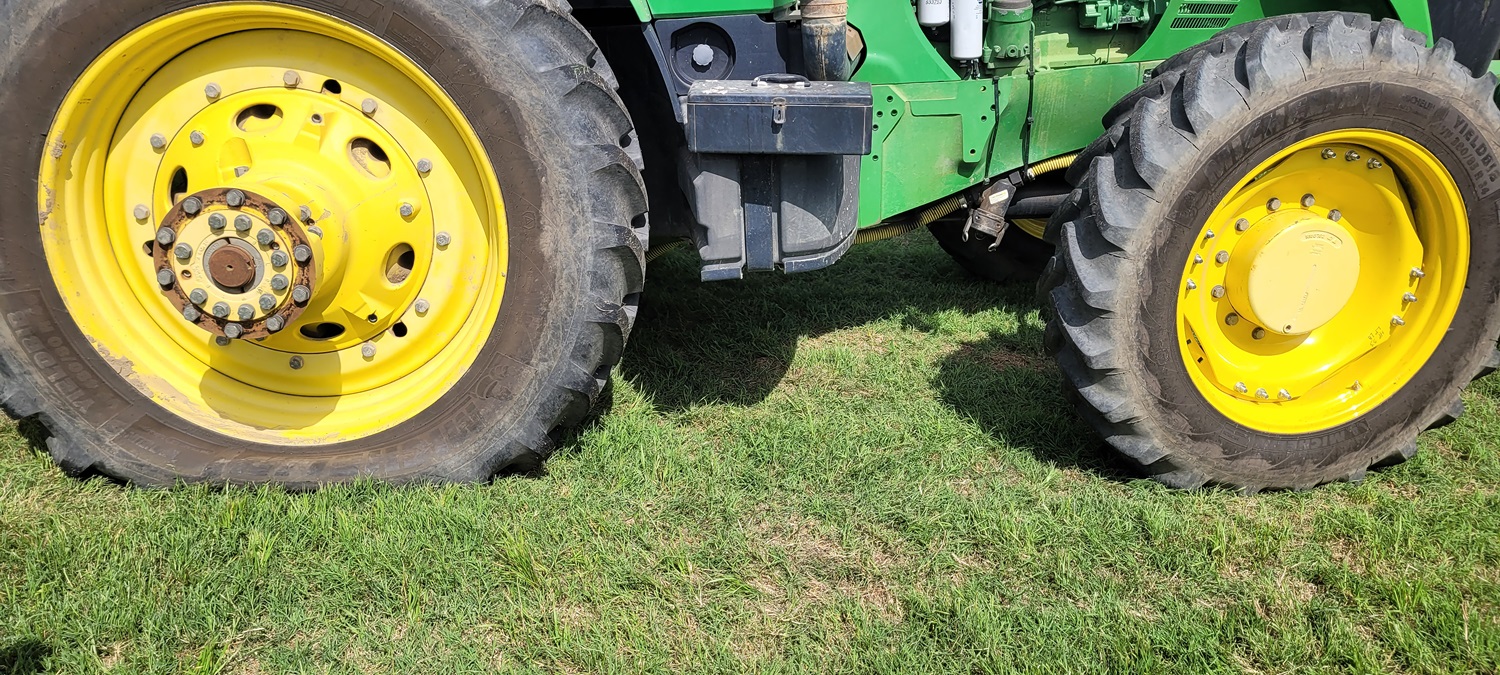
Clemson/Michelin study impact of tyre pressure on soil compaction in South Carolina
Written by Denise Attaway from Clemson University, South Carolina
Clemson and Michelin researchers are studying to determine if low-pressure tires can help increase yields in cotton and peanut rotations.
“We know the researchers at Clemson University will make every effort to determine what data and information is going to best serve our regional farmers. Their proven track record and history in the agricultural world make Clemson one of the academic leaders in this type of real-world research.”
Martin Crouch, agriculture account executive, Michelin Agriculture
Soil compaction is a major problem that affects plant growth and development, resulting in yield losses of up to 50% on some localized, high-traffic areas of South Carolina farms, such as end-rows.
Some Clemson University and Michelin North America, Inc. researchers believe low-pressure tires can reduce soil compaction to help increase crop yields for South Carolina farmers.

Kendall Kirk Kendall Kirk, Clemson Cooperative Extension Service precision agriculture engineer and director of the Clemson University Center for Agricultural Technology (CU-CAT) and Dan Anco, Clemson Extension peanut specialist, are working with Martin Crouch, Michelin Agriculture account executive and Steve Rosen, Michelin Agriculture field engineer, to determine if low-pressure tires can help increase yields in cotton and peanut rotations.
“Cotton and peanuts are two of the major crops grown in South Carolina,” Kirk said. “The overall goal of this study is to learn whether there is an economic benefit to implementing low-pressure tire technologies in a cotton-peanut production system.”
Soil compaction is caused by continuous wheel or foot traffic that squeezes air from between soil particles causing the soil to become hard, resulting in a decrease of water reaching plants’ roots. Information from the National Institute for Food and Agriculture shows most sandy soils in South Carolina have a compacted zone known as a “hardpan” that roots can’t penetrate.
Hardpan is usually found at a depth of 10 to 16 inches and can be 2 to 8 inches thick. This prohibits roots from reaching water and nutrients found in deeper soil.
A Clemson study shows hardpan can reduce crop yields by as much as 50% and make plants more susceptible to drought stress.
Typically, compaction and effects of compaction are more prevalent on end-rows or turn-rows, where machines turn around at the end of a pass, but some degree of compaction occurs everywhere that ground traffic occurs in a field. A reduction in tire pressure reduces soil compaction because the tire footprint or flat plate area – the portion of the tire that touches the surface – increases as the tire is deflated. Because the weight supported by the tire is unchanged and the area over which it distributes this weight is increased, pressure exerted on the soil is reduced.
For this study, researchers are looking at the effects of planting tractors and harvest machinery equipped with Michelin’s Ultraflex VF (Very High Flexion) tire technology on yield and related variables in different soil types. At 40 tons loaded, modern cotton pickers are among the heaviest field machines used in major row crop production. The Ultraflex technology is designed to operate at low pressures and adapt to changes in pressure without affecting tire structure.

Martin Crouch “Clemson is conducting these tests in South Carolina, which will provide region-specific information for farmers,” Crouch said. “We know Clemson researchers will determine what information is best for the region’s farmers. Their proven track record and history in the agricultural world make Clemson one of the academic leaders in this type of real-world research.
“If you want to learn from the leader in cellphone technology, you go to Apple and if you want to learn from the leader in agriculture you go to Clemson.”
A similar study was conducted on wheat by researchers at Harper Adams University in the United Kingdom. Researchers found a 4% increase in yields when machinery equipped with Michelin Ultraflex (IF/VF) radial tires was used, as compared to machinery using standard radial tires. A 2015 study by researchers at the University of Illinois at Urbana-Champaign on corn and soybeans found a 4.3% yield gain using Michelin Ultraflex radial tires versus standard radial tires.
“If similar yield benefits are found in South Carolina cotton and peanut crops, revenue benefits could be as much as $30 to $45 per acre,” Kirk said.
Michelin Ultraflex radial tires are designed to operate at lower air pressures as compared to standard radial tires. This technology also can be coupled with a Central Tire Inflation System, or CTIS, which equipment operators use to control tire pressure from the cab, such as when changing between field and road travel.

Steve Rosen “Operators can decrease tire pressure when they enter a field,” Rosen said. “Using lower tire pressure in fields increases the tire’s footprint to reduce ground pressures in the field, helping improve soil aeration, water infiltration and allowing for better root distribution.”
The CTIS is compatible with most agricultural machinery.
This first year of a three-year study is a “team effort,” Kirk said. In addition to Kirk and Anco, CU-CAT specialists, and the Michelin representatives, others helping with this research include trades specialists who work at the Edisto REC Tim Still and Kim Still, the South Carolina Peanut and Cotton boards and cooperating farmers.
“This project is unique in that it has buy-in and support from people in various sectors of agriculture,” Kirk said. “It is a model for the type of collaborations we seek to establish through Clemson’s Center for Agricultural Technology.”

Clemson University and Michelin researchers are working to determine the effects of low-pressure tires on soil compaction in South Carolina. Pictured are (from left): Steve Rosen and Martin Crouch from Michelin, and Kendall Kirk and Ben Fogle from Clemson. Harper Adams University research suggests running low pressure tyres can boost farmers’ yields
Published 27 April 2021

Photography credit: Jonathan Gill, Mechatronics and UAS Researcher at Harper Adams University. An in-depth international study into the impact of traffic and tillage on soil compaction has found agricultural machinery running low pressure tyres could boost farmers’ yields by four per cent.
The study by Harper Adams University academics used one site at its campus in Newport as well as another site in the USA in conjunction with the University of Illinois, working with tractors fitted with low pressure Michelin tyres.
Senior Lecturer in Soil and Water Management at Harper Adams University, Dr Paula Misiewicz, said: “Agricultural vehicles have got heavier and heavier over recent years and the impact that has on the soil can be severe. The aim of our investigation has been to find ways of alleviating compaction.”
The study in Illinois was conducted over three years, using 290 hp tractors with Michelin Ultraflex Technology low pressure tyres and standard pressure tyres running in two fields.
Dr Misiewicz added: “The results we saw in Illinois showed quite clearly that Michelin Ultraflex Technology tyres can help farmers to significantly reduce compaction and, in the process, boost their yields by 4 per cent in comparison to standard tyres.”
The study on the Harper Adams campus – which ran for nine years – also compared the two Michelin standard and Ultraflex tyre set ups combined with controlled traffic farming together with zero tillage, shallow tillage and deep tillage techniques.
“While there were some benefits of using low pressure Ultraflex Technology tyres in all three systems over the nine years, it was with the deep tillage techniques where it really stood out. Here again we recorded around a 4 per cent yield improvement in comparison to conventional farm tyres,” said Dr Misiewicz
Visiting Professor at Harper Adams University, Professor Richard Goodwin, added: “Whilst that improvement might seem small, when you think of it globally, it goes a very long way to help feed the world. Many people are worried about the sustainability of the human race, and if we could get these results for many different crops, it would make a huge impact in sustainability.



-
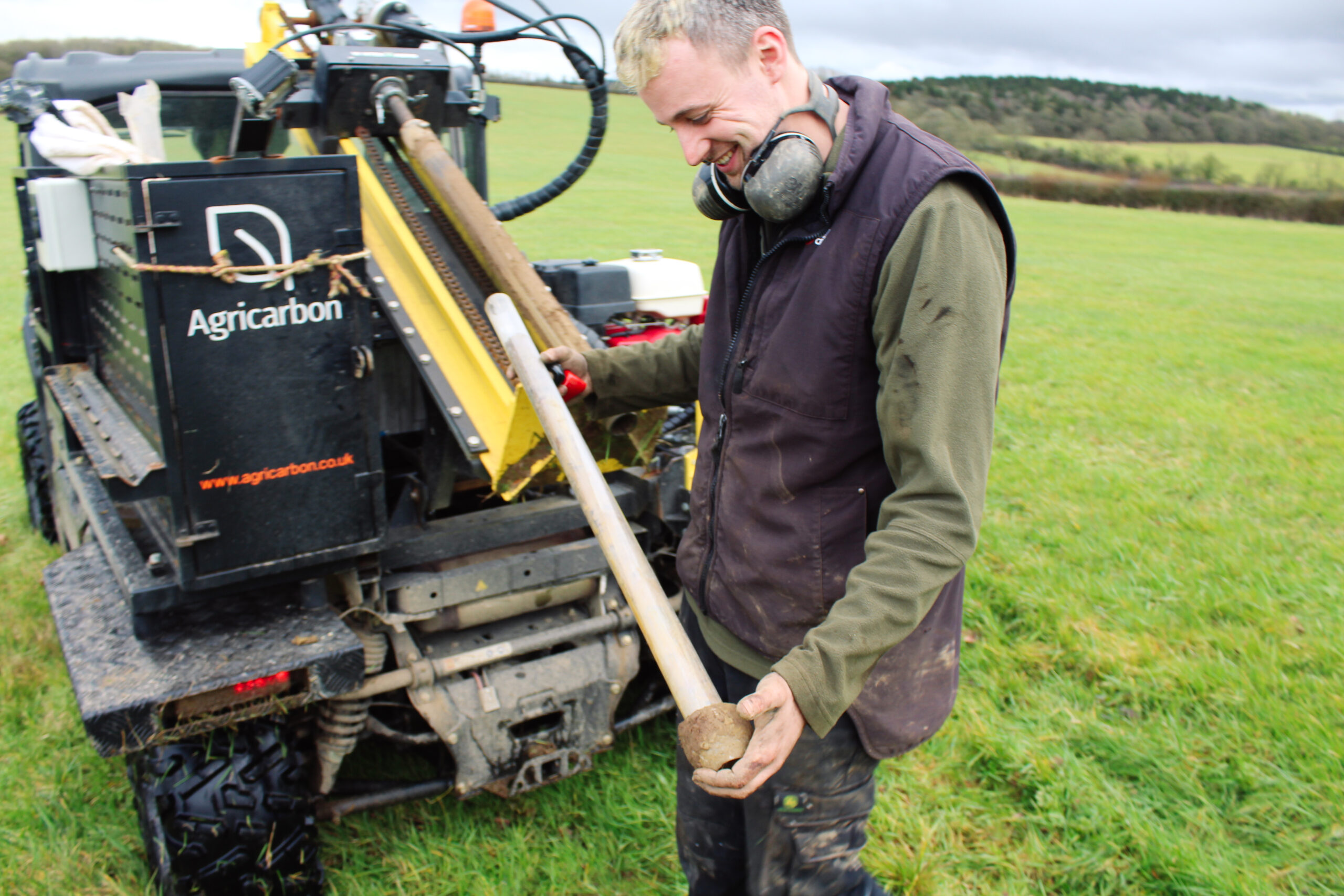
What is the Best Way to Measure Soil Carbon Stocks? A Guide to Choosing a Project Developer for Soil Carbon Revenues
By Dr. Harry Kamilaris
Introduction
Soil’s capacity to remove atmospheric CO2 and increase stored organic carbon is bringing new commercial opportunities for farmers. However, the market and regulatory landscape is still evolving and different Carbon Project Developers (CPDs) – companies who partner with farmers to create and sell carbon credits – have adopted a variety of different methodologies. The accurate measurement of soil carbon stocks is vital. For farmers, choosing to work with a CPD that will offer the best, long-term income is vital to making the most of this opportunity.
There are two main parts to the role of the CPD. First, they need to support farmers’ choice of farming practices to build soil carbon stocks. Second, they need to quantify and verify the increase in soil carbon stock – as reliably as possible. This second part is critical to securing carbon buyers – willing to pay for soil carbon removals – and for the agricultural sector to be recognised for delivering real and substantiated climate benefits.Success hinges on selecting the right CPD: one who not only understands your needs but who has also mastered the specialism of soil carbon MRV – Monitoring, Reporting, and Verification.
In this guide, we explain the essential components of reliable, transparent and future-proofed MRV, equipping farmers to ask the right questions and make informed decisions in their journey into monetising soil carbon restoration.What is Soil Carbon MRV?
Soil carbon MRV is the backbone of any credible carbon project. It involves robust measurement of the amount of organic carbon in farmed soils at the start of your contract, and then verifies the change in quantities of soil carbon stocks at the end. This is used to validate carbon credits that have been issued and paid for over the course of the project. It also provides a guide to the farming practices that are likely to yield the most carbon benefit. As you explore potential partnerships, it’s crucial to select a CPD who can demonstrate a fit-for-purpose and comprehensive MRV process that will stand the test of time. This ensures that your carbon credits will be respected and valued by the market as it evolves and offer the best income opportunities from buyers looking for high quality credits they can trust.
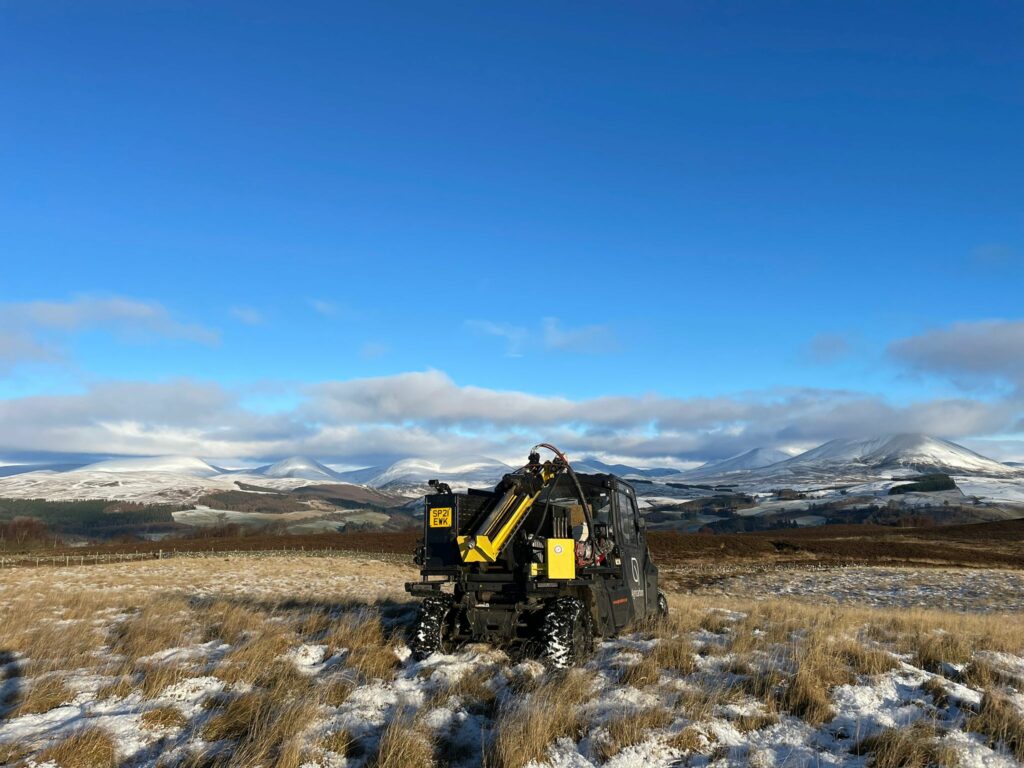
CarbonForce, Loch Tummel Key Considerations for Farmers
- Activity vs outcome-based payments: Some CPDs remunerate famers for making practice changes (e.g., use of cover-crops) while others make payments based on the soil carbon outcome. In both cases, the CPD still needs to provide robust evidence to validate the carbon benefit being sold to carbon buyers, for your income to be reliable.
- Scientific Rigor and Accuracy: Ensure the developer uses accepted science-based methods to measure soil carbon. This can be direct use of primary data or modelled estimates; both must be demonstrated to give reliable results when measuring change in carbon stocks over time.
- Protocol Alignment: CPDs should adhere to credible MRV protocols. Comprehensive MRV protocols are published by independent registries; to improve integrity, CPDs can align with these to ensure their work meets recognised carbon market standards.
- Transparency and Trust: Look for a developer who values transparency in their processes and communications, especially with carbon buyers. Clear, honest interaction helps you to understand your options and helps carbon buyers have confidence the credits they pay for from your land.
- Farmer-Friendly Approach: The ideal developer understands farming realities and tailors their approach accordingly. The service should be designed with practicality in mind, making the process accessible and manageable for farmers.
Activity vs outcome-based payments
Payments based on ‘farm activities’ are popular among Carbon Project Developers. It is often easier to validate implementation of farming practices (e.g., farm visits can check cover crops have been planted) than it is to measure the change in carbon in the soil (the outcome). In the near-term it may also be lower risk to farmers because payments do not require proof that a soil carbon benefit has been achieved. However, long-term this approach may be hard to maintain as carbon reporting and carbon markets become more structured and standards are established to avoid greenwashing. An approach that can clearly show measured change, or a well evidenced estimate, may be a safer option over the long term. Remember, once you have made a start with a chosen project developer, it may be hard to switch to a new scheme that requires a practice change to be introduced to qualify for credits.
Scientific Rigor and Accuracy in Measuring Soil Carbon Stocks
Measuring carbon stocks with rigor and accuracy requires expertise that often sits outside the CPD organisation. Using an independent service like Agricarbon, designed explicitly for the purpose of validating carbon credits, brings trust and value to the carbon buyer, and security of income to the farmer. The use of direct measurement (analysing actual soil samples) is fundamental, even where a modelled estimate is used to allocate carbon payments. ‘Ground-truth data’ from direct measurement is needed to set the start point and to calibrate models to give a realistic estimate. All credible MRV protocols, from independent carbon registries, require direct measurement at the start of a project and again at least every 5 years, to verify that benefits claimed and paid for are real.
The methodology should include a logical sampling design: the number of samples required and how they are allocated across the measured area. This should include a statistical assessment of whether the sample number will be sufficient to detect change in carbon stocks over the project timeframe and a valid approach to distributing samples to represent the whole measured area. For example, random allocation is a common and recognised approach, while more directed sampling (covering some areas and not others) is being developed by remote sensing companies and should be based on robust evidence (from ground truth data).
Sample collection and analysis should follow detailed standard operating procedures to ensure consistency and quality. Analysis should include measurement of Soil Organic Carbon (%) and Bulk Density (how much soil there is in each field) so that the carbon stock – total tonnes of carbon – can be calculated with confidence.
Agricarbon provides all aspects of the direct measurement process, from sampling design through sample collection, processing and analysis, and calculation of carbon stocks. By focusing exclusively on this vital part of the process, Agricarbon brings independence, deep expertise and consistency to measuring soil carbon to underpin trust in the credits issued and sold by Carbon Project Developers. This, in turn, assures farmers more reliable and higher value carbon farming projects.
Protocol AlignmentAll CPDs should be able to show you their MRV protocol (detailed instructions and requirements for robust Monitoring, Reporting, and Verification of carbon benefits). These can produced by the CPD, but reputable protocols are published by international registries such as VERRA (VM0042 protocol), CAR (Soil Enrichment Protocol) and Gold Standard. A developer aligned with these public protocols demonstrates their commitment to upholding standards in carbon credits and will ultimately have the widest access to carbon buyers. However, actual validation by these registries is costly so many smaller or newer CPDs will align, but not register, their projects. Agricarbon’s methods have been designed explicitly to comply with the main public protocols and allow CPDs to get ‘Measurement’ right for every project. As projects increase in size, formal registration will become increasingly important to ensure the integrity of credits and protect the income to farmers and the reputation of the agricultural sector.
Transparency and TrustTransparency in processes and communications is a cornerstone of the relationship between farmers and Carbon Project Developers. A developer who values transparency will keep you informed about the methodologies used, the progress of your project, and the carbon benefit of changes you implement on the ground. A developer using consistent methods of direct measurement across numerous projects will also build insights into farming practice impacts on soil carbon stocks and, in future, be able to guide your decisions about the environmental and commercial value of carbon farming approaches.
Farmer-Friendly ApproachCreating carbon credits is a complex and technical processes. Do not underestimate the work that a project developer must put into getting this right! They also need to translate this into something accessible and manageable for farmers. The breadth of knowledge within a good project developer spans agronomy, climate science, green finance, carbon reporting and carbon markets. Additionally, they must understand the farming context to ensure the project fits seamlessly into regular operations and doesn’t affect production. Agricarbon takes the Measurement part of that process and ensures the farmer has to do nothing more than open the farm gate. We usually integrate with the CPD’s process, and our data goes directly into their reporting.
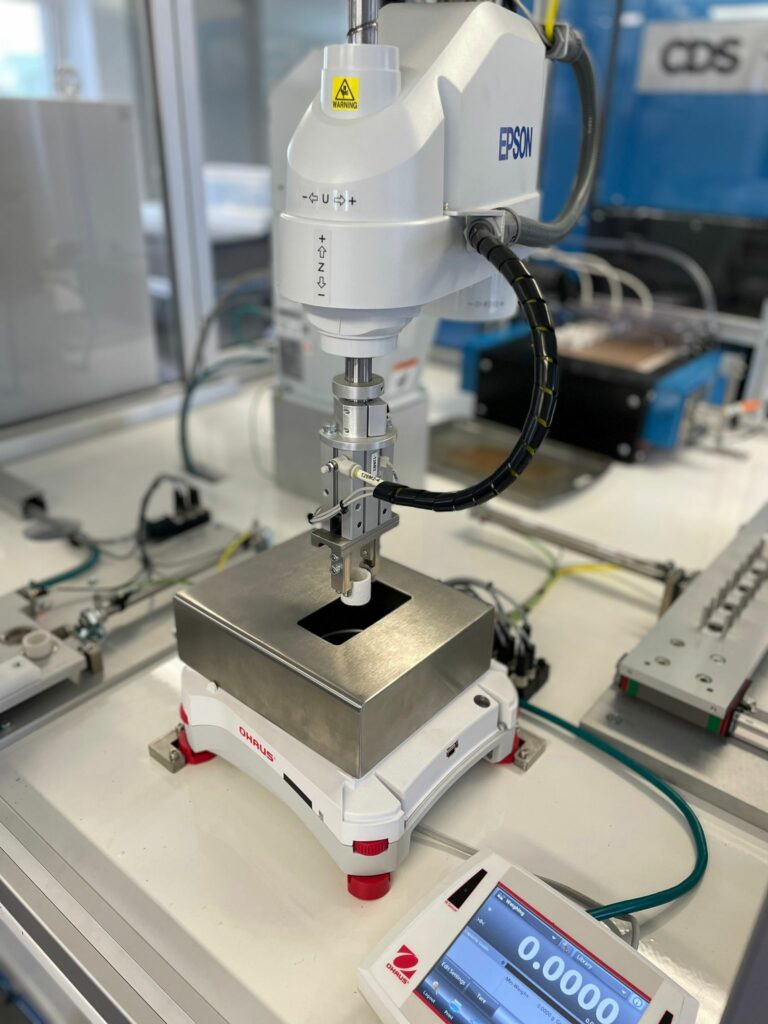
ASCA Machine Empowering Farmers with the Right Questions
When evaluating CPDs, farmers should feel empowered to ask specific questions to explore the expertise the CPD brings to each project. Questions could include:
- Who buys the carbon credits I generate and what validation do you give them?
- What MRV protocols will you follow and how do they align with internationally recognised standards for the wider carbon market (e.g. VERRA, CAR)?
- Who provides the measurement expertise to ensure robust carbon data underpins my project?
Opening the Gate to Agricarbon
As you consider venturing into soil carbon credits, remember that your choice of CPD will make all the difference. Choosing a developer who is working with Agricarbon means that they are dedicated to your success in the carbon market, grounding your project in the best practice most valued by carbon buyers.We also work directly with farmers and landowners who are empowering themselves by establishing a baseline of their soil carbon stocks today. An independently sourced baseline from Agricarbon can support a farm business’s own net zero ambitions or provide evidence of current soil carbon stocks before making a decision to enter any form of carbon market scheme.
If you’d like to know how to measure your soil carbon stocks. Contact Dr. Harry Kamilaris at hkamilaris@agricarbon.co.uk and begin your journey with Agricarbon.



-
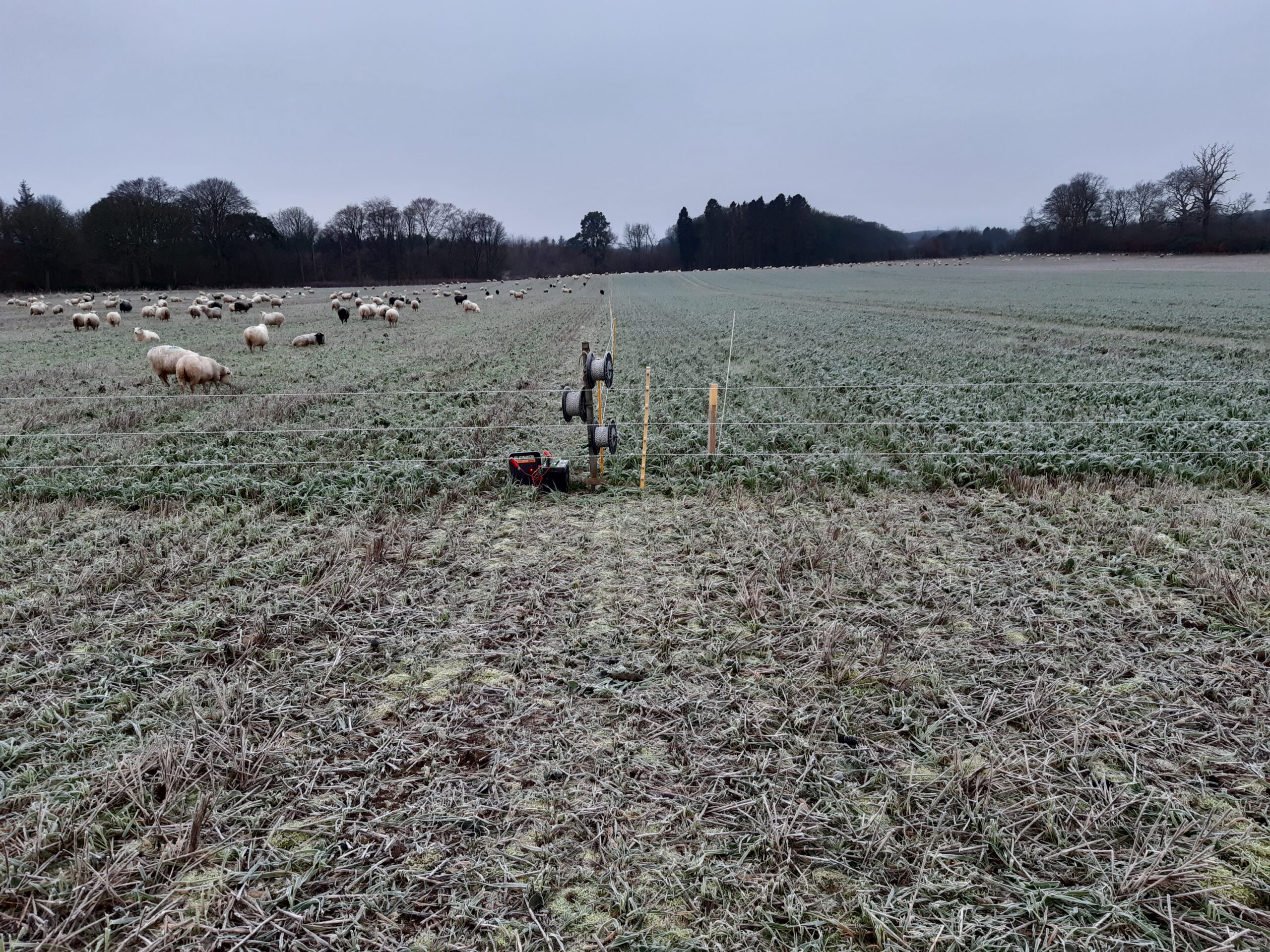
Farmer Focus – David Aglen
Dec 2023
So it’s back down to earth with a bump this year. We have had a run of favourable summers that have helped us succeed with our direct drilling and progress with cover cropping across the farm. Essentially the harvests have been earlier and drier, allowing timely straw baling and cover crop establishment. However, we were back to our more usual harvest timings for 2023, this is more like the conditions we faced when we first ventured down the no-till route. Variable would be the best description of the outcomes then.
We have learnt a lot over the years and, with more appropriate technology and experience, we seem to have upped our game. I think our soil structure has improved to the extent that we can sow sooner after any wet weather, successfully. That said, 12 months ago we were looking at plenty of early sown winter cereals and cover crops with huge canopies being eaten by our newly resident sheep flock. This year we have very little early sown cereals, and the cover crops are not quite as large. Despite this we are still seeing big benefits. During the particularly wet October (I must confess we got off relatively lightly, compared to others further north, with only 250mm for the month). Yes, we did have plenty water running out of gateways, but the vast majority of this was running clear, still the odd bit after potatoes that left a lot to be desired, to remind us of what we are missing by not cultivating the whole place.
I briefly mentioned our livestock partners, Sheepleep, a livestock business run by Alex Johnston and Rosie Hetherington, a few months back. The deal is that we pay them an annual fee to manage our cattle and grazing in line with our requirements. The benefit to us is a dedicated livestock team and year round access to sheep, but more important is their mindset regarding mob grazing and building a ‘cheap to operate’ cattle enterprise. An example being that we now mostly walk the cattle around the farm instead of using a trailer and tractor. This has saved a lot of time and money in just 16 months. We even cross the dual carriageway with the much appreciated help from the police who close the road for us for a few minutes. It takes about 2 minutes for 150 cows and calves to cross, instead of a whole day to move them by trailer.
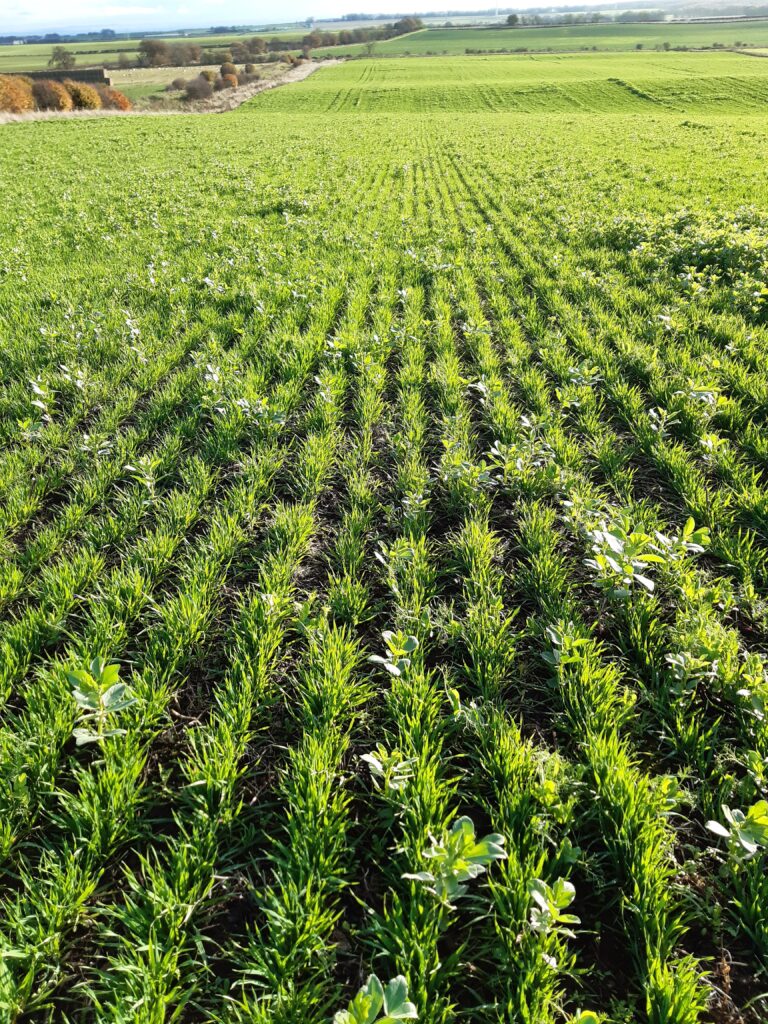
2022 no-till winter oat crop Sheepleep get access to 1200ha to graze and develop their sheep flock in return for a grazing fee. They benefit by having a portion of their income known for the year and having continuous access to a large block of land for their business to operate from. The opportunities for young people to build a business from nothing within agriculture seem to be slim, mostly related to land access issues and plenty established farmers willing to pay more to access what little does come available.
So currently we have 1100 ewes being tupped as they move rapidly across the cover crops in 2 separate mobs. The aim is to keep the ewes on as high a plain of nutrition as possible for the 19 days the tups are working. They are leaving about a third of the cover crop uneaten. Forcing the ewes to clean up more might reduce the lambing percentage, a risk not worth taking. The ewes will most likely go back over these crops later in the winter to clean up when they can be made to work harder for their feed. Benefits from an arable perspective include the retention of a living root system in the soil for a few more weeks of the year, as well as leaving some extra ground cover for a bit longer, after all we have most of the winter to come yet and with that, plenty precipitation I suspect.
We experimented with some hairy vetch in a few cover crops last winter. I was not convinced that this would survive the winter frosts. I need not have worried. We have added more into some covers this winter to aid diversity for both the soil and the grazing stock. Some of these crops will be cut for silage in May ahead of the kale crop establishment in the same fields. I am hoping the vetch will add something extra to the silage too.
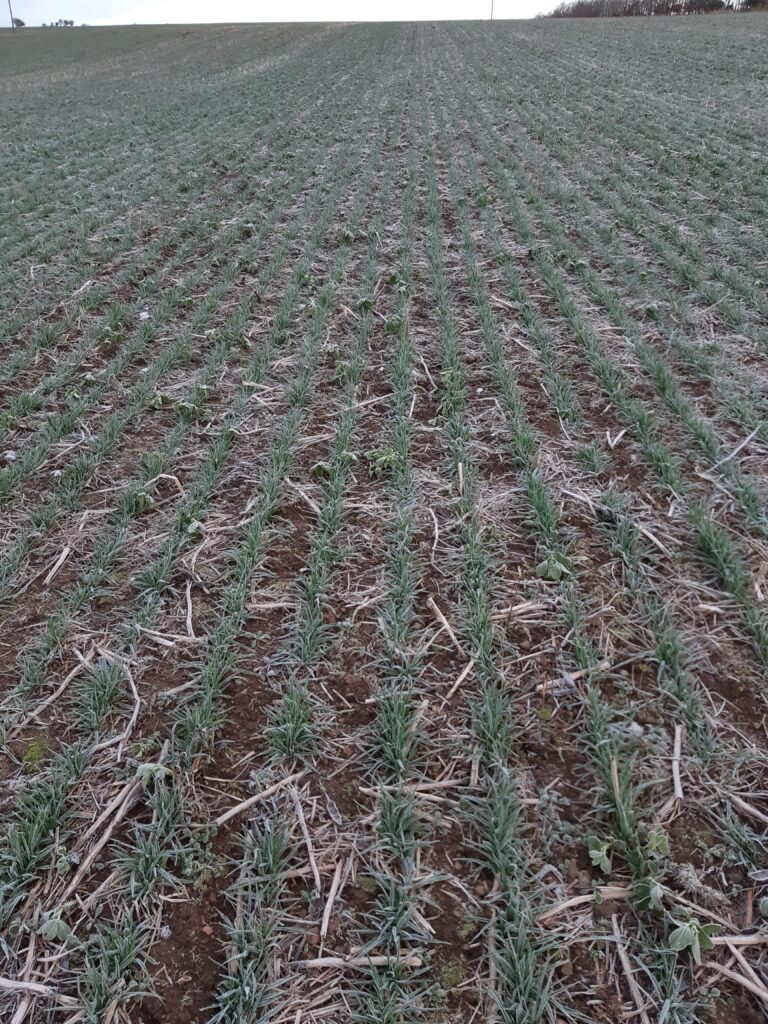
2023 no-till Winter oat crop In the constant drive to increase diversity, it was decided we would graze sheep and cattle together this summer. The cows had other ideas. The grass was quite long when this started. The first problem was having to strim grass to get the 3 electric wires set up for the sheep. Then we discovered that the cows pay no attention to the orange electric wire, they are used to a white one, and proceeded to walk right through it. We ended up with sheep and cows all over the field along with the wire that was supposed to contain them. The experiment was given up after a couple days, back to the drawing board for this. Could technology help here with electric collars? Maybe, if they ever become cheap enough.
Despite the very wet October, the cattle made very little mess as they moved round the grazing platform. We had built up large covers that were able to carry the cows and hold them out of the soil on all but the wettest of days. Only a few of the paddocks were left looking a little dirty – they represent only a very small part of the grazing platform and will recover. Perhaps we will have to rest them longer through the spring next year for this. This is just one of the many benefits we are seeing as we adapt the rest periods of the grass to the growth rate. The longer rest period from July onwards allows a thatch to be built up, whilst still producing plenty grazing for the cows. I dread to think what the grazing fields would have looked like if we were still set stocking.
The cows moved onto the kale in November with calves still at foot. This is a little earlier than we would like. This decision was made to allow all the kale to be eaten up in good time giving us the option of timely establishment of the following spring cereals. Last spring, we held stock on the kale longer than ideal to eat it all up. This was to the considerable detriment to the spring oats that followed. We were too greedy with the cows. This is just one of the compromises we currently face in our system. Keeping livestock cheaply whilst not out staying their welcome on the arable part of the rotation. ‘Grow less kale’ some would say, and were I braver, I would agree. I feel anything gained over a year or two might well be wiped out several times over when we do get a winter where we need plenty extra feed. When this occurs, usually everyone is short, so buying in could prove costly in an emergency.
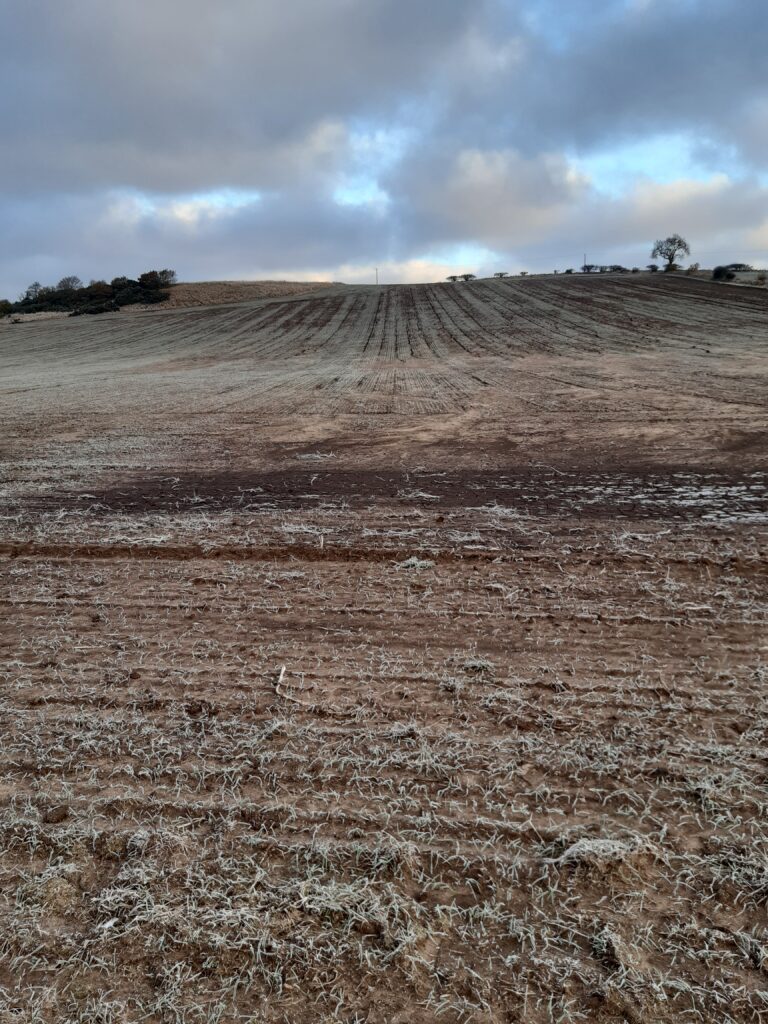
The humble spud or the dreaded spud – Potatoes previous crop 2023 Calves will not be weaned until mid-February. The cows will do the heavy lifting, greatly reducing the challenges on the outwintered calves. By weaning time, the days are longer, and the sun is starting to feel warm again. The stress from weaning shouldn’t be so great as the calves are a lot older than many wean. Calving is due to start on 10th April, and, for the first time will be outside, by design. We had better enjoy the quieter winter months now. With spring work hopefully getting going in February, calving, lambing, and turning fattening stock back onto grass in April, we will need to have our wits about us. February is less than 9 weeks away!
I was lucky enough to join the BASE UK trip to France in November. We spent 3 days visiting farms within a 3hr radius of Paris by car. A lot was learned, the knowledge they have of cover crop and extracting the most from them is huge. I can highly recommend this trip to all, as well as BASE UK membership, should the opportunity come around again. The knowledge transfer ability of peer-to-peer learning is huge. It was good to see livestock being seen as part of the cover crop recycling task over there too.


-
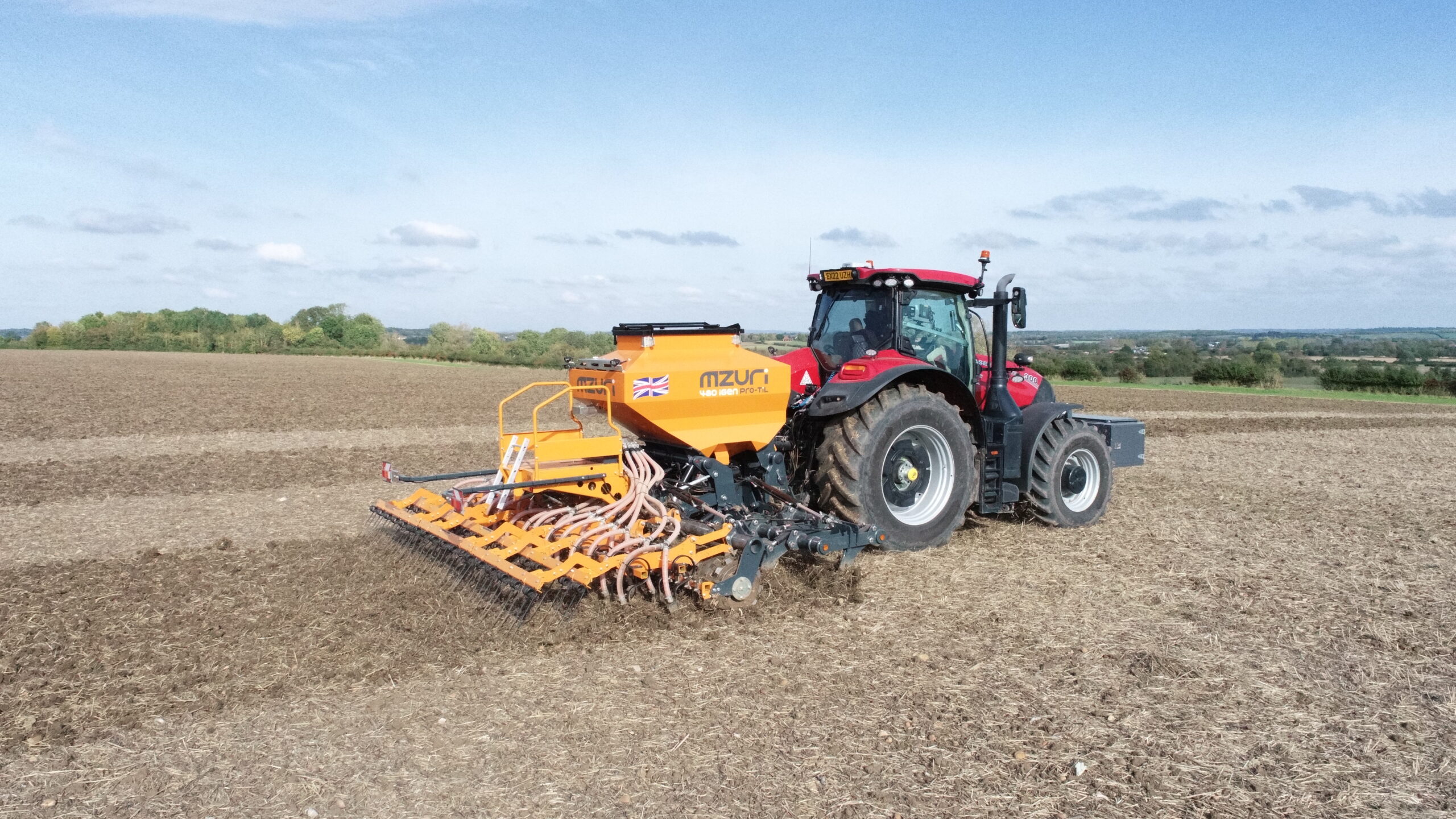
Drill Manufacturer – Mzuri
Introducing Mzuri’s Latest Innovation: The Pro-Til iGen Linkage Direct Drill, Making Mzuri Seeding Technology More Accessible than Ever
Mzuri, a renowned name in agricultural machinery, proudly introduces its latest innovation – the Pro-Til iGen linkage machine. This new model is strategically designed to provide a cost-effective alternative to the manufacturers premium range all while maintaining the high standards of Mzuri technology that users have come to trust.
Quality without Compromise
The Pro-Til iGen stands out with its commitment to quality, a hallmark of Mzuri products. The manufacturer is proud to present this latest range which demonstrates a wide range of innovative features, not usually associated with machines in this price range.
Impressive Features
One of the standout features of the Pro-Til iGen is its large 2,200-litre seed tank, pressurized for efficient metering and conveying of seed accurately, even at high forward speeds. This design ensures minimal downtime and an impressive overall output, providing farmers with a reliable and productive seeding solution.
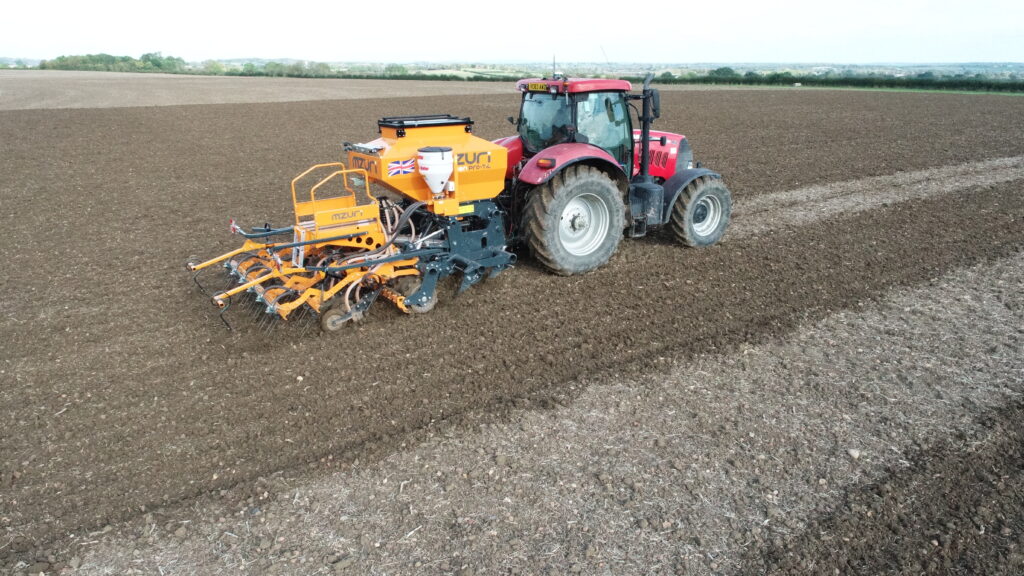
The Pro-Til iGen 300 fitted with independent spring loaded coulters with individual depth wheels. Proven Mzuri Technology
Staying true to the Mzuri Technology blueprint for consistent crop establishment, the Pro-Til iGen features a leading tine, dual reconsolidation and independent coulters. Unique to this machine, the Pro-Til iGen features a full-width packer that ensures accurate depth control, producing a uniform, level seedbed reconsolidated against air pockets.
Seed Delivery Options
Seed is delivered into reconsolidated zones through two optional coulter configurations. Independent spring-loaded coulters, each equipped with its own depth wheel, offer precise seed placement and reconsolidation of the seeding zone. For a simpler format, users can configure the Pro-Til iGen with two rows of spring tines.
A double harrow bar follows to provide a uniform field finish ideally suited to pre-emergence chemistry application.
Versatile Wearing Metal
The Pro-Til iGen’s leading point is compatible with a range of wings, providing flexibility for different degrees of soil disturbance based on field conditions. With a replaceable front point, the leading tine is fitted with a large tungsten carbide tip extending the wearing metal’s life expectancy.
Optional Extras for Enhanced Performance
Optional extras for the Pro-Til iGen include an additional tank for microfertiliser or chemistry application, marker arms, seed monitoring, and pre-emergence markers.
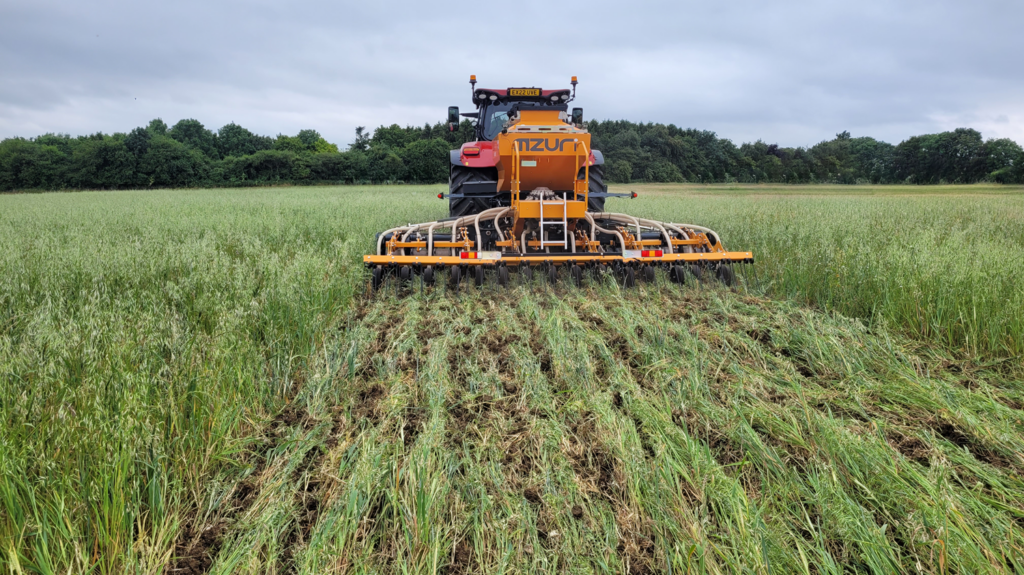
The Pro-Til iGen is a linkage direct drill built on proven Mzuri Technology Accessible Seeding Technology
With the Pro-Til iGen, Mzuri makes its cutting-edge seeding technology more accessible than ever, offering operators a cost effective mounted solution to achieving Mzuri’s trademark consistent and even germination.


-
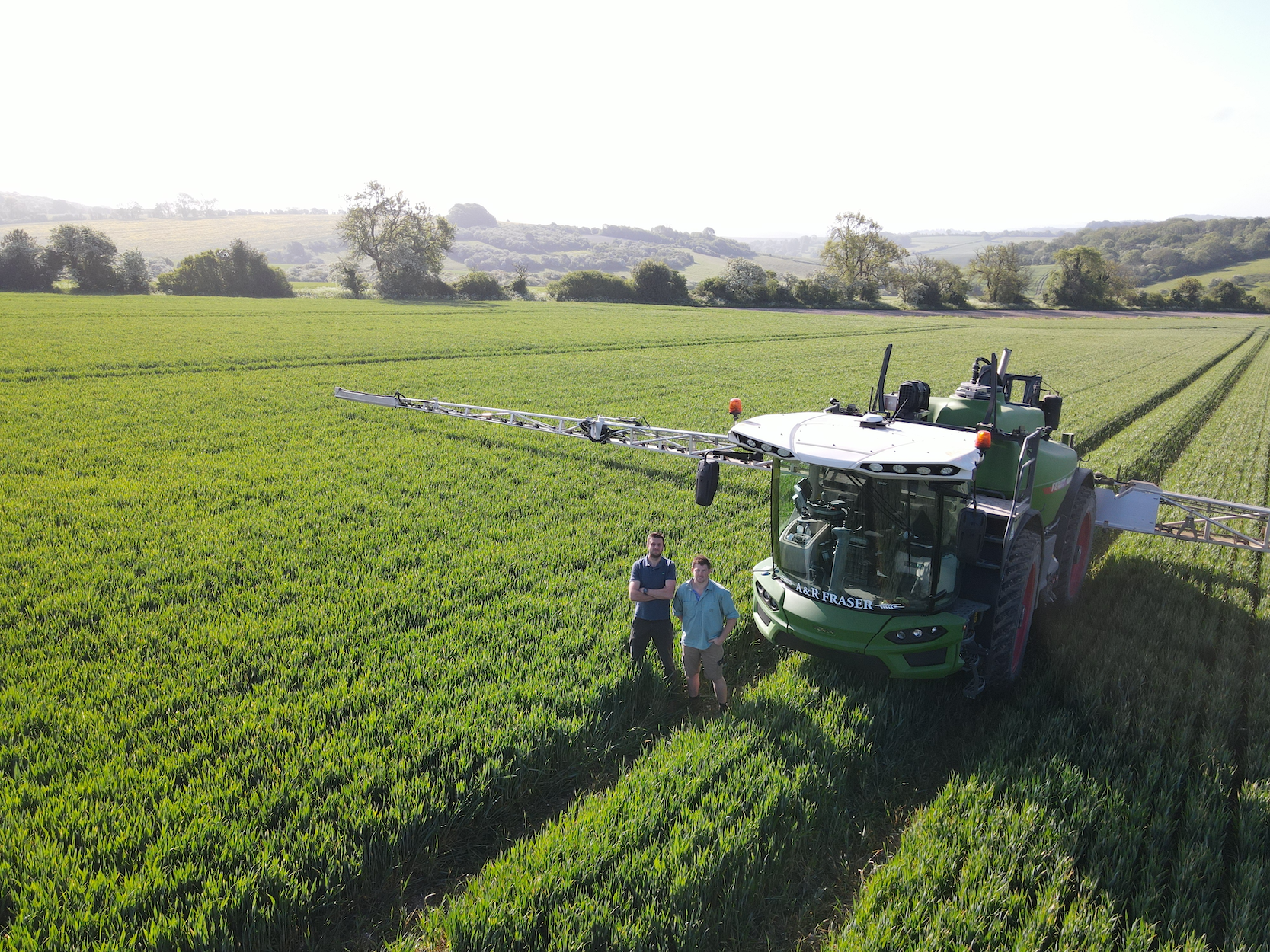
An award-winning advisor’s path to no-till agronomy
Todd Jex won Arable Advisor of the Year at the Farmers Weekly Awards by being at the forefront of the latest regenerative and no-till farming practices. The award is the culmination of a journey he began almost a decade ago when his eyes were opened to a different way of farming following a visit to a pioneering farmer.
Based in Wiltshire but with clients across Dorset, Wiltshire, Hampshire and the Isle of Wight, Todd works for leading farm advice, technology and supply business Agrii. The proportion of his clients utilising no-till and regenerative practices has increased from the first farm approaching him in 2016 to almost 70% this season.
Although he did not grow up on a farm, Todd spent a lot of time with his grandfather, who managed a mixed arable and dairy farm on the Dorset – Wiltshire border. Today, his grandfather’s approach to farming would be called integrated crop management (ICM), but back then, it was considered just good crop and animal husbandry.
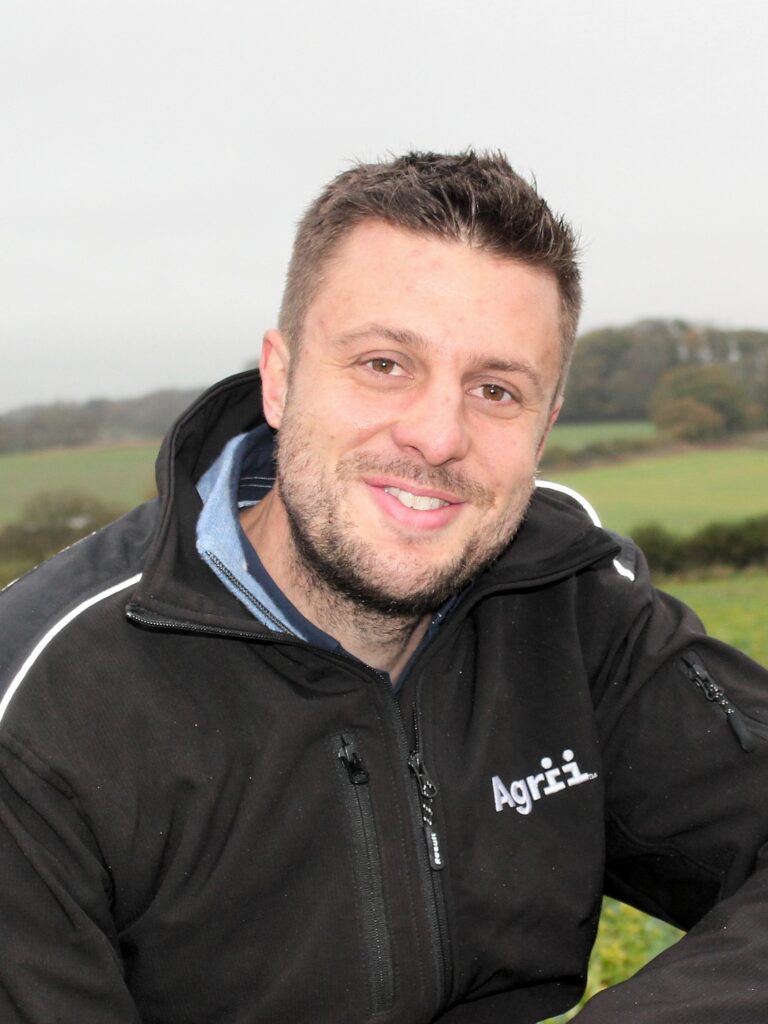
Todd Jex “Rotational ploughing, crop rotations and what he called ‘feeding the ground’ were essential parts of his philosophy,” says Todd. “He was my biggest influence until I went to Harper Adams to study agriculture, agronomy and crop science.
“I did a placement year working in R&D for another agronomy company and spent much of my time working on trials examining black-grass control. From this, I became fascinated by the cultural control options for black-grass management, like direct drilling or rotational ploughing, and followed it up with a dissertation on the subject.”
When Todd joined Agrii’s forerunner, Masstock, he helped with trial work alongside training to be an agronomist. Agrii supported his academic and practical training, with Todd completing his BASIS Diploma.
At the start of his career, most farms in the area were practising mill-till or rotational ploughing with no direct drilling. Ideas began to form in his mind about how different approaches to farming involving direct drilling might help farmers tackle black-grass.
Everything changed following an introduction to Paul and Oliver Harris. They had been doing some direct drilling with a Claydon machine but wanted to move to a true no-till system using a disc direct drill and were looking for an agronomist to support them with this change.
“The reason for the switch was for black-grass reasons and also improving soil health, which I had not encountered before. They arranged for me to visit Tony Reynolds, who had adopted no-till ten years earlier.
“Even as I was approaching the farm, I noticed how different it was because there was significantly less black-grass on his fields than others I had driven past to get there. Tony was fascinating, enthusiastic, and happy to share his knowledge and experiences.
“I was shown some research a university had been doing on his farm examining soil health and water infiltration rates compared to a neighbour’s mil-tilled farm. I couldn’t believe what I was watching; Tony’s land was absorbing the water as fast as they could pour it, and they stood waiting for the neighbour’s to drain.
“That day was a massive influence on me. Combined with my past experiences and the Agrii research I saw, especially at their Stow Longa site, I became increasingly interested in soil health. I began reading books, attending events, and listening to podcasts on the subject. By working with Paul and Oliver Harris on their farm, I could put much of what I learned into practice,” explains Todd.
The Harris family held an open day at their farm to show what they had been doing with Todd, which helped some of Todd’s other customers go in their direction a year later. This proportion has gradually built up to over two-thirds of his area.
In the future, Todd believes almost all the farmers he deals with will be utilising a direct drill system, and an agronomist’s role will become even more involved in all elements of farming. This increased involvement will be balanced by new A.I. and digital technology helping with existing tasks.
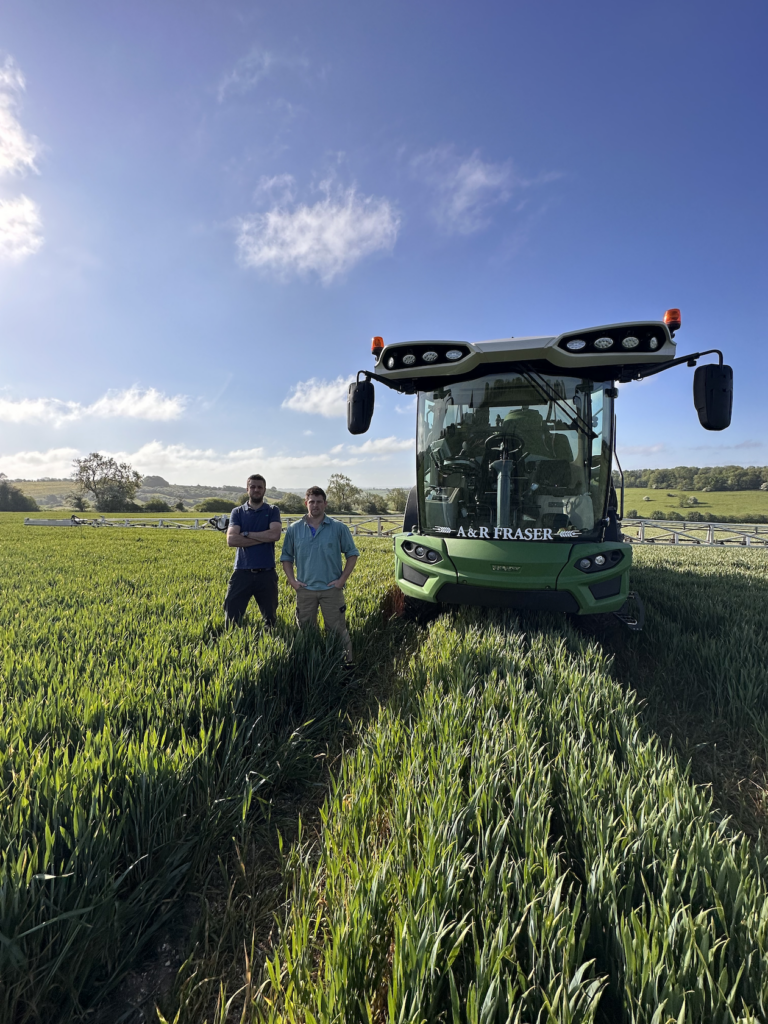
“Agronomy is already multi-faceted, but it will be even more so in the future. The agronomist will have to spend more time with farmers advising on aspects of crop production they do not currently do. Things like examining soils for compaction or advising on machinery will become the norm.
“I was delighted to have just made the Arable Advisor of the Year final, knowing that one of my customers had taken the time to nominate me. My colleague Neil Harper was also a finalist. I believe that is the first time any company has had two employees up for the award in the same year.
“I am incredibly proud to have won the award, and so are my family. It is always something I hoped to have a chance to win at some point in my career. I am a finalist for the Young Agronomist of the Year at the National Arable and Grassland Awards in February, which is another exciting opportunity.”
[panel] Case study: reaping the benefits of a different approach.
George Fraser of A&R Fraser has worked hand-in-hand with Todd to adopt a direct drill system, transforming their farming operation. Their journey began when George’s home farm was sown using a Weaving GD direct drill, and cover crops were integrated into the rotation.
A&R Fraser contract farms 3000ac across Wiltshire and Dorset. As well as contract farming, George’s brother Jonny runs a successful digestate contracting service for local farmers, and they have a herd of beef cattle. A rotation of winter wheat, spring barley, spring beans, and oilseed rape belies an astonishing performance highlighting what can be achieved through ICM and regenerative practices.
“We first started on our farm to test the system,” says George. “We then started suggesting the new approach to our customers because we could see the results. Our landowners were quick to get on board. Now, it has gone from us suggesting it to it being demanded. People say there is a big yield drop-off when you switch, but we have never seen this.”
“The main change we have made is to move away from cultivation to a focus on soil health to manage compaction and improve soil structure. We always start by measuring the soil when we bring new land into the system,” adds Todd.
The move from min-till and ploughing to direct drilling has drastically cut George’s fixed costs. He has calculated that they are 40% lower. George retains a low disturbance subsoiler for primary cultivation when needed, unlike some regenerative farmers who strictly adhere to a no-till system. He believes this can be necessary for up to five years on heavy soils to manage soil compaction.
It is not just fixed costs that have been reduced. The focus on soil health also means they are getting more yield from fewer inputs. Using slurry and digestate, combined with moving to liquid fertiliser and using inhibitors, has halved inorganic nitrogen use.


-
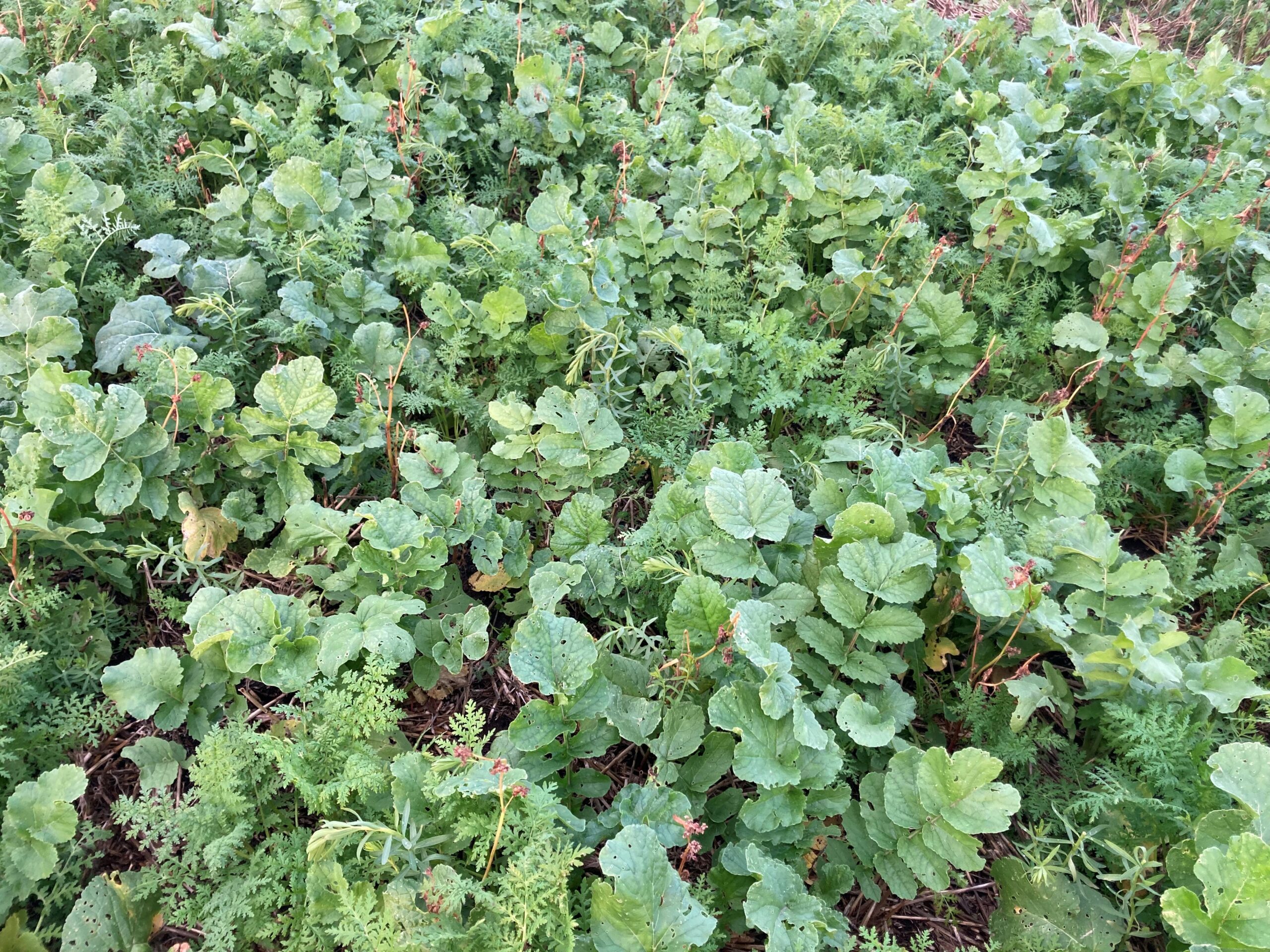
Farmer Focus – Phil Bradshaw
Dec 2023
We have had a very busy few months since my last article, with non-farming activities sometimes compromising the day job of farming.
The beans and mustard planted in the spring established well, and we also planted some home-made wild bird seed mix on the old stewardship plots. With a reduction in farmed area last year our Higher-Level Stewardship (HLS) agreement ended in January, but we kept some of the options such as Wild bird Seed plots going until we could start something new.
The mustard suffered from pigeon damage, and a ‘Biblical’ hailstorm, but recovered well. The beans always looked good, but I feel all crops suffered a little from the lower sunshine levels through Summer 2023 compared to the year before.
Harvest 2023 started with our Winter Barley trial plots which were reasonably good, but only a few hectares. We then moved into second wheat Skyfall which yielded well, at 9.2t/ha, but also had superb quality which has been good with milling premiums so strong.
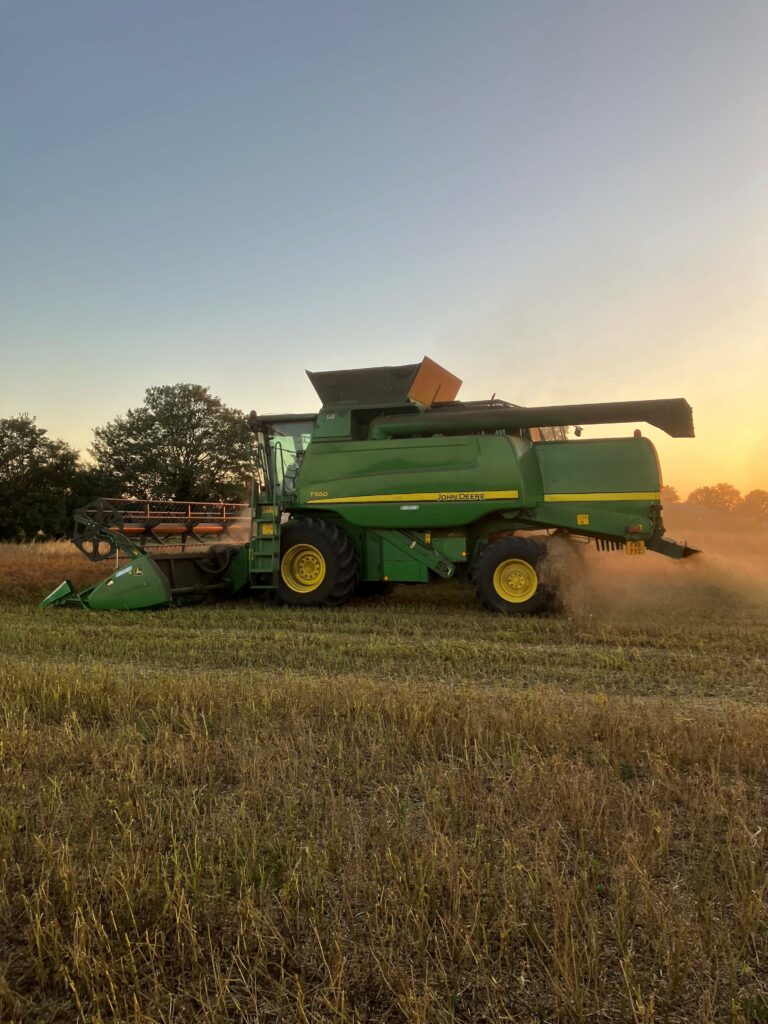
The first wheat Zyatt was slightly better yielding, and the Extase grown mainly as a first wheat was better still, at just over 10t/ha, with good quality, and some has been sold already with a reasonable premium. The beans scraped 4t/ha which is slightly below average, and way below the 6t/ha we had in 2021.
The re drilled mustard was harvested fairly late in the season, but happily yielded 1.3t/ha which for a first-time grower, and a crop that had a huge run of bad luck, was fairly pleasing.
As usual everything was direct drilled, with just some land loosened where necessary with our old paraplow.
We did another low N trial, with some basic missed tramlines in some first wheat Extase following Oilseed Rape. While most of the field had a typical 120kg/ha of Nitrogen, mostly soil applied, the trial areas had just 6kg/ha of Nitrogen applied late as a foliar spray of Methylated Urea around the T3 timing, and reduced fungicides and growth regulators.
The results gave a fractionally lower yield but with slightly higher protein for the low N area. This is not a replicated professional trial, so it needs noting with caution, but it highlights the fact that here on this soil, we can cut Nitrogen rates and other inputs down by a significant amount, and hopefully maintain yield and quality.
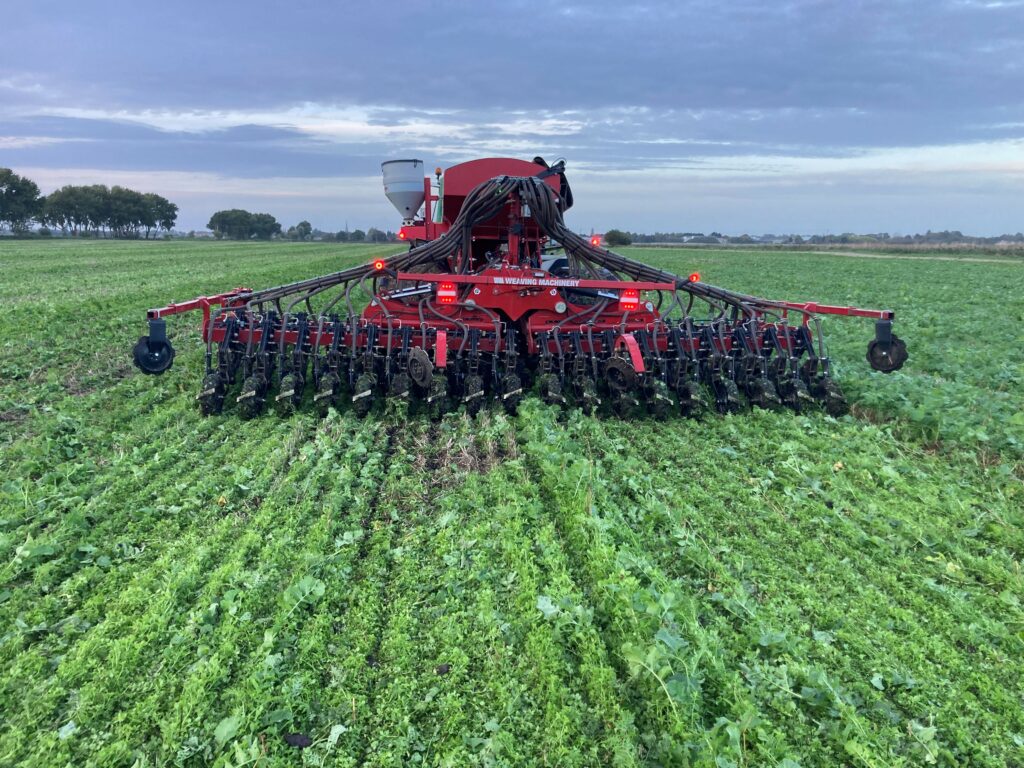
We did some machinery upgrades this summer, including upgrading our 26-year-old combine harvester for a slightly larger 11-year-old machine, and our 1999 classic John Deere 6910 tractor was sold and replaced with a larger and newer, but still classic 2008 John Deere 7930 in good order which shares all tractor duties with our existing 16-year-old John Deere 7530. The strategy is to do all our farm operations in house, and quickly to allow time for other projects, but with machinery that is not depreciating where possible.
Our wonderful little 3m Weaving GD drill was traded in for a second hand trailed 6m version that had been reconditioned and updated by Weaving and this increase in output has revolutionised crop establishment in autumn 2023. This was very fortunate given the weeks of wet weather, which did give some challenges, but it was great to quickly cover the land when conditions allowed.
We still have a smaller Sabre tine drill, but the GD is generally our first choice, and I spent some time setting it up with SK Sprayers liquid delivery components, utilising the tank and primary plumbing already on the drill.
This autumn has also seen a slightly refreshed direction for strategy and cropping. With our Landlords deciding not to proceed with the planned new grain store build here, and our Farm Business Tenancy racing towards its end in 5 years, we have taken a view to simplify and reduce our cropping, with a new live Sustainable Farming Incentive (SFI) agreement enabling more ‘Countryside Stewardship’ style options than our old HLS agreement had, and also some whole field options rotationally replacing some of our unreliable break crops such as beans.
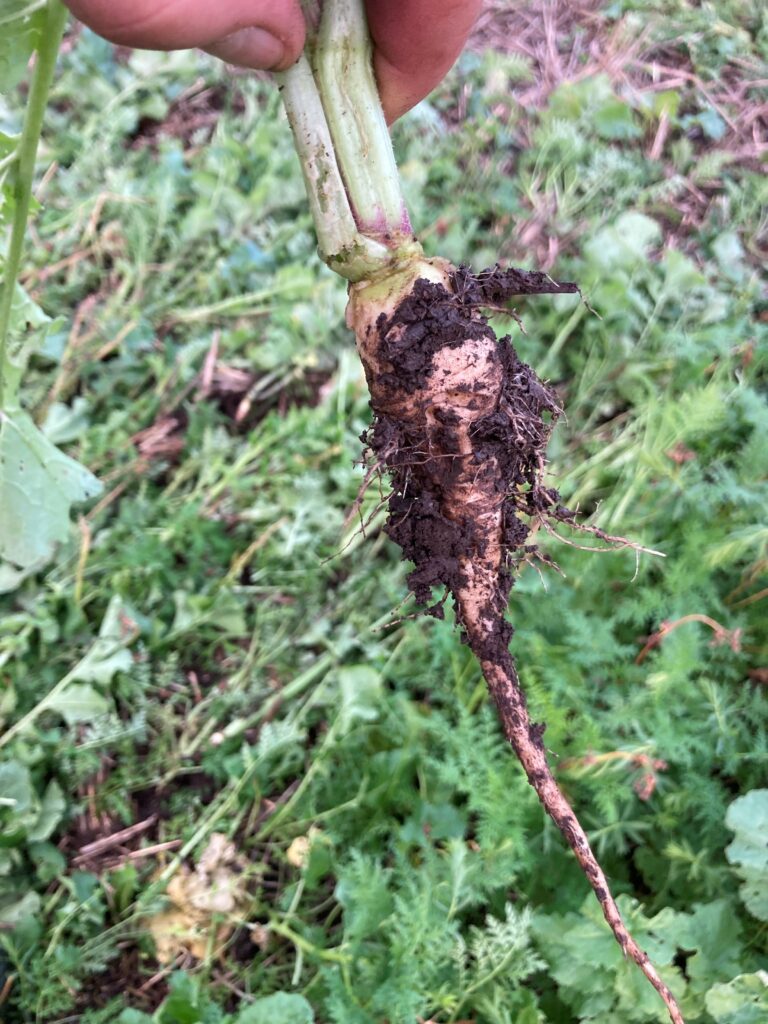
This means that we can concentrate on a larger percentage of first wheat crops and some Mustard as cash crops, and have less storage challenges, while also freeing up more time for our other projects. We also find ourselves conscious that our FBT here is due to end soon, and our sons have pursued non farming careers, so we are making plans and provisions for impending retirement.
This is amazing, as it seems like yesterday that we started farming on our own account in 1989 with a David Brown 62 hp tractor, 2 furrow Ransomes reversible plough, MF 30 drill and a MF 525 combine bought for £1500 that did 6 harvests for us. While I look back fondly on those days, life and profitability is so much better for us without a plough!


-

The scorecard that unearths a soil’s secrets
A full picture of soil health can be captured by a new ‘scorecard’. AHDB technical content manager Jason Pole investigates.
Not everything that matters can be measured. Not everything that can be measured matters. Wise words. Nobody would dispute that soil health matters. Now it can be measured.
The soil health scorecard is the product of a levy-funded partnership that tackled soil biology and soil health. It provides a simple way to measure the physical, chemical and biological condition of soil.
To develop the approach, the partnership identified core soil health assessment indicators that slot in with farm practice, along with the typical benchmark range(s) for each indicator to help reveal if a soil is healthy, getting sick or poorly.
Physical indicator
Visual evaluation of soil structure (VESS): For VESS, a spade-sized block of soil (about 30 cm deep) is levered out, leaving a side undisturbed to show topsoil structure. Assessments involve allocating a soil quality score by following the guidance in AHDB’s new ‘How to assess soil structure’ factsheet (which is laminated for use in the field). Where horizontal layers are identified, the worst-performing (limiting) layer is assessed.
Chemical indicators
pH: A soil’s pH affects its chemical (e.g. nutrient availability), biological (e.g. microbial activity) and physical (e.g. clay mineral aggregation) properties. It is easily revealed by an indicator test or laboratory analysis, with pH 6.5 to 7.49 the ideal range. Higher pHs may result in nutrient interaction issues or trace element deficiencies. Lower pHs, especially under 5.5, require immediate investigation and liming plans adjusted.
Extractable nutrients: A laboratory analysis of a representative soil sample can reveal phosphorus, potassium, and magnesium levels. Compared to England and Wales, Scotland has a different approach to nutrient analyses, which is accounted for in the benchmarks.
Biological indicators
Earthworms: Impacted by pH, waterlogging, compaction, tillage, rotation and organic matter, earthworms are an excellent soil health indicator. A spade-sized soil block is used for earthworm counts. In cropped land, 9 or more earthworms is good and 3 or fewer is bad. The AHDB website includes information on how to count earthworms, including ecological groups, and adults and juveniles.
Soil organic matter (SOM): SOM levels depend on many factors, including soil texture, use of organic materials, farming system and environmental factors, such as soil moisture and temperature. This complexity is reflected in the benchmarks, with different values for England and Wales, and Scotland. They also account for soil texture and rainfall region. For organic matter, measuring it periodically (using the same laboratory and method) to determine trends is as important as the absolute value.
Soil assessment tips
Ideally, gather information (observations and samples) for the indicators from representative field zones:
- Every three to five years (at the same point in a crop rotation)
- At the same time of year (warm moist soils in the autumn are often best)
- At least a month after soil disturbance and/or organic material applications
Simply record a centre point for the assessment area and take samples up to 5m away from it at random points. For VESS and earthworms, take three samples (illustrated by the orange squares). For other indicators, take several samples (illustrated by the blue stars).
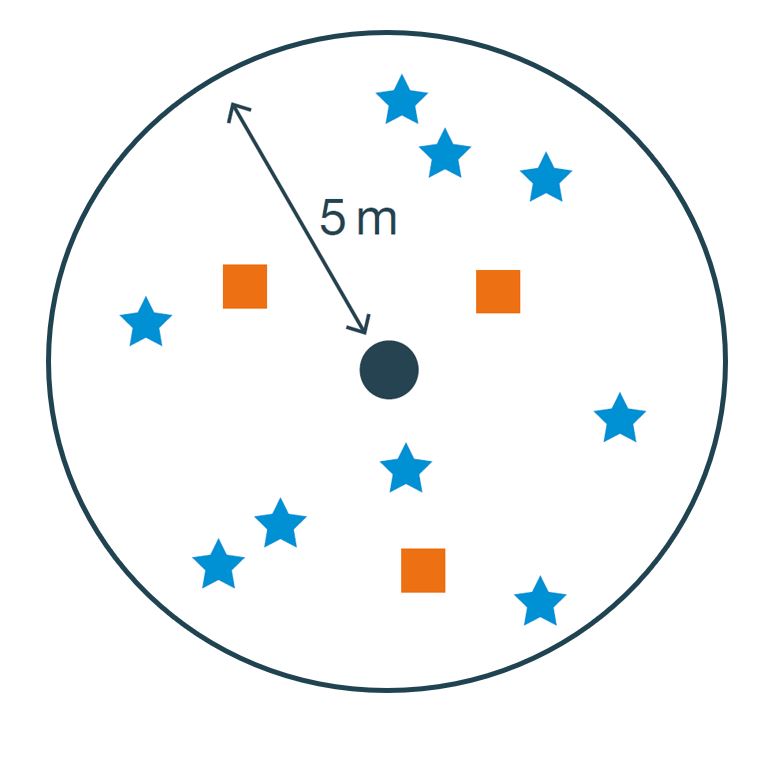
Soil health scorecard
Indicator results (values) can be entered into an Excel-based version of the scorecard on the AHDB website. This automatically assigns a soil status for each indicator: continue monitoring (‘CM’ green), review (‘R’ amber) and investigate (‘I’ red).
In addition to the indicator values, the scorecard also uses three site characteristics – UK region, land use and topsoil characteristics – and features ‘management notes’ for each core indicator and soil status.
The scorecard approach has already been embraced by many AHDB monitor and strategic cereal farmers to:
- Facilitate a routine soil health check
- Identify production constraints
- Evaluate changes to practices
Limavady Monitor Farm
AHDB monitor farmer Alistair Craig
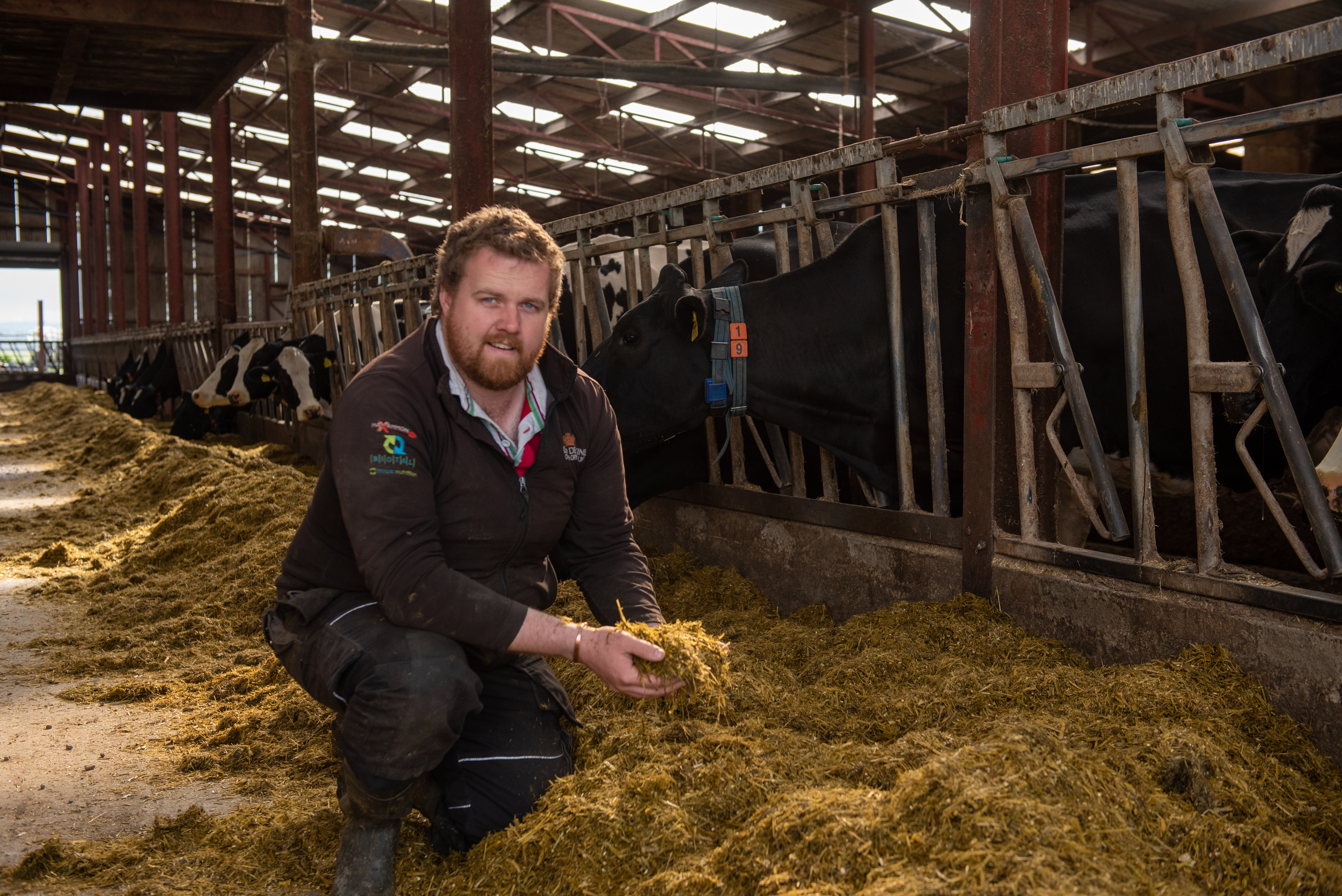
AHDB monitor farmer Alistair Craig When Limavady Monitor Farm (Carsehall Farm) joined the AHDB network in 2022, Farm Manager Alistair Craig was already on course to harmonise the two sides of the business – a fifty–fifty split between dairy and cereal enterprises.
The farm (in County Londonderry) has around 120 ha of land on the sandy loams associated with Lough Foyle – a large tract of land reclaimed from the sea – and a further 80 ha on clay loam soils.
Alistair already put the farm’s manure to good use, reducing the fertiliser requirements for his arable crops and boosting SOM levels. It was a good start, but he wanted to go further and pinpoint the causes of poor crop performance in some fields.
In mid-November 2022, soil assessments were done at six sites, with scorecards used to help analyse the results. Alistair found VESS particularly informative. No soils were in a poor condition, which was a surprise. For example, sample site 1 was in a field previously used to grow potatoes, which was assumed to be in poor condition.
During the VESS, the field had Alistair’s first crop of winter oilseed rape companion cropped with a mixture of spring beans, sunflowers, vetch and buckwheat. The average (across three samples) VESS score was 3, which put the field in ‘moderate’ condition. It was not as bad as expected, and rooting was far more extensive than feared. The cropping diversity had already started to perform its magic on the hard-worked land.

Rooting at sample site 1 The field also performed relatively well for other indicators, including the highest earthworm number recorded across the six sampling sites. Most (68%) of these earthworms were young (juvenile), which may indicate that the population was bouncing back from previous cultivations.
When Alistair saw the extent of the rooting, the high number of earthworms and the positive results from the laboratory analysis, he decided to sow the companion crop mix on a third of the farm in the 2022/23 growing season.
Encouraged by the soil structure assessments, Alistair used VESS on other fields. One was in poor structural condition, with very few pores and roots, after growing potatoes for two years. The field was planted with cereals in autumn 2022, which performed poorly. Alistair said: “Looking at the soil profile, it was not hard to see why the crop struggled to grow in this field.”
It was a cry for help, so Alistair reviewed the rotation to help the field recover. He took the field out of cereals and grew an eight-species cover crop mix, followed by a cash crop in the spring.
Other issues
The scorecard highlighted many areas that required attention (see the table, below), including some indicators that warranted immediate investigation (I) in some fields. For example, some of these red flags were associated with low earthworm numbers and nutrient levels far beyond the optimum for the soil.

Soil assessment results at Limavady Monitor Farm in soil health scorecards. All combinable crops, except sample 3 (permanent pasture). Scorecards also show results for indicators of microbial activity.
Alistair will continue to routinely review soil health, which will help monitor the impact of the boosted companion crop area. A full soil health scorecard review will also be done in the Monitor Farm’s final year.
Use the scorecard
The scorecard, which was funded by AHDB and BBRO, can be used for UK’s main cropping and lowland grassland systems. To access the scorecard and instructions, visit ahdb.org.uk/scorecard


-
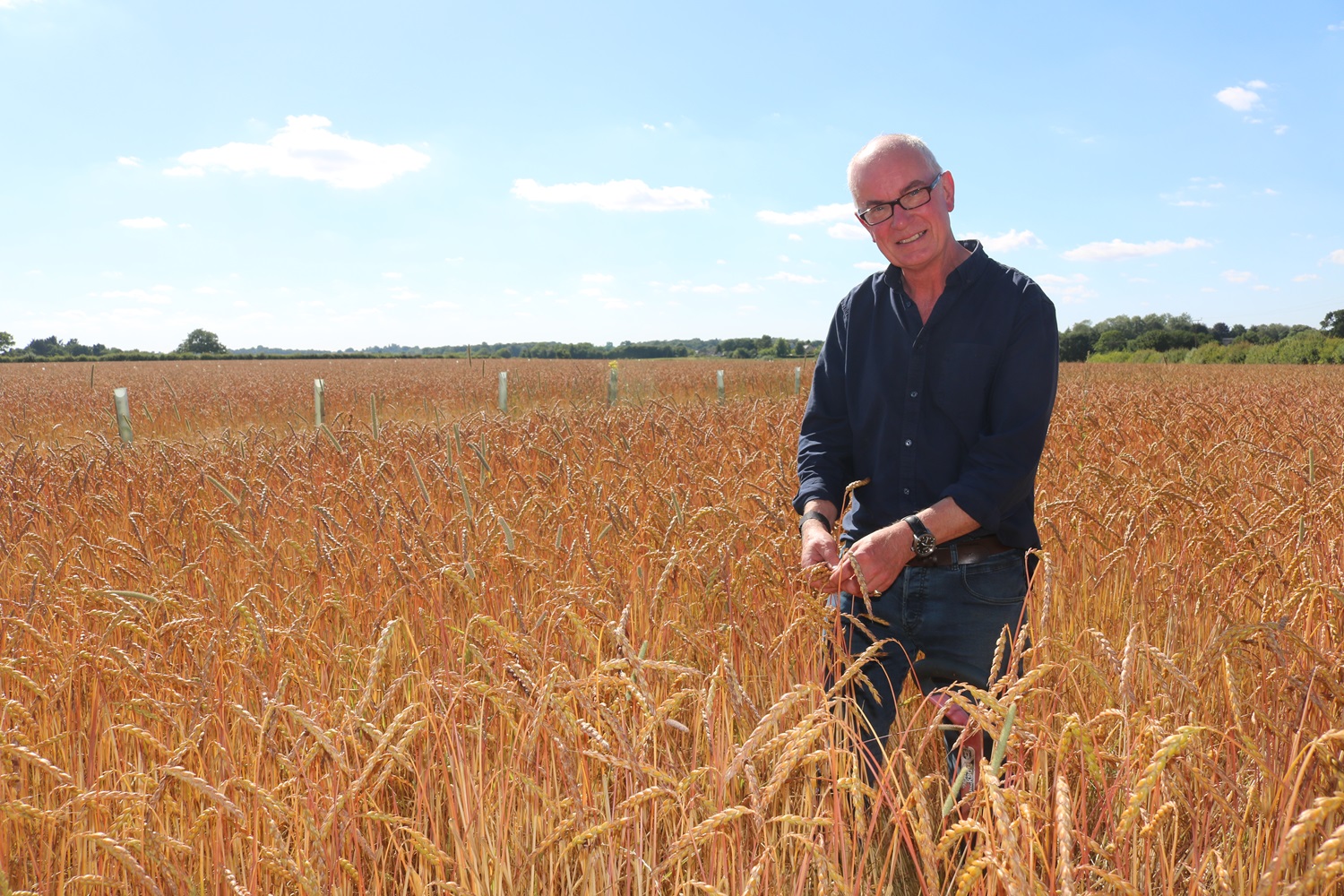
Farmer Focus – John Pawsey
Dec 2023
To Certify or Not to Certify, that is the Question
I was fascinated by Helen Browning’s reply to the leading question in a session at this year’s Groundswell entitled, “Is it time to certify regenerative farming?” Given Helen’s position as Chief Executive of the Soil Association and her role as a board member of Soil Association Certification, I was surprised at her answer which was, “No”.
Coming from the Queen of all things organic and me being a loyal subject, I was surprised at her reply given our similar organically certified shackles. To qualify her answer she added that regenerative farmers were still, “Feeling their way”, that they had, “Fire in their bellies” and that certification might “Stifle innovation”.
I brooded on Helen’s leniency.
Organic standards have been preserved in aspic over the time we have been farming under the big ‘O’, so not moving with the times could I suppose lay their rigour bare to the accusation that they do stifle innovation. Over the last few years I have felt that at organic events, my no-pesticide chums have something more akin to a flickering ember in their stomachs rather than a blossoming man’s red flower. Nobody wants to be part of a movement that doesn’t have new thinking at its core, and an excitement for change in the marrow of it’s bones, at least I don’t. I am sure that Helen doesn’t either.
If I had a penny for every farmer who said when contemplating exiting organic farming, “If I stopped organic farming I wouldn’t go back to my old conventional ways, I’d take the best of what I’ve learnt from organics and use it alongside the best of non-organic methods”, I’d have about fifteen pence. But Helen’s take on the excitement at that Groundswell session did get me thinking about the possibility throwing my hat into the ring with part of my own farm to try a bit of organic-lite, or regenerative agriculture. Everyone wants to be in with the in-crowd. I know, I’m so shallow.
There is much debate about what regenerative agriculture actually means and everyone seems to be interpreting it differently, so it is difficult to know how to approach it when thinking about what I might be aiming for. So to help me with the conundrum I consulted the oracle, ChatGPT.
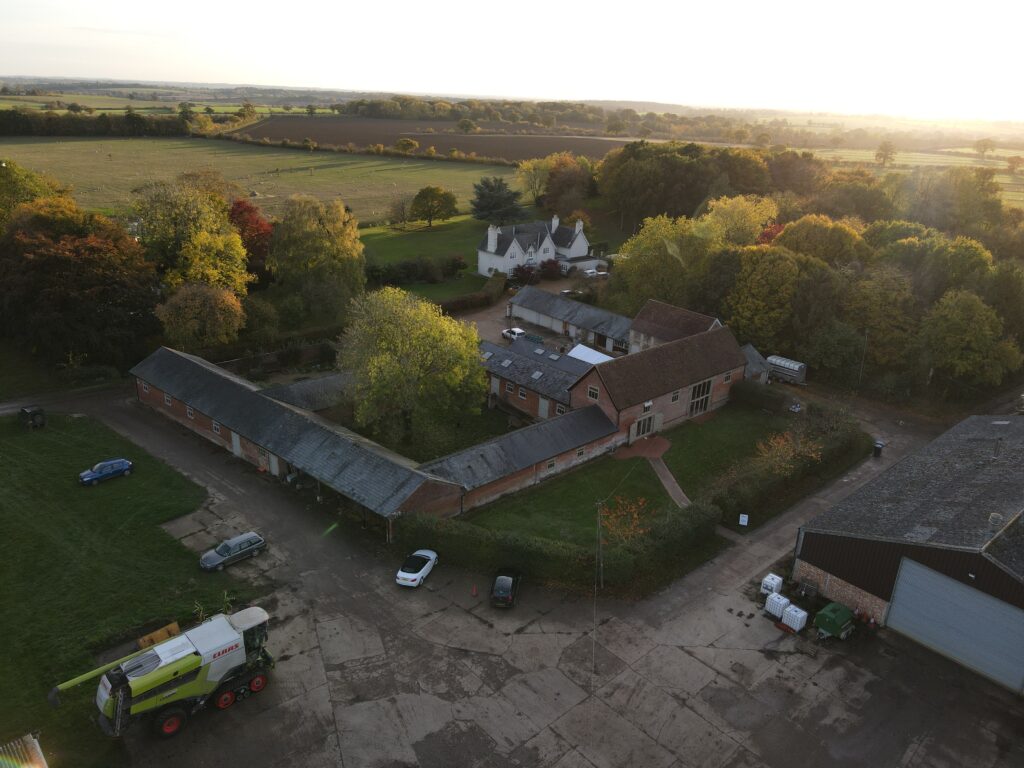
default I posed the question, “What are the principles of regenerative agriculture?” I used the word ‘principles’ rather than ‘standards’ as I tried principles first and got the reply, “Regenerative agriculture does not have universally standardised criteria like organic farming”, but we will discuss the pros and cons of ‘standardised criteria’ later.
The generated reply said this, “Regenerative agriculture principles focus on improving soil health, biodiversity, and overall ecosystem resilience. Key principles include minimising soil disturbance, maximising plant diversity, keeping living roots in the soil, integrating livestock, and prioritising organic matter. These practices aim to enhance soil structure, water retention, and nutrient cycling while promoting sustainable and resilient farming systems.”
It all sounded pretty organic. An ‘aim’ sounded workable too. We didn’t quite get there, but we tried kind of thing.
Most of the principles are already fully adopted at Shimpling Park Farm. We have lots of plant diversity with green manures, herbal leys, varietal mixing and multispecies-cropping. There are very few times of the year when there are no living roots in our soil, as in practice we never manage to get rid of 100% of our unintended plants even with cultivations. Post harvest there is always a mat of rare arable weeds (I keep telling myself that they are rare to make me feel better) that always do well in the pre-harvest light of a senescing crop. Sheep were re-installed on the farm in 2014 ticking the livestock box. By default all of the above has resulted in the prioritising of organic matter which has increased on the farm twofold over the last twenty years.
Transitioning from an organic system to my mind would only be enhanced as far as regeneration principles were concerned by less soil disturbance. Having said that, with only appropriate soil movement, I feel that my current system is improving soil health, biodiversity and ecosystem resilience, all three focuses of regenerative principles. My only reason for wanting to move less soil is because of the enormous cost of doing so in terms of power, machinery and labour. It is an ever increasing input.
But I have a dilemma. Less soil disturbance does equal more weeds and not having used any herbicides on the farm since we converted our last field to organic, I couldn’t possibly bring myself to use them again. Killing the diversity that we have built up in our fields in terms of plants (you say weeds), the insects that they host and the food chain they in turn support, is not going to be a thing for me. I especially couldn’t use glyphosate. It is the ultimate weapon if you are wanting to eliminate living roots in the soil. There is nothing regenerative about a systemic weed killer.
So, that sticks me right back into the organic camp, their rigorous standards and having deal with stifled innovation and a dwindling fire.
But do standards stifle innovation? Is my fire really dwindling?
Actually, it’s quite the opposite.
Standards, especially ones governed by a legal framework, force you to innovate. They are the mother of invention.
Saying no to herbicides, wanting to do less cultivations and expecting more weeds (see plants above) has certainly made us innovative. In terms of understanding how crop architecture smothers weeds through crop height, leaf shape/shade, early vigour/even germination and multi-species cropping using a range of heights and shapes. Using longer and highly diverse rotations with a range of inter-seasonal sowing dates. “It’s not the plough, it’s the how” (credit to Tim May #Respect), how low do you need to go? Getting under the skin of weed life cycles, rooting depth and discovering the most appropriate cultivation to deal with the specific issues you’ve got. Appreciating the damage that any intervention does and knowing how to put it right. Experimenting with grazing crops, cover crops and leys. Balancing what’s best for the grazing animal and what’s best for the soil. Discovering and trialling/improving/making novel weeding machines. Dealing with the Home Office to try and get your loyal Polish rogueing team back into the UK post Brexit. The list goes on.
The same complexity applies when dealing with pests, diseases and building fertility. There is no silver bullet.
This is not 365 days a year farming. There’s no ability to switch to a different part of the farm to start all over again because you’ve made some mistakes. The choice is de-certify or do better. To innovate. This is creative stuff. This is systems based farming. Its generational. You have to have fire in your belly to make it work.
I mentioned that organic standards have been preserved in aspic since I’ve been farming. I am not going to pretend that there aren’t areas that I think need looking at, but by not changing standards means that our customers know what they are getting. We are constant. It’s something that they can trust. They know what the deal is.
Going back to ChatGPT I asked what the difference was between a principle and a standard:
“A standard is a specific and detailed criterion or guideline used as a measure or reference. It serves as a basis for evaluating or comparing things. On the other hand, a principle is a fundamental truth or proposition that serves as the foundation for a system of belief or behaviour. Principles are more general and guide the development of standards. In essence, standards are specific rules or norms derived from broader principles.”
Helen Browing might be right at this moment in time but don’t be “Feeling your way” for too long.
It is impossible to compare the outcomes of regenerative principles because everyone is doing something completely different and everyone is calling themselves regenerative, and it’s a problem. It’s a problem for you, because it will associate you with someone less signed up to the cause and it’s a problem for your customer because there will be no certainty in what your product promises. They certainly won’t pay you any more money unless it you can independently prove it is what you say it is. You might be able to sell yourself as an individual but not as a collective movement.
You have to be able to evaluate the benefits of your system and communicate those benefits to your customer, and you can only do that with certification based on trusted developed standards which mean something. If you can’t do that, your customer will loose trust, and then you don’t have a business, you’ve got a hobby.


-
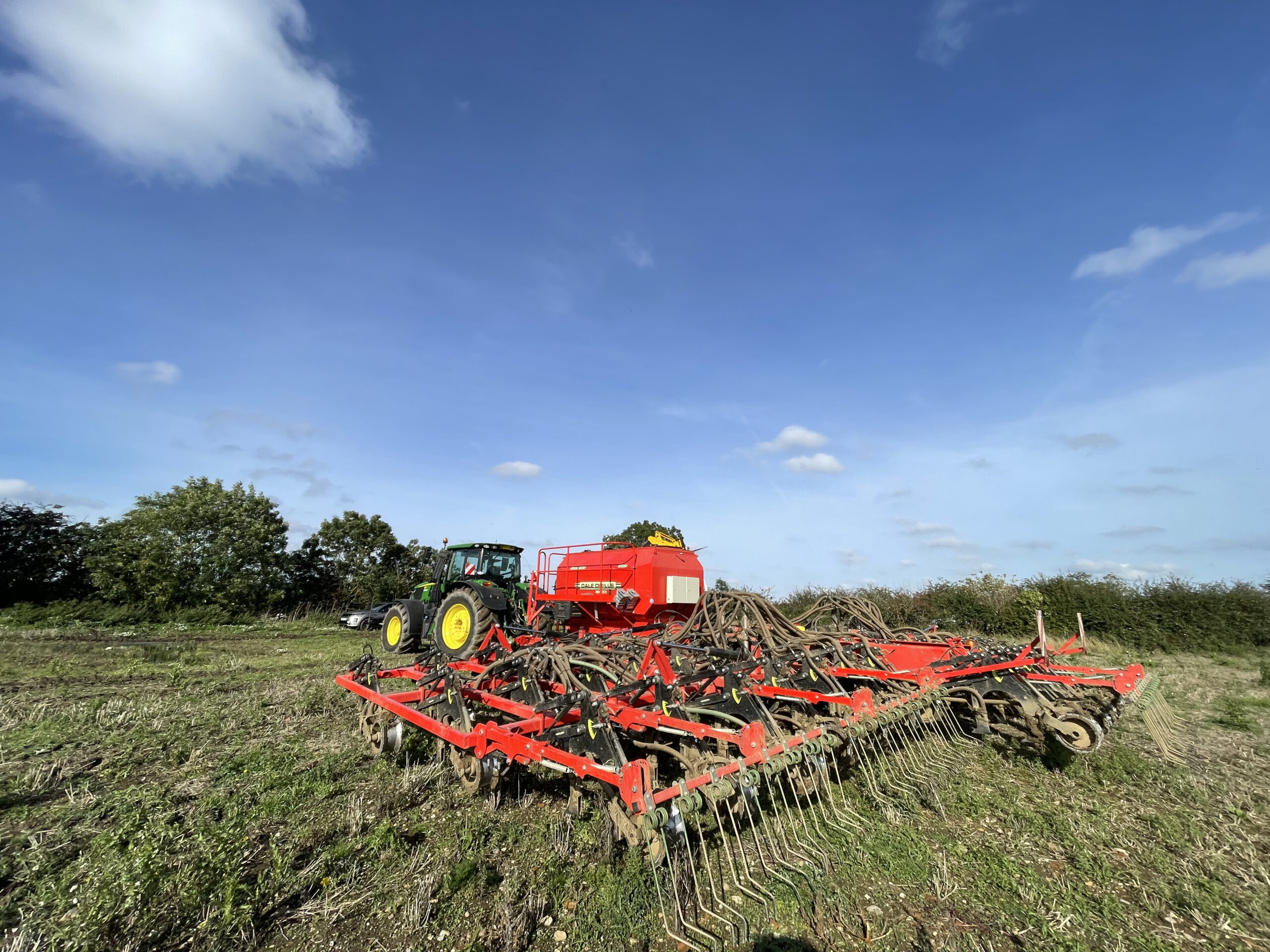
Drill Manufacturer – Dale Drills
12m Eco XL

Joe Adams – Farmer Joe Adams farms 2200 acres between Daventry and West Hadden in Northamptonshire. Thrupp Farms Limited are in the 5th year of growing continuous wheat and took delivery of the 12 meter Dale Drill Eco XL in 2021. Joe explains the reasons for moving away from a traditional plough based system to using the Dale Drill Eco XL and the benefits they have experienced across the farm since starting direct
drilling.‘One of the biggest advantages we’ve found from moving away from ploughing and power harrowing, is the time saving, it took months to plough and prepare the ground’ Moving the farm into continuous wheat cropping meant that there was more work to be undertaken in a limited amount of time. Being able to drill straight into stubble has not only sped up the drilling process but saved the farm significant costs in both fuel and wearing parts expenses.
‘In two years of ownership the Dale Drill is still on its original points, being a tine drill, we also use it for some light cultivation where necessary, we’ve yet to spend any money on wearing metal for the drill.’ ‘In terms of fuel savings, we reduced our diesel usage by 76,000 litres last year’ which by anyone’s calculations is a huge saving both financially and environmentally. Running a controlled traffic system, a wider drill helps reduce wheelings. Having tried other tine drills during the purchasing process, the Dale Drill seems to require less horsepower to pull it.
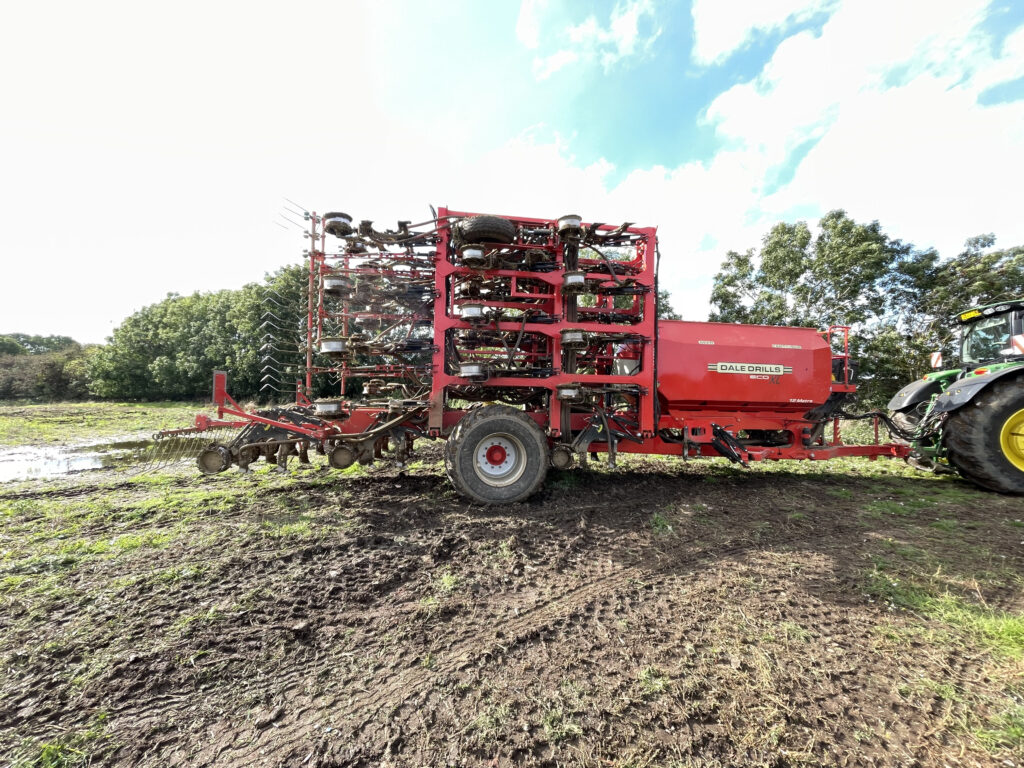
The farms John Deere 6250R is more than capable of handling the worst of the slopes that the farm has to offer. ‘Having trialled 200 acres of plough vs Direct Drilling in 2022 the results were quite interesting, the yield from the ploughed ground was 0.5 ton per acre less than the direct drilled land’ Although Joe thinks this could be slightly influenced by take all from ploughing, when you add in the costs of ploughing, metal, time and fuel, the overall costs of the Direct Drilling are far less than a plough based system.
Joe is very much an advocate for tines vs disc debate. ‘Having looked at both before purchasing the Dale Drill, the main concern of a disc drill is the potential for hair pinning and in wet conditions slot closure, I’ve seen a lot of ground drilled with disc drills in the wet, that as the ground dries out the slots open up. Yes the tines move a bit more soil, but I feel that helps with nitrogen mineralisation it works well in the wet and there’s no risk of hair pinning’ 2023 has been an incredibly challenging season, Joe was able to have drilled all of his winter wheat prior to the weather breaking, had they been using the old plough based system, this would unlikely have been the case, all in part to moving over to the Dale Drill

-
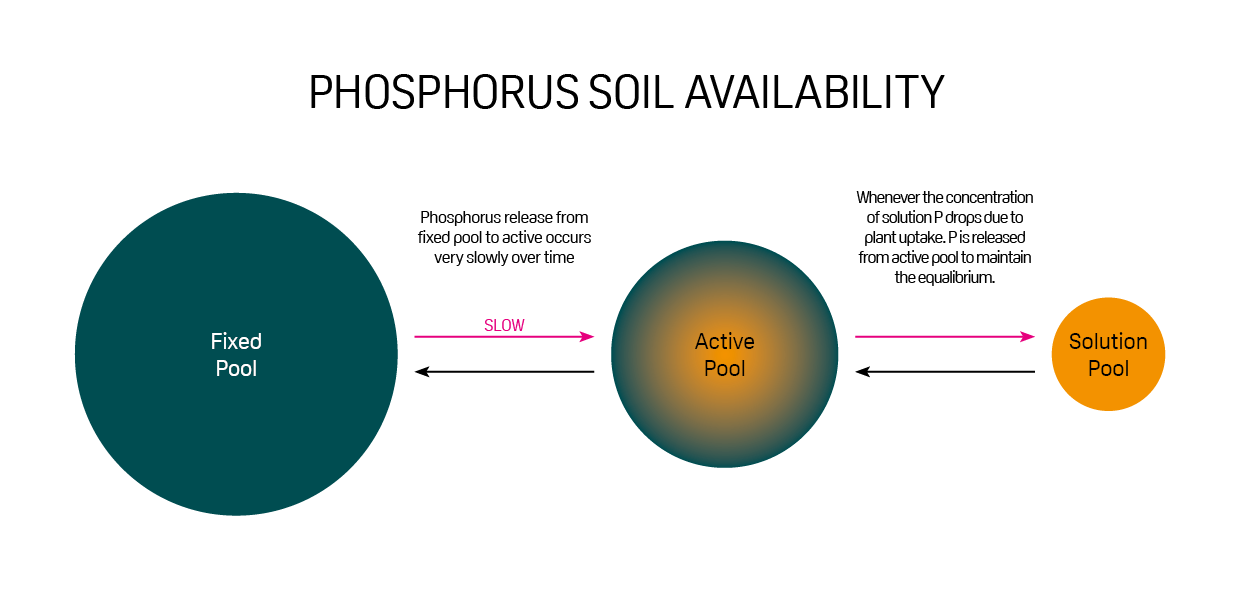
Unlocking Phosphate Potential
Written by George Hepburn from Aiva Fertilisers
With the amount of rain we have had and the poor crop conditions this year, the availability of phosphate is going to be critical to maintaining yield potential. In this article, we will explore the chemistry behind it and how important biology is to release it.
Not only is phosphate vital for the roots and shoots early on, but it’s also needed throughout the growing season. It acts as the engine of the plant, creating energy for many critical processes.
According to the latest science, when Phosphorous is applied as phosphate, the majority of the nutrient is ‘locked up’ by the anions in the soil. This makes the application of P without a carbon source highly uneconomic, and as the index builds in the soil, the availability to the plant diminishes.
Most soils in the UK have significant reserves of phosphate, somewhere around 3-5000 kg/ha (3-5 tonnes) in the top 6″ and more below that if you have the depth of soil.
Phosphate issues have been seen in a soil index of 3, but no issues in the crop or tissue tests on an index of 0. There are even soils with a P index of 6 where foliar P must be applied to get some into the plant. It’s crucial to keep an eye on pH to ensure phosphate availability, as evidence shows that it’s significantly affected by pH.

At Aiva, we have the advantage of using a foliar P where the soil pH has no effect at all. The plant is fed directly, bypassing the soil entirely.

The diagram above shows how Phosphate is stored in the soil. It’s held in three pools. Soil reserves (approx. 3-5000 kg/ha), potentially available (500 kg/ha) and plant available (50kg/ha).
When you apply P fertiliser, it’s not in a form that the plant can take up. Within hours, or sometimes even minutes, it’s complexed with calcium, iron or aluminium and becomes part of your soil reserves. So rather than increasing your plant available P, you now have a bit extra in your bank, but you cannot access it. That’s why being able to use a liquid P that has a positive charge as opposed to a triple negative, is much more beneficial and efficient. It means that this P will not lock onto the soil and remains very available to the plant.
Unlocking your phosphate reserves is possible through soil biology. These microbes solubilise the phosphate and release it to their symbiotic partner. Instead of applying more fertiliser, we need to allow these microbes to thrive by giving them the right conditions. These microbes are aerobic, so having the correct balance in the soil of minerals, air, water and OM (carbon) is paramount. Tight or compacted soils will not release P in the same way, hence the need for fertiliser to bridge this gap.
The microbes need to be fed once they are in the right conditions. Many fertilisers turn these beneficial bugs off. Using a carbon source like humic or fulvic acid, fermented molasses, molasses, seaweed, compost, or FYM can help to stimulate the soil biology and release phosphate that was once locked up in the soil.
Adding microbes can also help release ‘locked up’ phosphorus and make it plant-available. The AIVA product BIOPLUS T has specific phosphate-solubilising bacteria that work to release Phosphorous from the soil. However, like any biological product, soil conditions, temperature, and moisture need to be right to get the most from the product.

If your soils are truly low in phosphate, then an organic input is recommended. FYM, compost, digestate, or sludge all come
swith added extras in the form of other nutrients and will stimulate your soil and improve fertility. Unlike traditional ‘fertilisers’ like TSP and 20-10-10, it’s crucial to consider the unit cost of P when deciding. So, get the calculator out and go from there.
-

Damage limitation and root support for flooded crops
Featuring John Haywood from Unium Bioscience
With rainfall totals reaching the highest recorded since the year 2000, many winter crops have been in standing water for prolonged periods. Research indicates that the longer winter crops are exposed to flooded conditions the more significant the impact, as one might anticipate.
According to experts, supporting roots in the early spring months will be crucial to mitigate the flood damage and encourage phosphorus and nitrogen uptake.
Flood damage to winter crops explained
The oxygen deficit caused by flooding can have multiple knock-on effects for winter wheat crops, according to John Haywood at Unium Bioscience. “Effects include impaired root growth (potential death), reduced metabolism, lower nutrient availability and absorption, higher risk of nutrient leaching, shoot growth impairment, compromised tillering and ultimate yield.
“The decrease in Photosynthesis (PS) will cause an increase in Reactive Oxygen Species (ROS). These are the main reason for reducing yields, which when out of balance will potentially cause irreparable cell damage further limiting growth and development and ultimately crop potential,” says John.
Malik et al reported reduction in tillers (bread variety) of 24, 45 and 62% depending upon water level below the surface 20, 10 and 0cm. “We can see at is stands we are likely to produce a lot fewer tillers – this also has implications on root production especially for wheat, which has a knock-on impact on leaf area, tillering, reduction in spikelet, grain numbers and grain weight – all the major plant processes,” says John.
Effects on the soil
“In terms of impacts on the soil, as the field capacity increases, and the soil becomes more waterlogged more pores become filled and the optimum moves from a 50:50 ratio (soil to air) to a 75:25 which is a reduction of 50% with severe implications on root growth. This impedes gas diffusion,” says John.
Oxygen Partial Pressure % Uptake of P (a) Uptake of K (a) 20 Field Capacity 100 100 5 Saturation 75 56 0.5 Waterlogged 37 30 Hopkins 1950 (a) Data represents relative values “Plants tend to prefer nitrogen (N) in the nitrate form but under waterlogged conditions the balance in the soil favours ammonium levels due to a reduction in gas diffusion,” explains John.
Effect of transient P stresses on nitrogen uptake, 2-day P stress
uM uptake/g DW roots/min Sufficient P (+P) Deficient P (- P) Ammoniacal N NH4 1.8 * 0.8 * Nitrate NO3 0.9 0.2 Megaheas et al 2000 Jnl. of Plt Nutrition, 23(2) 263-273
The pH of flooded soils tends to move towards neutral which can have implications on the nutrient solubility, soil movement and ultimate bioavailability (plant uptake – levels and rate of uptake). “Therefore, multiple effects can happen and impact growth and development depending upon your starting point.
“As the soil becomes more waterlogged the uptake of P and K is massively reduced, which then compounds the nitrogen stress,” he says.
“But all is not lost. It’s important to understand these impacts, so that you can take steps to support root growth and nutrient uptake in the late winter/early spring months.
“We know you cannot make a poor crop into a fantastic crop, but you can make a substantial difference with judicious and cost appropriate inputs,” adds John.
How can biologicals support flooded roots?
Biologicals have a part to play in general crop health and keeping them in the mix is important, but maximising root growth post waterlogging will aid recovery, as will supplying and making the critical nutrients available, including phosphorus.
“The most important aspect to consider with nutrients such as phosphorus, is availability. For phosphate, it exists in three pools in the soil but only the inorganic form dissolved in soil water is readily available to the plant,” explains Unium’s John Haywood.
John says that using the biostimulant Calife Extra acts as a ‘scavenging stimulant’ on the plant, designed to improve crop rooting and maximise nutrient uptake, whereas Luxor provides phosphate supply through maximising availability and reducing adsorption in the soil.
“The pidolic acid found in the biostimulant, Luxor (L-GPA) helps a crop to make the most of this availability while increasing nitrogen assimilation. Combining this with the calcium phosphite found in Calfite Extra tricks the plant into thinking it’s phosphorus deficient, so it increases its uptake,” he says.
Calfite Extra
“Calfite Extra from Unium Bioscience is a unique foliar nutrient complex designed to improve crop rooting and maximise nutrient uptake and utilisation from the soil,” explains John.
“It essentially improves the crop’s phosphorus use efficiency, delivering calcium through the leaf into the plant.
“It will encourage extra rooting, and extra root mass, so it’s better able to extract phosphate from the soil,” he says.
Luxor
“Luxor is a nutrient biostimulant that increases phosphorus delivery to the plant. It has a unique complex of ortho and polyphosphate in a humic/fulvic complex to maximise plant availability,” says John.
“Combined with a plant biostimulant (pidolic acid / L-PGA) to enhance nitrogen use efficiency, it increases photosynthesis and carbon fixation and can be applied close to the seed, in-furrow or as a foliar treatment,” says John.
John explains that in combination, the two products support a plant through the early stages of its lifecycle.
“Phosphite creates a healthier root system, more active in terms of exudations which means you improve scavenging and have a better acquisition of soil nutrients especially phosphorus.
“Following the recent high flooding pressure, it’s unlikely growers will want to compromise on cultural controls and IPM best practice, so an application of Calfite Extra and Luxor could help to provide the support that roots will need,” he adds.
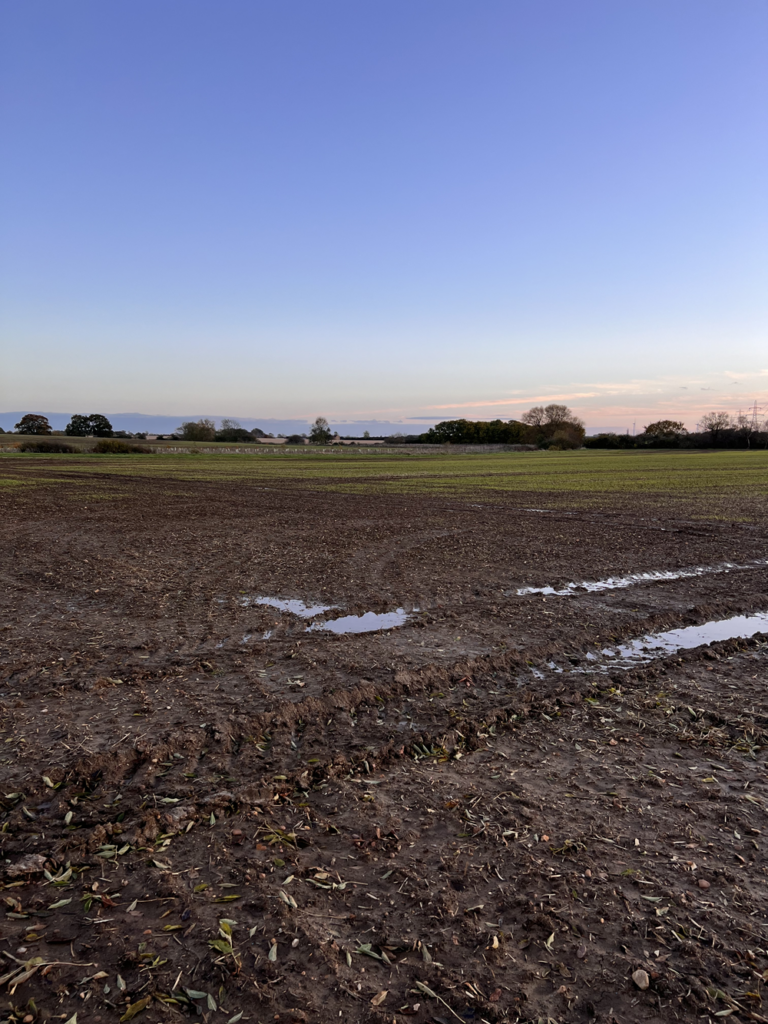
Supporting roots in spring 2024
Agrovista’s technical manager for Scotland, John Murrie, is used to more rainfall than most parts of the UK and says applying biostimulants is a cost-effective way to encourage root biomass and nutrient uptake.
“We’ve had a very wet autumn and crops are struggling for rooting. It will be very important to get these crops going in the spring.”
John explains that interest in Calfite Extra alongside Luxor is increasing year on year on varying crops, winter and spring cereals, vegetables, even grassland. “It can be used on a range of crops and applying it in spring can really help get crops up and running, especially in cold soils.
“It will encourage extra rooting, and extra root mass, so it’s better able to extract phosphate from the soil,” he says.
“It can easily be added to tank mixes and compared to the cost of phosphate in fertiliser, it makes sense to use Luxor and Calfite,” adds John.
With impressive outcomes observed in cereals, oilseed rape, and potatoes, it’s evident that these products have become indispensable assets for both agronomists and farmers.
Cambridge-based arable farmer, Russ McKenzie, has been using Luxor to maximise the availability of P.
“Luxor provides phosphorus either through the soil or the foliage, with both forms complexed with humic and fulvic acid, ensuring the most accessible phosphorus source.
“When combined with Calfite Extra, it stimulates plants to enhance root development and root exudation, significantly increasing phosphorus uptake efficiency,” says Russ.
New biological research
Unium is working hard on biogenomics and how their products impact the regulation of genes – up or down. “We know that waterlogging down regulates ROS detoxification, nitrogen and amino acid metabolism, and anything that can upregulate the production of aerenchyma, photosynthesis, root / shoot biomass, chlorophyll content, and germination rates means that the plant is better able to tolerate the stress as it comes,” says John Haywood.
“We look forward to sharing this exciting development and how the technologies work and then carefully positioning them at the appropriate time to give the most reliable and robust results. It adds a new dimension to biological research and one we are utilising to its full potential,” adds John.
To learn more visit www.uniumbioscience.com.


-
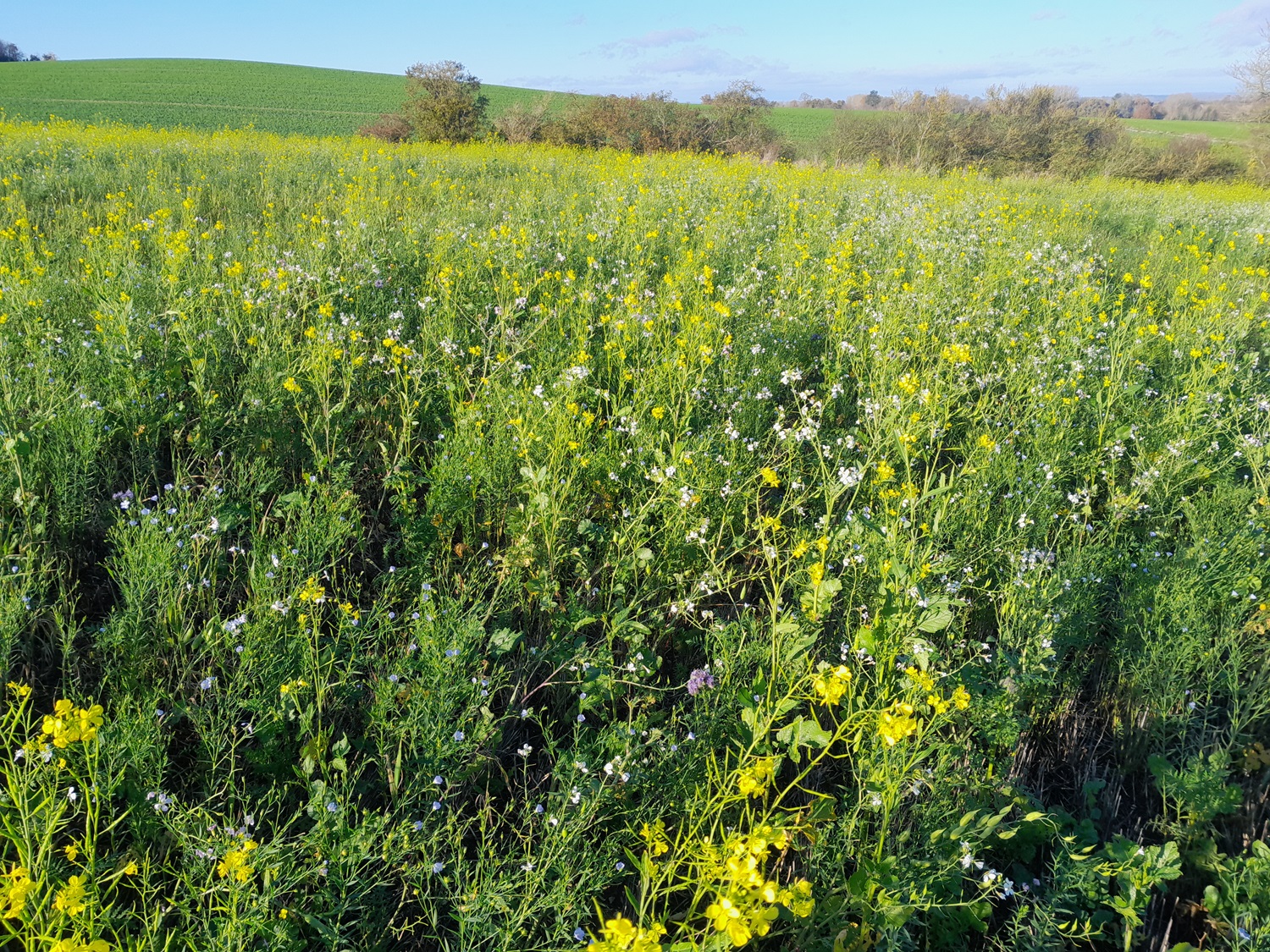
Farmer Focus – Julian Gold
Dec 2023
I had an interesting experience last week when out crop walking on a glorious sunny afternoon. Was firstly walking through chest high flowering cover crops which were full of white, yellow and purple flowers, then moved into Oilseed rape crops dwarfed and semi hidden from view by a thick stand of berseem clover companion plants just starting to come into flower.
Suddenly realised that I had butterflies in my stomach along with a slight fizzing sensation, exactly the same bodily reaction that I would get as a teenager if I bumped into a girl I fancied in the school corridor. Strange the effect regenerative agriculture can have……. ( cant say industrial agriculture ever got me that excited!)
Every year seems to be different re-cover crop germination and growth. With good soil moistures this year was expecting bumper crops but most have been disappointing apart from the early August drilled ones. Later drillings have never got away properly apart from the headlands on some ( usually put better headland growth down to the double rolling effect in dry seasons).
Poor cover crops are massively disappointing as it is a missed opportunity to really give soil health a great boost. Especially galling considering we have a relatively high seed cost with our multi species covers and also go some effort to establish them properly. (Drill large seeds first and then broadcast small seeds behind drill with avadex applicator, followed by Cambridge rolling the whole lot in).
As previously mentioned in the last report, we carried out some N efficiency tramline trials for ’22-’23 crop year. Results were a bit inconclusive but I can report some summarised results ( With the caveat that these should be treated as anecdotal results not replicated ,statistically checked results.)
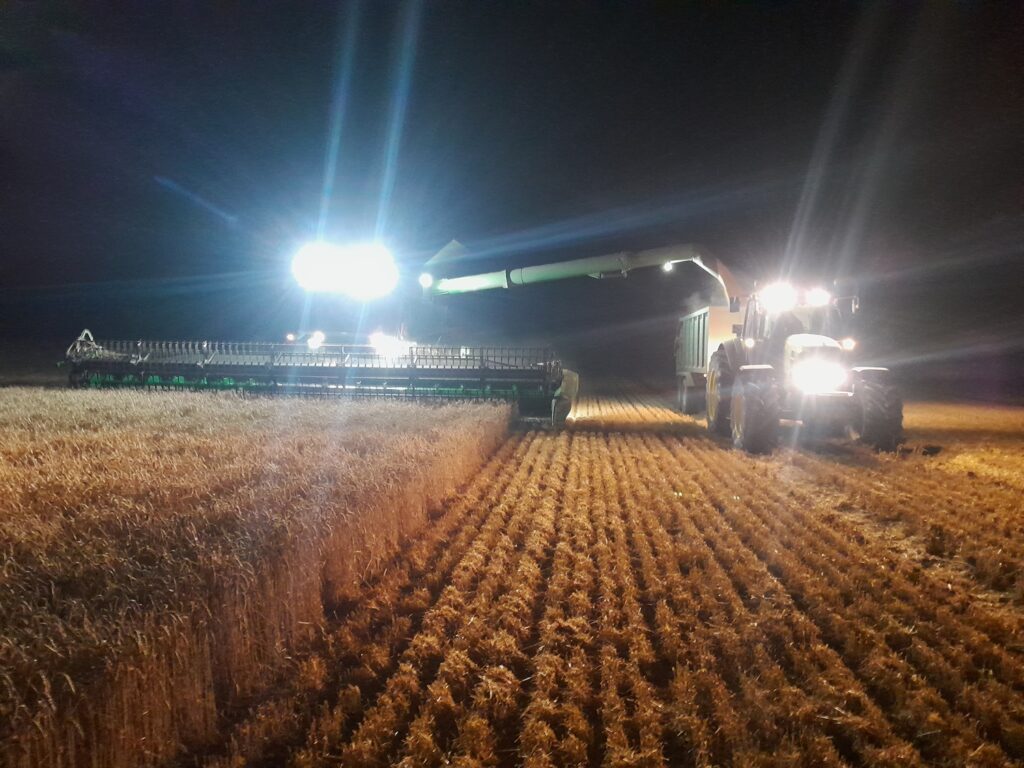
Obligatory combining picture! QLF BOOST : ( Wheat ) Control strip was 190 Kg/Ha N. Boost was applied at various rates on strips that had either 160,170 or 190 Kg/Ha N. All Boost treatments were higher yielding than the control ,with the highest yielding strip being 30L/Ha Boost + 190 N. 60L/Ha Boost + 160 N also yielded above the control.. Trial seems to show that it is possible to increase yield of Wheat by applying Boost or maintain yield by replacing some N with Boost.
Blue N : ( Wheat and spring Barley ) Blue N was applied to winter wheat strips which had 190 or 170 Kg/Ha N and to Spring barley which had 107 Kg/Ha N. In wheat the Blue N seemed to increase the yield very slightly on both strips compared with the control strip with just 190KG/Ha N. There was no noticeable effect with using the Blue N in Spring Barley.
SR3 : ( wheat ) SR3 was applied to Strips which had received 170 or 190 Kg/Ha N . SR3 seemed to increase yield very slightly on both treatments compared with control of just 190 KG/Ha N
Amide N : ( Wheat ) Amide N was applied as a foliar spray ( equal to an N rate of 8 Kg/Ha ) on strips which had received 170, 180 or 190 Kg/Ha solid N. The Amide N spray appeared to have a slight positive effect .
Have not calculated any cost /Benefit ratios as the trials were not accurate enough to do this confidently but gut feeling is that I need to look at them all again for a second year .
I am excited to try layering Boost + Blue N + SR3 + R-Leaf on top of each other to see if benefits are additive and then assess the cocktail of treatments against various N rates to see if it could be a viable way of maintain yields with less artificial N ( Trouble is not sure I have a big enough field to run the trial ! )
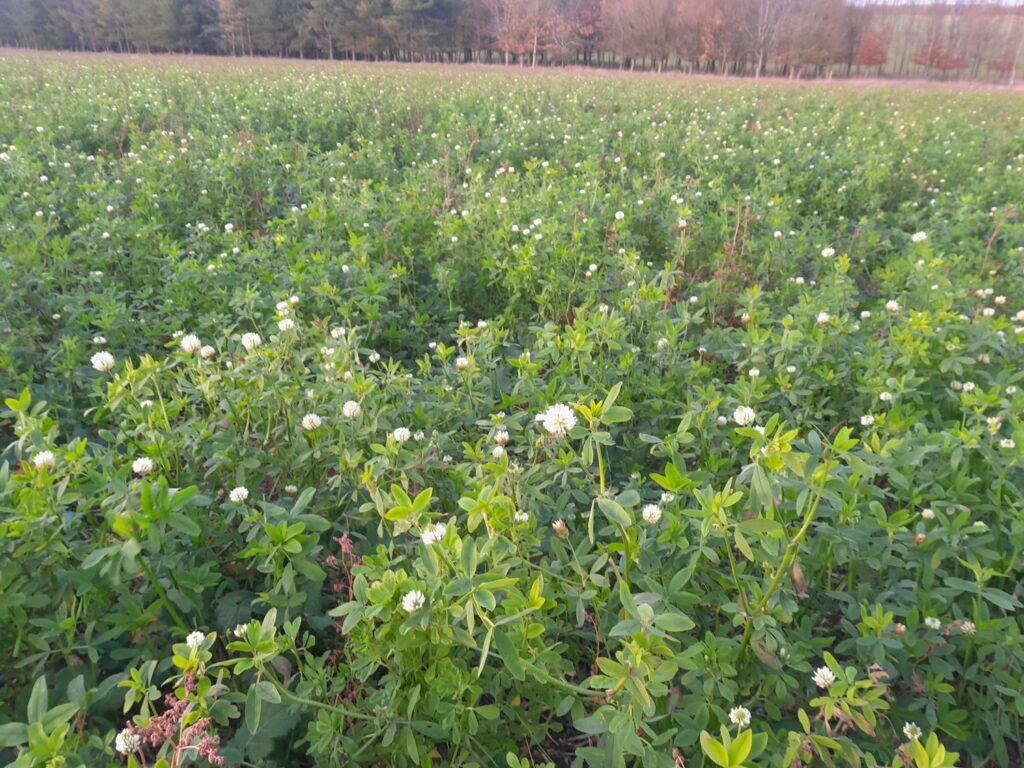
Flowering berseem clover companion crop Cannot really finish my report without commenting on the wet autumn weather.
Our plan had been to do most of the planting with the Horizon disc drill as a way of trying to minimize soil movement and start to make in-roads into reducing our blackgrass burden on the farm.
I had already learnt the lesson last year that disc drills don’t work in the wet on silty clay loams but luckily we were able to switch to the 10m kockerling tine drill when conditions deteriorated and we managed to get everything planted with minimum soil damage.
Having the ability to switch between disc and tine drills massively de stresses planting operations in a minimal soil movement regen ag system.
We also took advantage of the two drills, trying a new (to us) method of establishing OSR and companion crop on one of our OSR fields this summer. In early August we used the Kockerling to plant our companion crop mix of Buckwheat, Berseem Clover and Fenugreek. We followed this by Cambridge rolling and left it to germinate and grow. 10 days later we drilled the OSR into the growing companion crop using the Horizon disc drill ( This caused minimal damage to the companion crop and enabled us to dispense with the need for rolling as the closing press wheels on the Horizon can be pressurised to do a great job firming the soil above the seed. This was not a replicated trial but giving the companion crop a head start did provide a good cover to ‘hide’ the OSR in its early establishment phase and cabbage stem flea beetle damage was negligible( field was next to a field which had OSR in for harvest ’23 and would normally expect damage/crop failures if new season OSR adjacent to previous seasons OSR).
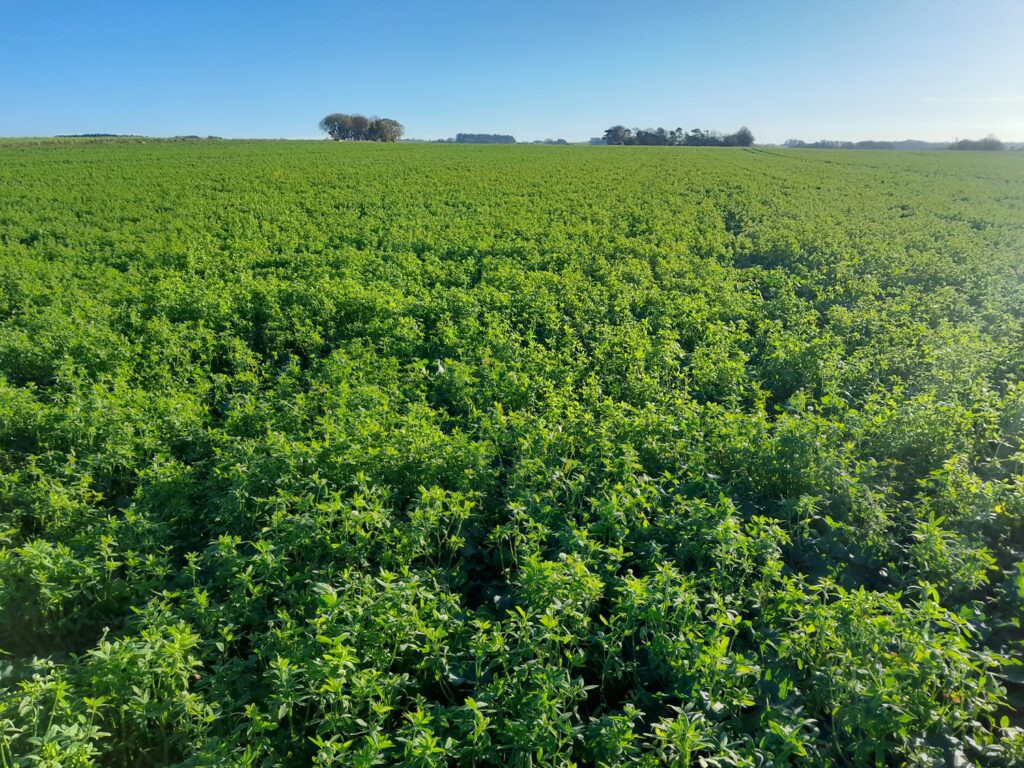
Spot the OSR amongst the Berseem clover One lesson we did learn this autumn (every day is a school day!) is not to roll behind the disc drill if heavy prolonged rainfall is forecast after drilling.( I realise rolling is not strictly necessary anyway behind a disc drill if slots closed properly but we usually do it anyway to max out effectiveness of pre- ems against Blackgrass. ) This year we had a severe crop loss on end headlands on some fields caused by the double rolling effect grinding the soil surface into a fine powder followed by heavy rain causing capping and waterlogging which negatively affected germination of the wheat seeds.


-
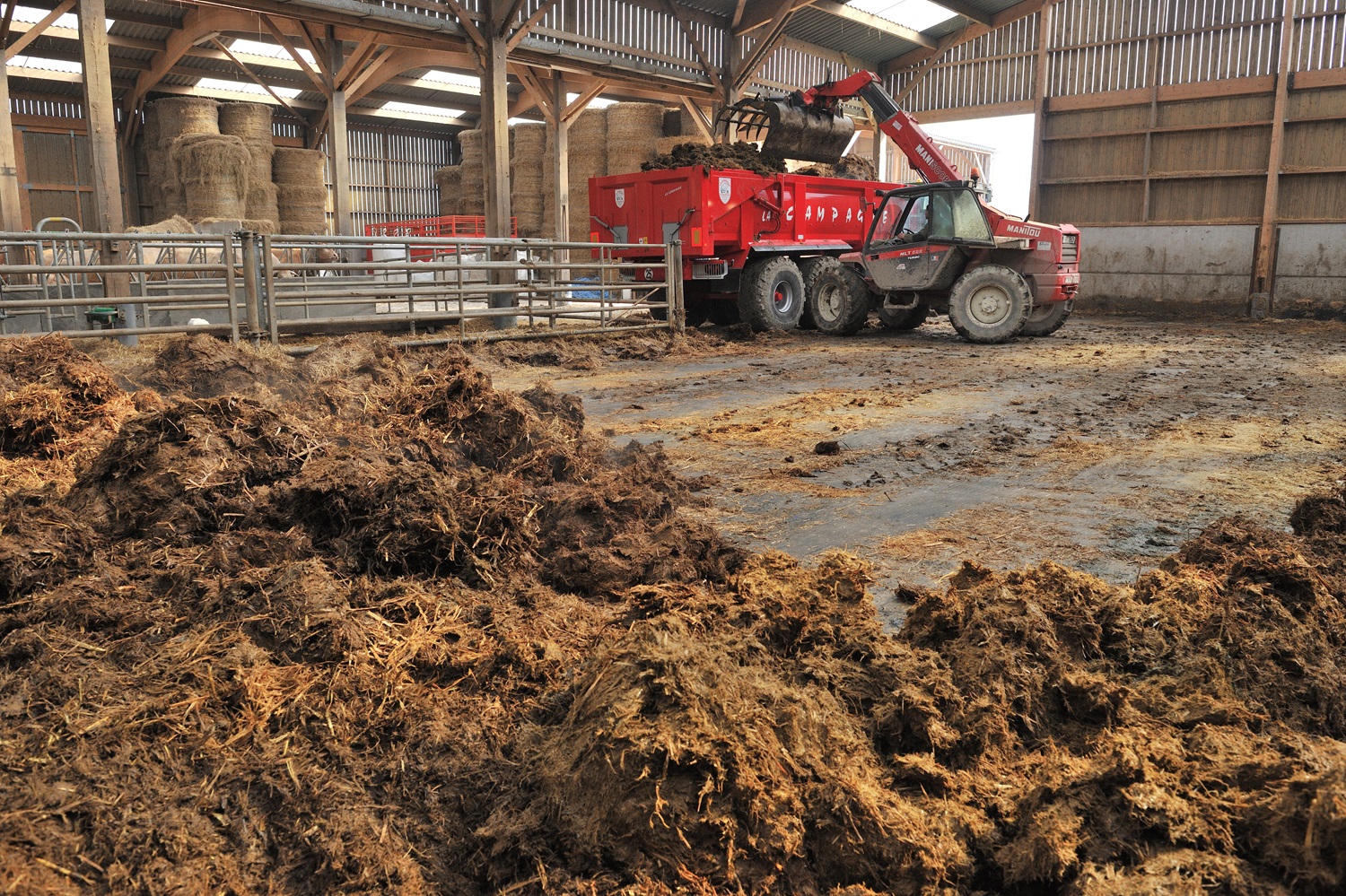
Farming carbon or farming better? – A Nuffield Perspective
My name is Andrew Sincock and I grew up on my grandparents mixed Dairy, Beef and Arable Farm in Cornwall. My first job on the farm was mucking out an old stable that served as a temporary home for new mothers and their calves. The stable was 3 meters wide, roughly 6 meters long and would only be cleaned out once a year. It was regularly bedded with fresh straw, so by the time it came to mucking out, it would be at least 3 feet deep. The entrance to the stable was too narrow for any machinery, so it would be left to me to clean out by hand while I was on my summer holidays.
I did this for several years until I was strong enough to break two long-handled wooden pitchforks while trying to take too much at once. I was convinced I had outgrown this job and would progress to cleaning out calving pens in the loader tractor. You can imagine my disappointment when Geoff, our local handyman, was asked to weld a metal bar to the fork instead of a wooden handle. I was
mortified.Being the stubborn bugger I am though, I was convinced I could break this one too. Try as I might, I couldn’t even get it to bend, let alone break! My Grandad and Uncle would watch me sweating and joke that I would one day receive an award for looking after my pitchfork, just like Trigger did for looking after his broom! What was it, 17 new heads and 14 new handles? Anyway, here I am, almost 30 years later, undertaking a Nuffield Scholarship looking at different Organic Manure management options. I am not sure my younger self would approve.
Although my childhood experience had no bearing on my current Nuffield Farming Scholarship study title, I can appreciate the irony. What I am also aware of, with hindsight, was my complete ignorance in regards to organic manures and their value. This is the real reason why I have chosen to study organic manures and I am hoping that my final report and presentation will remind people of just how valuable they are. When I speak to farmers now, as part of my day job, I always ask which is their best field and is that field the best because historically it has had the most organic manure applied?
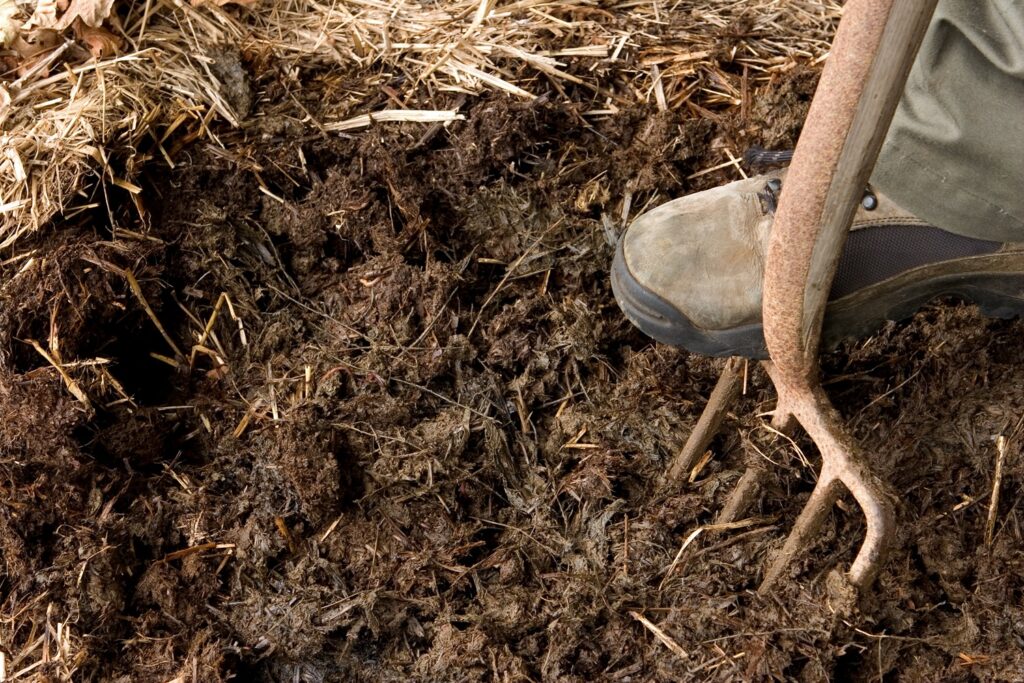
The answer is almost always “Yes!”. Unsurprisingly, it’s usually the field closest to the yard. I believe the value of organic manure was likely realised by the first ever farmer. I am sure the farmer would have noticed that wherever their animals ‘did their business’ the grass would always grow back quicker and greener. You still see it today. Fields are grazed, cow pats are left and sure enough, little green tuffs of grass grow up out of the cow pats quicker than the surrounding area. It would have been a small leap from realising this and using the cow pats to feed growing vegetables and arable crops. Still today, remote African and Indian communities are using cow pats and urine to create fertilisers.
What caused developed countries to move away from valuing and using organic manures? I believe it started with the availability of cheap synthetic mineral fertilisers, the development of chemical plant protection products and the advances in plant breeding, post WW2 world. Don’t get me wrong, these advances helped feed a hungry world and were very welcome but we now know
better. Ironically, this progress started what later became know as the ‘Green Agricultural Revolution’. One tonne of fresh cattle manure with 25% dry matter, according to RB209 and the latest AHDB fertiliser prices, contains £16 in Nitrogen, Phosphorus and Potassium (NPK). When you consider the value of Carbon, Magnesium, Zinc, Calcium and all the other trace elements, your one tonne of fresh cattle manure could be worth upwards of £50. During the peak fertiliser prices in 2022, the same one tonne was worth well over £100!I would go so far as to say that the lack of value placed on organic manures and in some instances the move away from mixed farming has contributed to the degradation of our soils. This is demonstrated perfectly by the organic matter percentages of the predominately arable fields of the east of the UK, compared to the mixed farming and livestock producing west. By putting a value on your organic manures, what you may have previously considered a by-product, once again has value. That value on paper may be significant, but, the real value of organic manures may not be realised this year or even next year. Just as you and your farm is now benefitting from the historical applications of organic manures, generations to come will benefit from organic manure applications applied today.
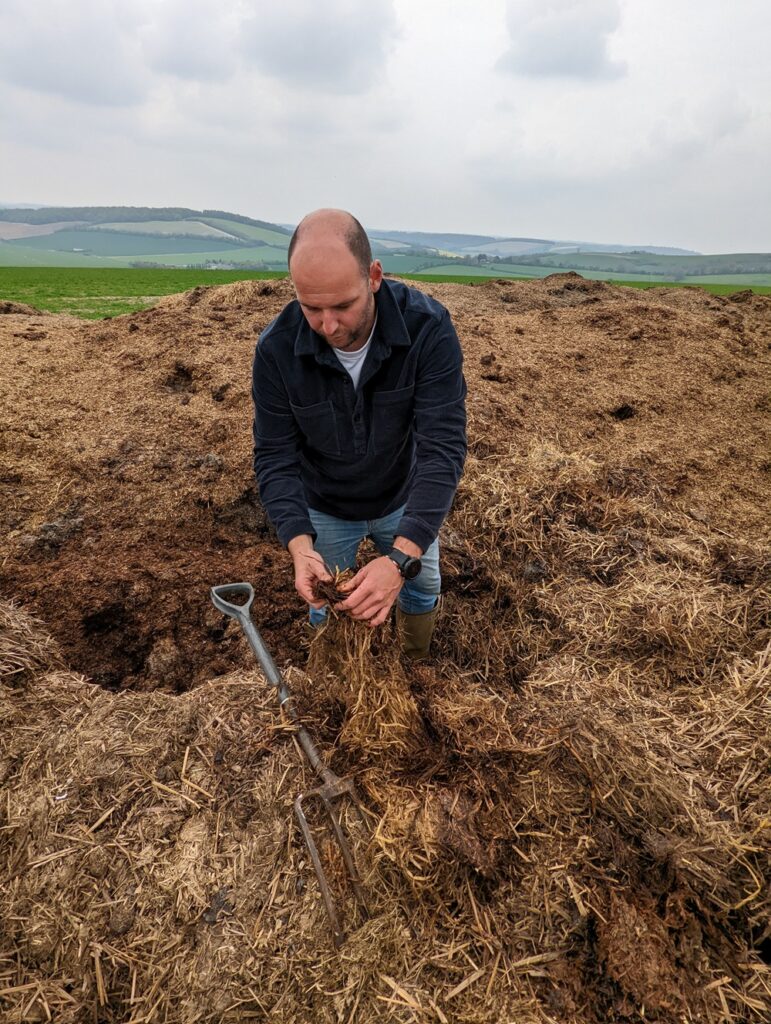
What is the old quote, “If I knew the world was going to end tomorrow, I’d plant a tree today”. The principles are the same, organic manures applied today will benefit you, your soils and your farming enterprise, but not nearly as much as they will benefit the next generation. This is why I value organic manures so much and why I wanted to do a Nuffield Farming Scholarship on the topic. You might not see significant or instant returns from improving or even regenerating your soils, but your children will.
Regular and significant organic manure applications over a number of years will lead to an increase in soil organic matter (SOM) and soil organic carbon (SOC). Combine applications of organic manure with min-till practices, cover crops, herbal leys, mob grazing and cattle grazing and you’ll accelerate the increase in SOM and SOC. This method of farming, and the subsequent increases in SOM and SOC, have been coined ‘Carbon Farming’. This term is one I recently encountered at the annual Nuffield Farming Conference held at Sandy Park in Exeter. For anyone who hasn’t been to a Nuffield Conference before, you should. It was such an enjoyable, inspiring, and informative couple of days that I highly recommend attending if you ever get the chance.
There was one particular session that got me thinking more than the others and it relates to carbon farming and my own particular topic. The session was titled “Regeneration and Net Zero,” and the scholars presenting were:
• Sam Smith – ‘Regenerative agriculture: a shared ambition for the future of farming?’
• Ben Hunt – ‘Can you farm carbon?’
• Chris Taylor – ‘Do Regenerative farming practices pave the way for UK agriculture to meet Net Zero?’The presentations are only 12 minutes long, which is hardly enough time to scratch the surface, let alone delve into the details of what is a minimum of 8 weeks of travel and study. In these 12 minutes, Sam, Ben, and Chris all discussed, either directly or indirectly, regenerative agriculture, the increase in SOM / SOC or Carbon Farming. Sam and Ben approached the topic from a natural capital, carbon credits, and barriers to uptake angle, whereas Chris chose to highlight the soil health benefits and improved resilience—resilience being a word I noted down from all three presentations.
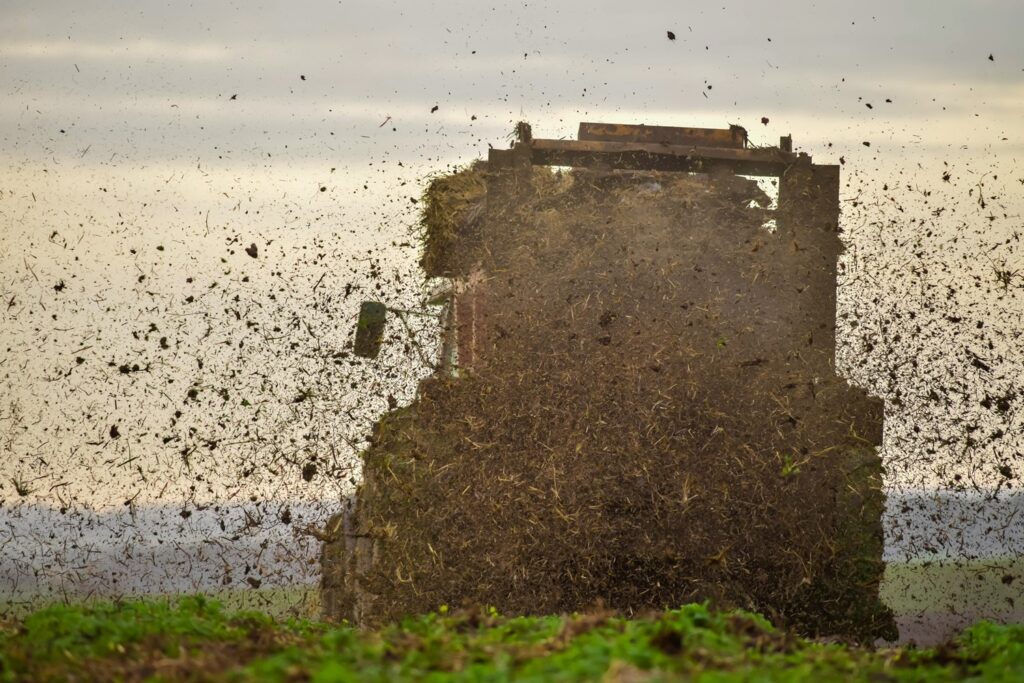
The point I want to make is that in Sam Smith and Ben Hunt’s presentation, they were looking at ways to incentivise farmers for farming carbon. They mentioned some barriers to uptake being the lack of demand, lack of incentives, and lack of information, yet, I cannot help but think that is entirely the wrong way to approach the subject. At the moment, the narrative is around carbon farming to create credits that can be sold, this benefits other industries that know they will never be able to reach Net Zero. Yes, this brings a significant and much-needed injection of money into agriculture, but what happens next? What happens when you need to use those carbon credits to prove you and your farm have reached Net Zero? You may have increased SOM from 3% to 6%, and you may have sold this carbon to an airline, for example. What happens when you need to prove that you too have reached Net Zero and that carbon is no longer yours?
In my opinion, and as Chris Taylor showed in his presentation, carbon farming benefits the soil, the farmer and the next generation. There shouldn’t need to be an incentivise or provide immediate financial reward to motivate a farmer into farming carbon. The increased water holding capacity, improved soil structure, increased soil fertility, and increased microbial activity, should be all the incentive the farmer needs. If that really isn’t enough, maybe the farmer should consider their best field again, why it’s the best field, and who is going to be farming that field next. Every single farmer should forget about farming carbon to sell carbon. Benchmark your SOM and SOC levels today and farm carbon because it’s the right thing to do. Farm carbon because it improves soil health and fertility, as well as the resilience of your whole farming enterprise. Save the resulting carbon credits for the day when you’re asked to prove that you have reached Net Zero. Do not sell your credits to make a quick buck and definitely don’t sell them to make other industries look better at the future expense of our own.
That said, the bit that really interests me is how you go about actually ‘farming carbon’ and my Nuffield topic of organic manures. Photosynthesis is widely considered as THE way to farm carbon. Ensuring you have living and growing plants in your soil at all times, like a cover crop between rotations, will mean said plant is constantly converting energy from the sun, CO2 and H2O into root exudates (liquid carbon), to feed soil biology and essentially sequestering carbon. This, in principle, sounds simple but I said essentially for a reason. The reality is it’s anything but simple, the whole process is highly complex and incredibly nuanced. Unfortunately, there is no silver bullet, and, as Gabe Brown would say, it all depends on context!
If you have introduced cover crops into your rotation, you are increasing the amount of carbon you capture through photosynthesis and root exudates. However, if you then plough and apply 250kgs of ammonium nitrate, you will oxidise and ‘burn off’ a lot of the carbon you have just captured. You’ll be farming carbon and then burning carbon. Almost nothing you do in isolation is going to farm carbon, certainly not to the extent that you can reach Net Zero anyway. The only possible exception to this is a very large application of organic matter. Applying, for example, 100t of Biochar per hectare would probably make a difference, but it’s not realistic or particularly beneficial.
Applications of organic matter or manure are great and I have explained why above, but applications have to be considered carefully or they can have unwanted consequences. This isn’t me scaremongering; it’s the realities of working with a biological system. Over applications can
lead to environmental pollution, nutrient deficiencies, locking up of nutrients / elements, crop contamination as well as compaction and structural damage to the soil from the application itself. There are also questions around the effects on the living organisms within the soil as well. Applying large quantities of liquid slurry can have a negative effect on earth worm populations or fungi for example.Proceed with caution but make sure you proceed. You are not going to be able to do everything, certainly not all at once, but a small step forward is a step in the right direction. As Emily Padfield, who was also presenting at the Nuffield Conference, quoted, “Do the best you can until you know better. Then when you know better, do better.” I think we can all do better. The Green Revolution suggested that mineral fertilisers, plant breeding and chemical usage was ‘the best’, however, we now know that building soil health and fertility is better. I want to find out what works, what doesn’t and how it can be used in UK Agriculture. My overall aim being to wean us off the artificial chemical inputs and instead build SOM, SOC and improve soil resilience. I want to make sure that the next generation has a best field too.
The truth is, we knew best, and by we I mean the previous generation. They knew they had to build fertility though farming carbon before growing a cereal crop. You just need to read a Newman Turner book to appreciate how much has changed and how far off the path we have strayed. To find new technologies or ‘best practice’ for organic manure management, my original travel plans included New Zealand, Brazil, North America and Europe. However, what I have recently realised is that I actually need to visit developing countries where I am more likely to discover resourceful yet practical ways of processing and utilising organic manures. Countries and economies that have become lazy though high input use are not places where I will discover resourceful yet practical ways of processing and utilising organic manures.
I am looking to the past to discover a way forward and I cannot wait to share my findings with you. For now though, my parting question to you is this, now that we know better, are we going to do better?




-
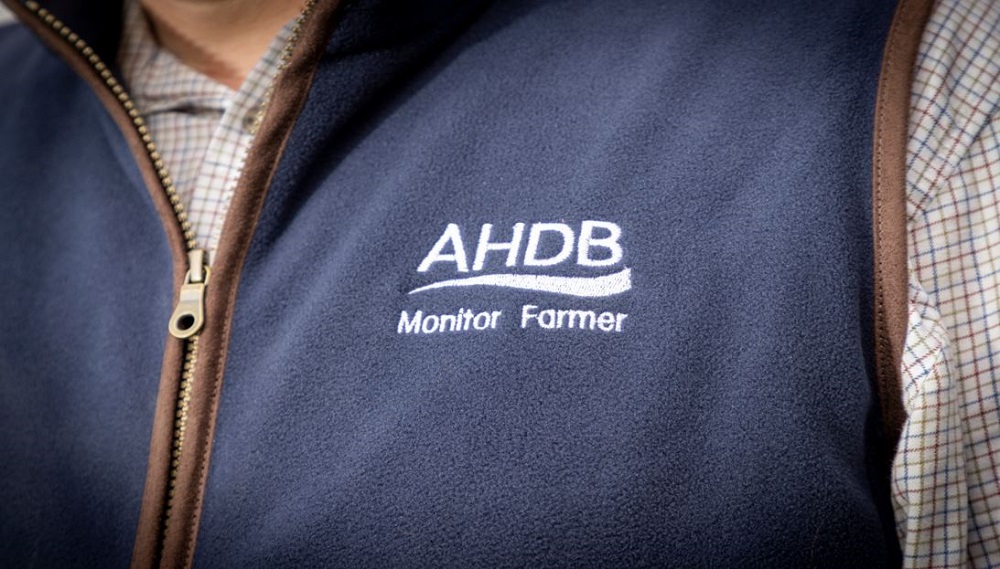
AHDB needs new monitor farmers in England and Wales – could you be one?
What is a Monitor Farm?
With economic pressures mounting, including the end of the Basic Payment Scheme this year, finding new ways to improve performance and profitability is more important than ever for farmers. One way to do this is to pool knowledge with other, similar farming enterprises.
AHDB’s Monitor Farm programme brings together groups of like-minded farmers who wish to improve their businesses by sharing performance information and best practice around a nationwide network of host farms.
The concept originated in New Zealand, was adopted in Scotland in 2003 and rolled out to England, Northern Ireland, and Wales in 2014. The programme has two unique principles: it is a farmer-led, farmer-driven project with business efficiency and benchmarking at the heart of its activity. It takes place on commercial farms, providing a hands-on approach to personal and business development. This makes it attractive to other members of the farming community.
A monitor farmer partners with their local AHDB Knowledge Exchange (KE) manager to host four to six meetings each year. These farmer-led meetings provide the opportunity to find and share challenges and solutions, as well as time away from their own farms and the chance to socialise with their peers – something that is also valuable in terms of mental health, particularly during times of stress. Points towards BASIS and NRoSO professional development schemes can also be claimed by those who attend.
During the three years of being a Monitor Farm, every aspect of the business is scrutinised. Whether looking at soil management or machinery policy, cost implications to the farm business always take centre stage.
With a focus on making real developments in their business management, improving productivity, competitiveness and environmental management, Monitor Farms try out innovative ideas, all with the support of AHDB and guidance from industry experts.
What are the qualities that make a great monitor farmer?
A monitor farmer needs to be:
- Willing to speak openly about their business, disclose information and share how they reach decisions
- Open-minded, interested in innovative ideas and happy to embrace change
- Ambitious – keen to set and achieve personal goals
- Sociable – enjoys meeting people and is happy to host events
What does being a monitor farmer involve?
What a monitor farmer does:
• Works closely with their AHDB KE manager
• Sets up a steering group for the monitor farm
• Undertakes baseline assessments
• Submits figures to Farmbench
• Monitors benchmarked figures with their Arable Business Group (ABG)
• Hosts up to six meetings each year
• Brings specialist advice onto the farm, such as expert speakers and consultants
• Supplies updates on farm progress between meetings
• Sets up actions and follows them up to see real progress
• Adopts an evidence-based approach to change, such as carrying out co-ordinated on-farm trials
• Incorporates all aspects of the farm business, including family aims, succession and diversification options
• Helps their steering group and ABG to continue meetings after the Monitor Farm has ended
• Enjoys the social aspect – the Monitor Farm should be professional but also entertaining
The latest Monitor Farm
The first West Midlands Monitor Farm to be appointed post-pandemic, DW Burton Farms, was launched in November, with a daytime event on the farm at Pattingham, near Wolverhampton.
The farm operates around 2,000 acres of owner-occupied land and farming agreements. Farming on mainly sandy/sandy clay loam, cereals are mainly grown between spring and winter break crops, putting cover crops in where possible.
Local farmers and farm managers were invited to meet farm manager Jack Houghton and Dr Alex Ansell, AHDB’s new Cereals & Oilseeds KE manager. AHDB’s in-house soil guru, Dr Joe Martlew, discussed the results of the soil health scorecard (see The scorecard that unearths a soil’s secrets article in this issue for more details on how this tool has been used at a Monitor Farm). As well as presentations and group activities, attendees took part in a farm walk.
Alex will be supporting Jack over the next three years as he undertakes practical trials guided by his steering committee and reports the results to fellow farmers in the area at the regular networking events.
According to Alex: “It takes a special mix of qualities to be a monitor farmer. Jack is keen to try out new arable farming methods in practical ways – and to share the results with others so that they can adopt successful techniques. Over the next three years he will be hosting regular events where local farmers can learn from his experiences, as well as from each other. I’m really looking forward to working with him and seeing what he achieves.”
In his early thirties, Jack wants to encourage more young people to join the industry.
“I’m often the youngest in the room. That needs to change, so that farming has a future.
“I’m not one for sitting around talking about new ideas – I want to get out and try them. If it goes wrong, it goes wrong – but you always learn something. And if I can share that learning, it’s even more useful. That’s why I’m excited about managing a Monitor Farm. Through Alex and AHDB, I’ve got access to far more knowledge and experience than I could get on my own, as well as the support to try it out and share the results.”
Jack’s ambitions for the next three years are to:
- Stabilise business, securing long-term tenancies and contract farming agreements
- Reduce inorganic inputs and pesticides
- Build organic matter using muck/compost and green matter, putting money from stewardship to use
- Ultimately, produce high-quality, profitable food while being kind to the environment
The first post-launch meeting, on 12 December, examined how to make the most of SFI options. On 6 February, labour and machinery will be reviewed, and in summer 2024 there will be a farm walk.
Alex says that Knowledge Exchange is the backbone of AHDB’s offer to levy payers. “The Engagement – or Knowledge Exchange – team is a key part of the service AHDB provides, facilitating farmer-to-farmer learning, carrying out on-farm research and connecting farmers with the best information and expertise. This is enabled by a network of Strategic Farms, Monitor Farms and Arable Business Groups, together with a wealth of other opportunities for levy payers and advisors. The Engagement team is also a key conduit between levy payers and the rest of AHDB, ensuring that there is a two-way exchange of information feeding into everything that we do.”
Could you be a monitor farmer? Find out more and apply on our website. You can also hear from Jack and Alex on our Monitor farm podcast.


-
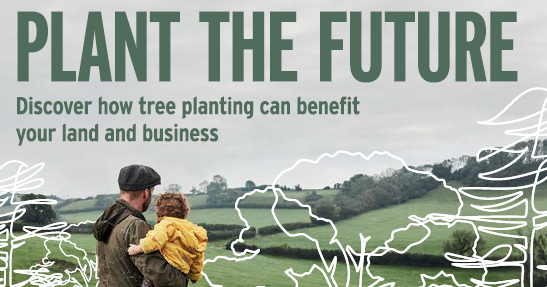
Farmers unite over tree planting.
Planting trees in the right place at the right time can bring significant benefits to your farm including generating additional income through activities such as harvesting trees for timber, producing wood for fuel and other wood products, selling carbon units, and designing woodland for recreation and leisure use.
Andy Gray, who farms at Elston Farm, Devon, began planting trees in March 2021 to see how they might benefit his soil and livestock. A commercial beef farmer with 67ha, he supplies meat for the catering industry, and has adopted regenerative farming practices to try and improve soil health and productivity.
He has planted a mixture of trees in rows, so that he can easily access the land with machinery and grazes the livestock around them. In this way they provide shelter and natural forage, while boosting farm diversity and soil health through living roots and carbon sequestration.
“Grazed grassland and selected trees can work together in harmony,” he says. “The trees will become the backbone of the farm and at the same time capture carbon, enhance biodiversity and enrich soil health.”
In total, Andy has planted 8,500 trees – and firmly believes it will bring a multitude of productivity benefits while aligning with his regenerative farming practices. It also fits in with his business model – as chairman of M C Kelly, he supplies meat to hotels and restaurants across the South West and to the public via The Farm Wilder and The Meat Box Company. And consumers are increasingly interested in natural, environmentally-friendly farming practices that can help the industry to reach net zero.
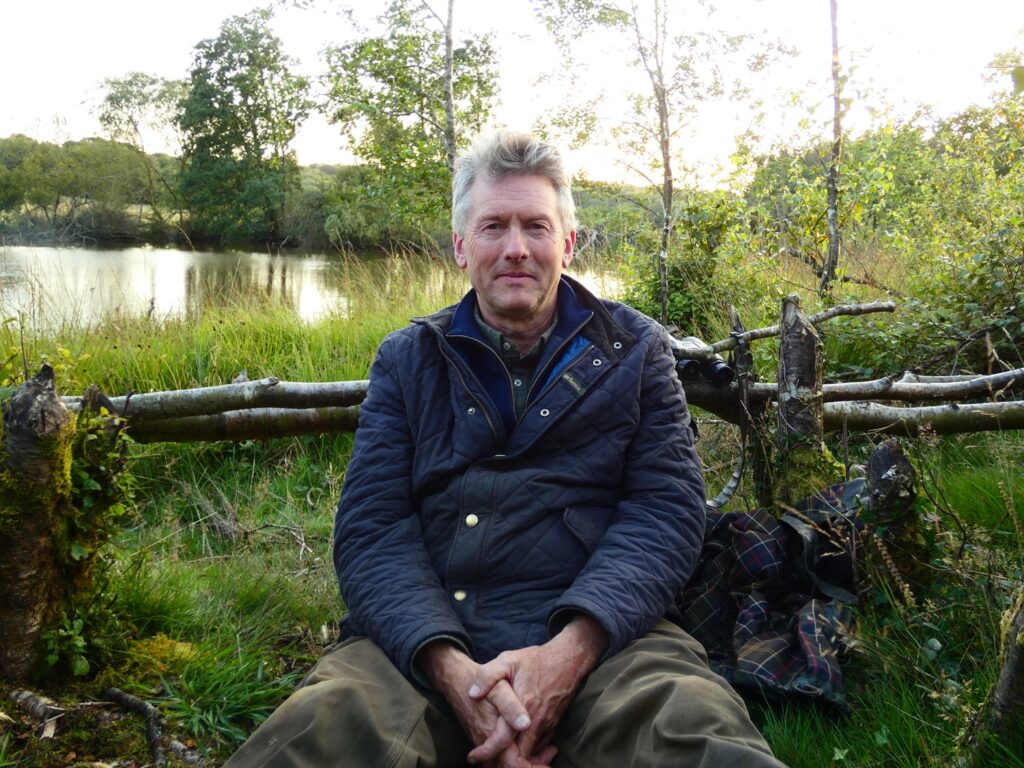
Andy Gray from Elston Farm The England Woodland Creation Offer is a national flagship grant scheme administered by the Forestry Commission. With expert support from Woodland Creation Officers, it encourages the creation and long-term management of woodland on areas as small as one hectare. It covers standard capital costs up to £10,200/ha, with stackable payments of up to £8,000/ha for projects that support wider benefits to society, nature recovery, and the environment.
There are also regional grants available through Woodland Creation Partners, located across England they offer a range of highly competitive grants and funding.
Michael Flesher at Ghyll House Farm had wanted to plant trees more than 20 years ago, but the process and paperwork at the time made it feel far too challenging. But thanks to the wonderful support from The White Rose Forest team, Michael and his neighbour Jill have successfully planted trees in an area of less productive land.
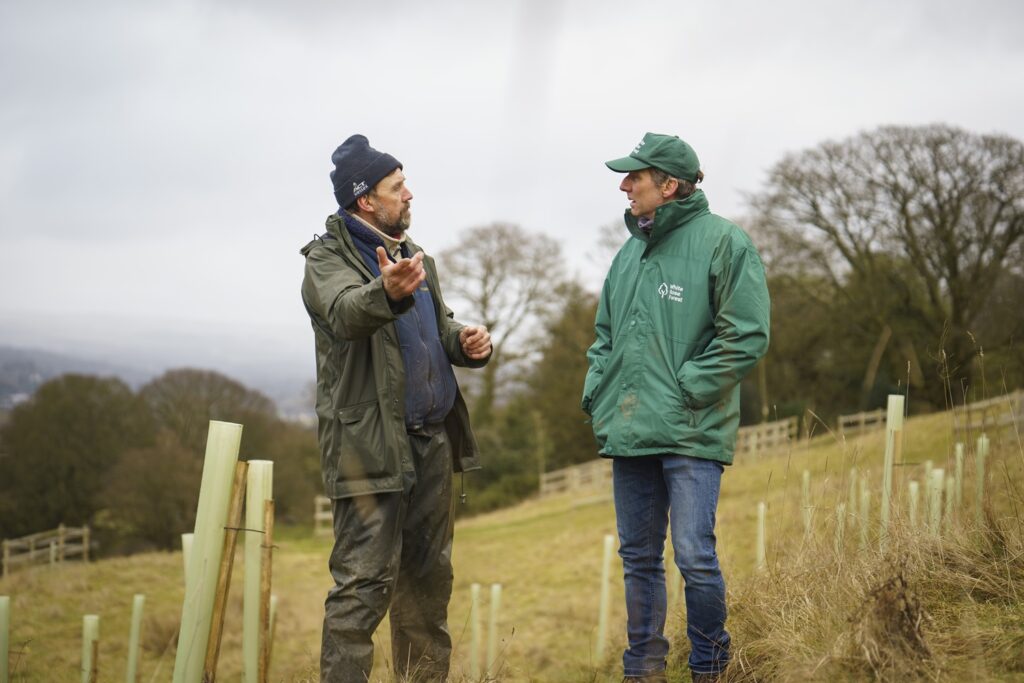
Picture Credit – White Rose Forest Shoot The woodland creation team can support on all aspects of planning, the application process, design and support with the approvals process.
“The White Rose Forest have been tremendous in leading us forward and giving us a vision,” says Michael “the key to the progress of all of this is them taking the weight of my back”.
Both the England Woodland Creation Offer and Defra’s Woodland Creation Partners provide expert support and advice. Armed with local knowledge and expertise, they can advise on application processes, woodland design, tree selection, planting and maintenance.
To find out more about Defra’s woodland creation grants and the support available visit www.gov.uk/woodland-creation.


-
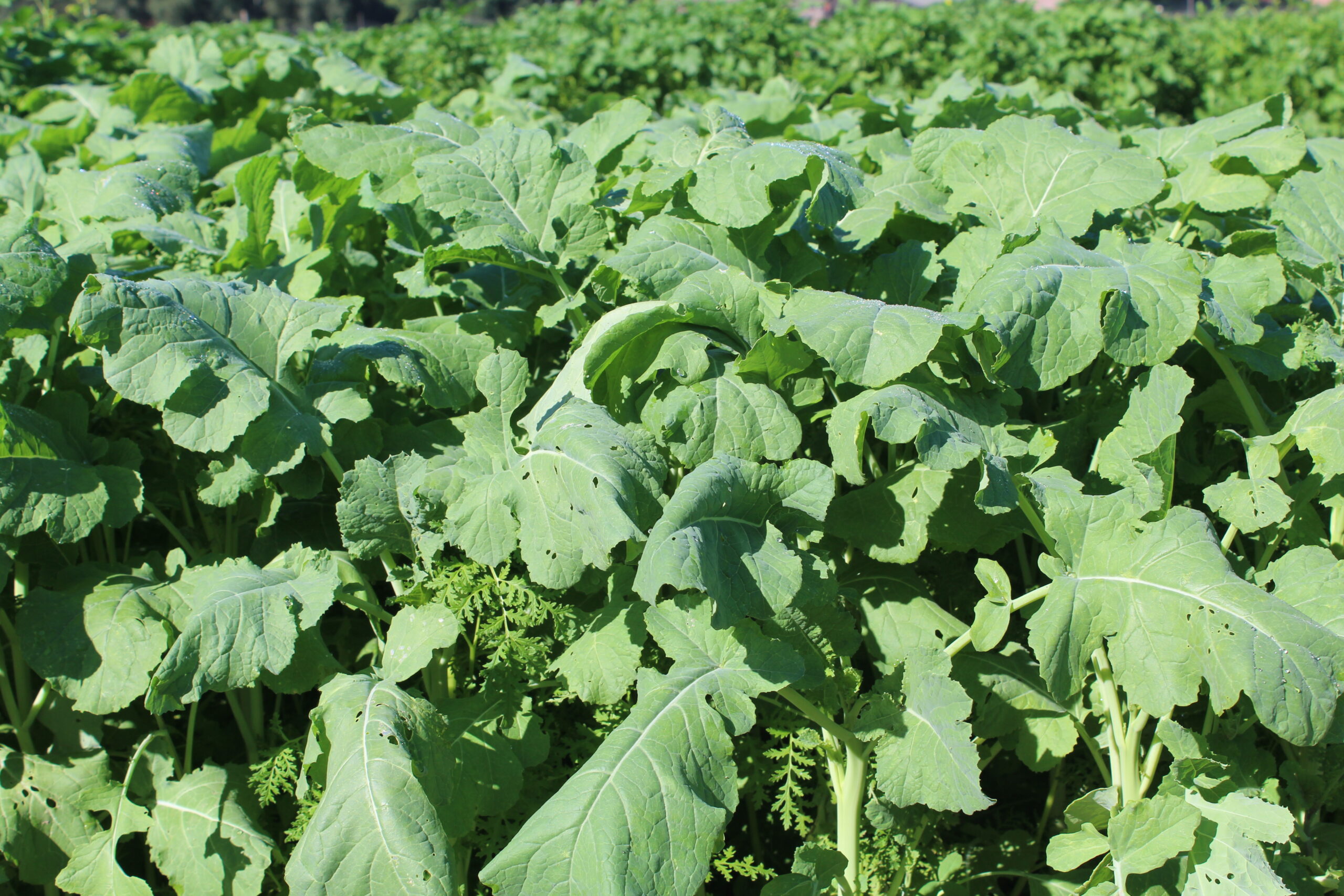
Putting science behind cover crop varieties
When it comes to growing cash crops, most farmers will spend plenty of time choosing the right varieties with traits that suit a farm’s physical and management characteristics.
However, many growers are sold cover crops by species, with little or no additional information to demonstrate their suitability for different enterprises, soils or rotations.
As one of a handful of global cover crop and soil health plant breeders, RAGT believes this needs to adapt and change to help growers get the most from their investment and better meet the needs of agricultural policy, while optimising opportunities within environmental schemes.
RAGT has been deeply involved in the cover crop/soil health sector for many years. “There are not many other plant breeders in the world with such an extensive portfolio,” says David Ramdhian, RAGT UK’s head of forage and soil health crops.
“We are currently involved with lots of partners within and beyond the RAGT group, offering more than 47 species in the UK last year.
“But, while the concept is more accepted than a few years ago, there is still an element of muck and mystery about soil health plants.
“Our breeding programme is putting much-needed science into the sector, so we can target the right varieties at specific problems in the field to deliver the best results.”
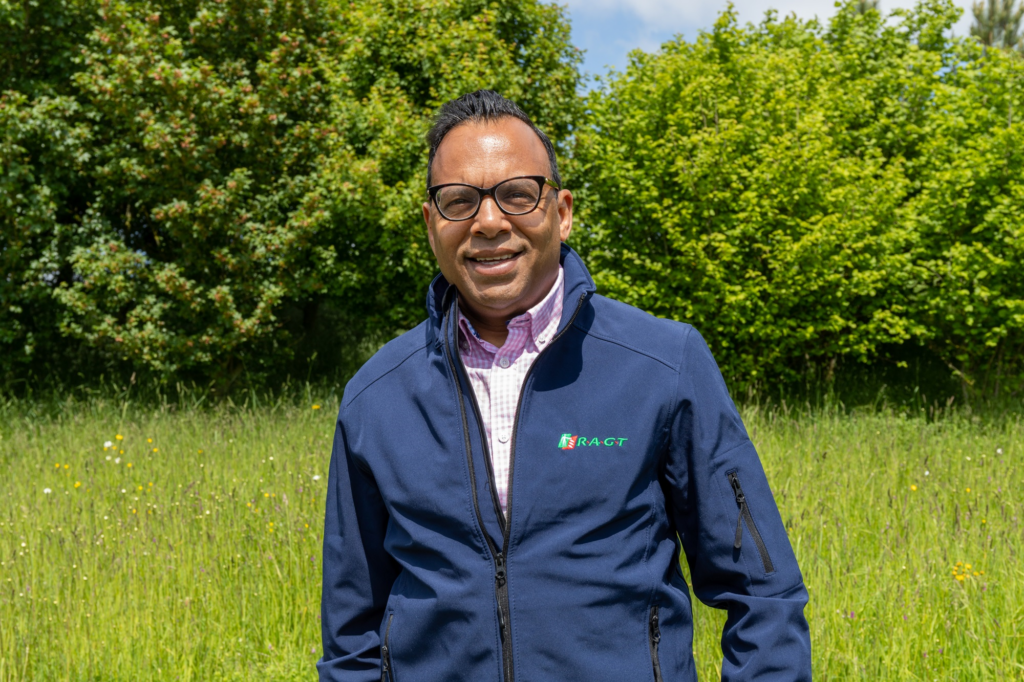
David Ramdhian RAGT has established partnerships with ADAS, Harper Adams University and the University of Wageningen in Holland to delve further into the science and has also embarked on a major European joint venture with Bayer looking at carbon capture.
The company also runs demonstration trials at Ickleton in Cambridgeshire. Taking part in Agri Web Media’s Covering Soils event was an obvious next step.
“We are delighted to be working alongside host farmer Clive Bailye, who is a real cover crop enthusiast,” says David. “The event was a great opportunity to provide new growers with technical information on various cover crop blends and straights from RAGT’s breeding programme.”
At the event Peter-Jan Jongenelen, RAGT’s international cover crop product manager, showed visitors some key products from RAGT’s breeding programme, which includes brassica cover crops, such as mustards, radishes and rocket lettuce, as well as phacelia, legumes and black oats.
“Some of our soil health varieties are used to improve soil structure and to produce a healthier community of soil microorganisms to help provide the ideal growing medium for cash crops,” Peter-Jan said.
“There is also an increasing focus to manage and suppress soil-borne crop diseases caused by nematodes and soil-borne fungi across a range of rotations. We are also looking to control pests like wireworm and leatherjackets.
“Whatever the aim, we are all the time choosing varieties to ensure we don’t introduce a potential new weed species or disease into the rotation.”
Many cover crops play additional roles in capturing residual nitrogen and other nutrients, eventually making them available to the following cash crop.
Several straight plant stands and a range of mixtures, all sown immediately after oilseed rape, were demonstrated at the event.
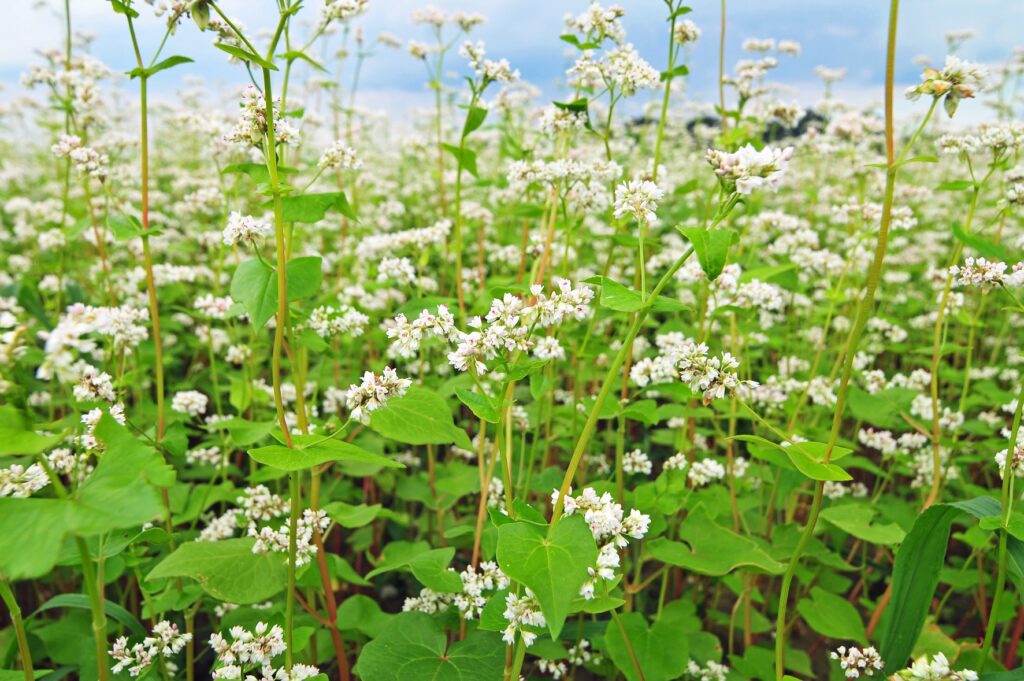
Buckwheat RGT N Fix Blend
This nutrient-capturing soil improver includes a late-flowering Ethiopian mustard to prevent seed set, potentially important where other brassicas feature in the rotation.
- Added berseem clover fixes and captures nitrogen and P and K
- Very deep rooting, good restructuring capabilities
- Frost susceptible so suits no-till systems.
RGT Fungi Redux (nematicide radish, berseem clover, phacelia)
Fungi Redux was created to reduce sclerotinia. In trials with Warwick Crop Centre, this mix has had a good reducing effect on sclerotinia in carrot rotations.
- Also very effective at capturing P and K.
RGT Factotum (phacelia), RGT Dracula (oilseed radish) and berseem clover
Contains phacelia, radish and berseem clover, featuring a range of rooting depths to condition and loosen soils as well as fixing nutrients.
- Frost susceptible, so facilitates destruction.
RGT NemaRedux
- Suppresses potato cyst nematodes and beet cyst nematodes as well as free-living nematodes that affect many cash crops, including wheat. Growing roots attract nematodes out of soil and block their life cycle.
- Clubroot-resistant oilseed radish plus rocket lettuce
- Eliminates need for biofumigation.
RGT Biofum Autumn
Ethiopian mustard, oilseed radish and forage rape mix, drilled in September and incorporated ahead of the cash crop in March for biofumigation.
- All inclusions are winter hardy
- Apply small amount of fertiliser if permitted to boost glucosinolate levels.
Amelia and RGT Brons
A very late-flowering brown mustard for longevity to optimise fumigation potential, plus vetch to provide nitrogen to aid establishment and early growth.
RGT Cebelica
Later flowering, high-biomass buckwheat which is under test for repellent effects against leatherjackets and wireworm.



-

Covering Soils – Event Summary
We ran the first in a series of Direct Driller days around cover crops, SFI options, agronomy decisions and compaction on the 21st September at TWB Farms in Staffordshire.
It was a great day, with great local food provided by Untamed Grill. We plan to continue these series of days, some based on the trials we planted on this day, others based on different topics in different parts of the country.
For all those who weren’t able to attend this first event, we have included write ups of each of the sessions and you can also watch all the videos from the day.
Covering Soils Day – Highlights
Covering Soils Event – UK-Anglo American talk Fertiliser
Covering Soils Day – RAGT talk Cover Crops
Covering Soils Day – SFI Options and Soil Health
Grange Machinery at Covering Soils 2023
Horsch Machinery at Covering Soils 2023
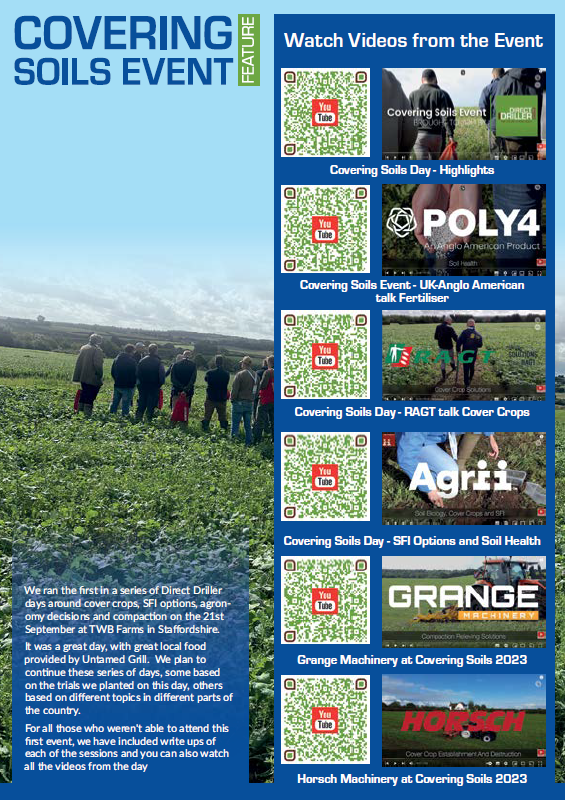
-

How understanding more about organic matter and soil carbon can boost productivity and payments
Understanding more about organic matter and soil carbon can help growers improve soil health, get more from crop nutrition inputs and build greater overall resilience into their crop production, believes Agrii agronomist Will Francis.
“So many aspects of profitable crop production are affected by the condition of your soil that it’s worth spending a bit of time getting to know the type of soil you have, what its organic content is and what management you can focus on to get it working to its full potential,” he says.
“Organic matter is basically plant and animal residues at various stages of decomposition with three known pools in the soil depending how far this process has proceeded.
“The first is ‘active’ organic matter which is made up of recent organic matter inputs and soil organisms such as those from previous crop residues and is not very decomposed such that you can still tell what it is made of.
“Next is ‘slow’ organic matter which refers to organic compounds derived from the active pool which are slightly more decomposed and identifying the origin of these inputs/organisms is more difficult.
“Finally, ‘stable’ means fully decomposed organic matter where you can no longer identify the origin inputs and organisms as is the case with humus.”
Soils with higher levels of organic matter are generally seen as healthier and more resilient with several benefits resulting from this, he says.
“High organic matter soils tend to store nutrients better and act like a sponge when it comes to water retention as well providing the essential energy for soil biology which is responsible for the decomposition process converting carbon from ‘active’ to ‘stable’ organic matter.
“During this process, the soil biology secretes the sticky substance Glomalin which binds soil particles together, aggregation, and this also improves overall soil structure which, in turn, facilitates greater aeration and water infiltration through the soil profile.”
Improving carbon use efficiency and C:N ratio
The soil microflora also feeds on the carbon from the residues/organisms as the organic matter decomposes and the efficiency of this dictates what the overall carbon use efficiency (CUE) of the soil is, Will Francis explains.
“CUE is the percentage of carbon consumed that is used to make biomass. The higher the number, the more carbon has gone into the soil and the less into the air as CO2.

“It is an important factor when building soil organic matter and soil health and like nitrogen use efficiency (NUE), high CUE can lead to lower emissions and a faster increase in soil organic matter.
“Soils with a higher proportion of larger, more recalcitrant molecules, such as those found in straw for example, have a lower CUE with fungi tending to favour these types of molecules in the decomposition process.
“Simpler molecules with a lower carbon to nitrogen ratio have a correspondingly higher CUE with bacteria more active on these easier to digest molecules. In addition, some microbes are more efficient at decomposing than others and therefore contribute to a higher CUE.
“By considering carbon use efficiency and the carbon to nitrogen ratio (C:N) of crop inputs and their effect on organic matter, growers can also influence the microbial makeup of the soil, particularly the fungi:bacteria ratio and this can have a significant impact on the profitability of crops.

“The C:N ratio is also important for managing NUE, which is a key factor in economic productivity and crop performance and a key consideration when checking soil sample results and deciding on the most appropriate inputs for nutrient management, such as cover crop species, organic amendments and fertilisers.
“The ideal C:N ratio from a soil test is around 12:1, but this differs from the ideal C:N ratio for inputs, as not all the carbon will remain in the soil.”
Measuring soil carbon for revenue generation
In the current production climate, there are other benefits to understanding more about soil organic matter and carbon content, he says.
“Soil organic carbon is different from organic matter and it is this which carbon markets tend to look when evaluating payments.
“Organic carbon is a measurable component of organic matter and it usually assumed to be 50-58% of total organic matter with the other 42-50% deemed to consist of other organic compounds such as hydrogen, oxygen and nitrogen.
“Carbon markets tend to look at the amount of organic carbon in soils in tonnes per hectare (t/ha) to a defined soil depth, usually 0-30cm, 30-60cm and 60cm depths, so it is important to check guidelines with a recognised market before undertaking samples.
Soil carbon tends to be analysed most commonly using the Dumas method which is favoured by laboratories due to its improved accuracy, he adds.
“The sampling strategy and number of samples taken needs to align with the carbon scheme being joined and this will depend on factors such as soil type, management practices and the potential for change. Samples will usually need to be geo-referenced.
“Fine dry bulk density measurements also need to be taken using a corer. This cannot be taken using a standard soil auger or trowel in the field and remember, only certain labs offer bulk density tests.”



